Highlights – the overview
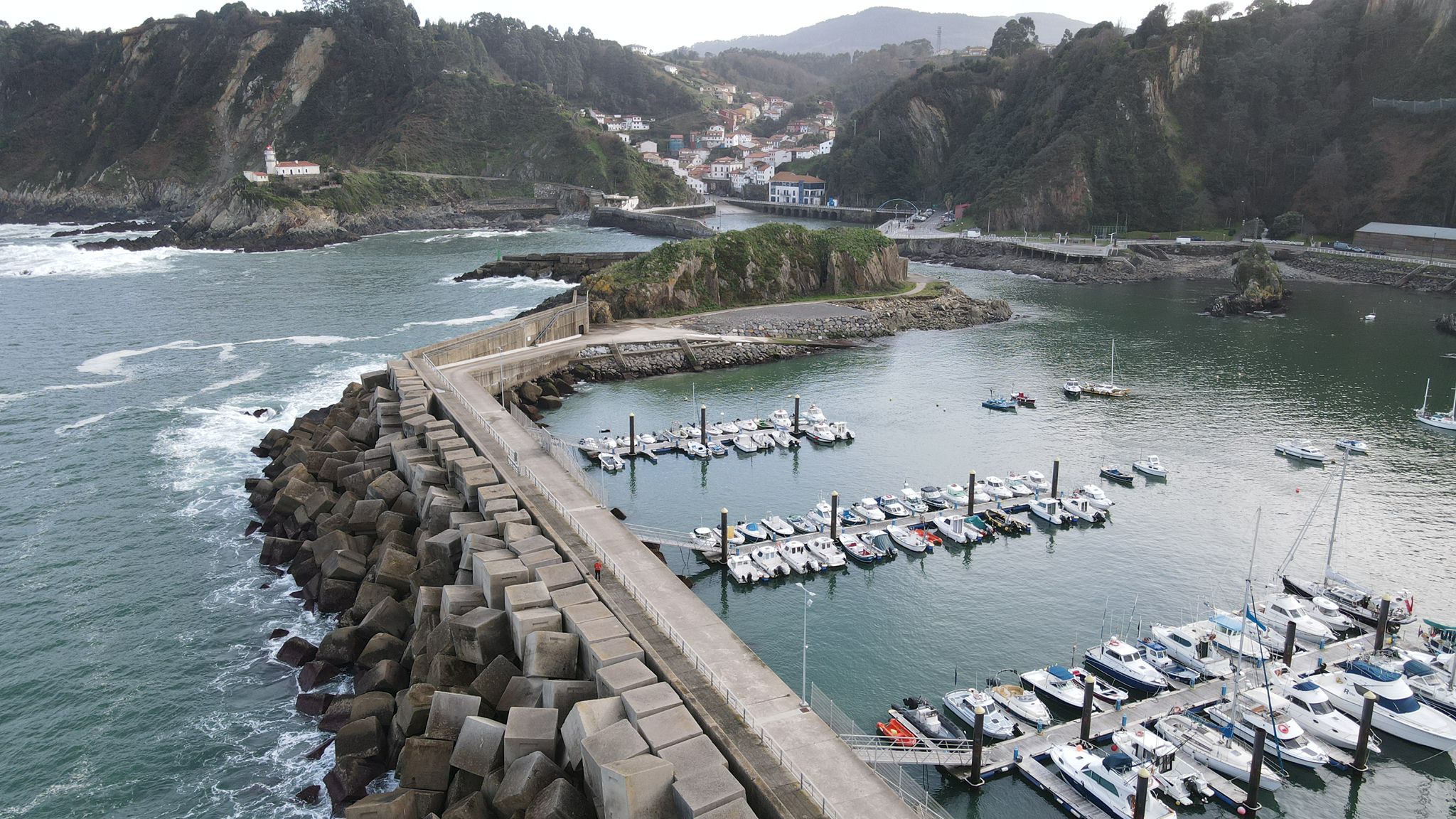
We have left Puerto de Cudillero and we sail to Ribadeo today. The lovely photo here of the town and harbor was taken by our friends on s/v Antares. They left Cudillero a short time after us and they motor a bit faster than we, so they overtake us and take this nice video:
You can see the enormous swell in the video: our mizzen mast, which is about 10 meters, almost disappears behind the wave! Of course, the Antares is in a trough and Dione IV is in a trough as well, so both of us are 5m down and the top of the wave is 5m up.

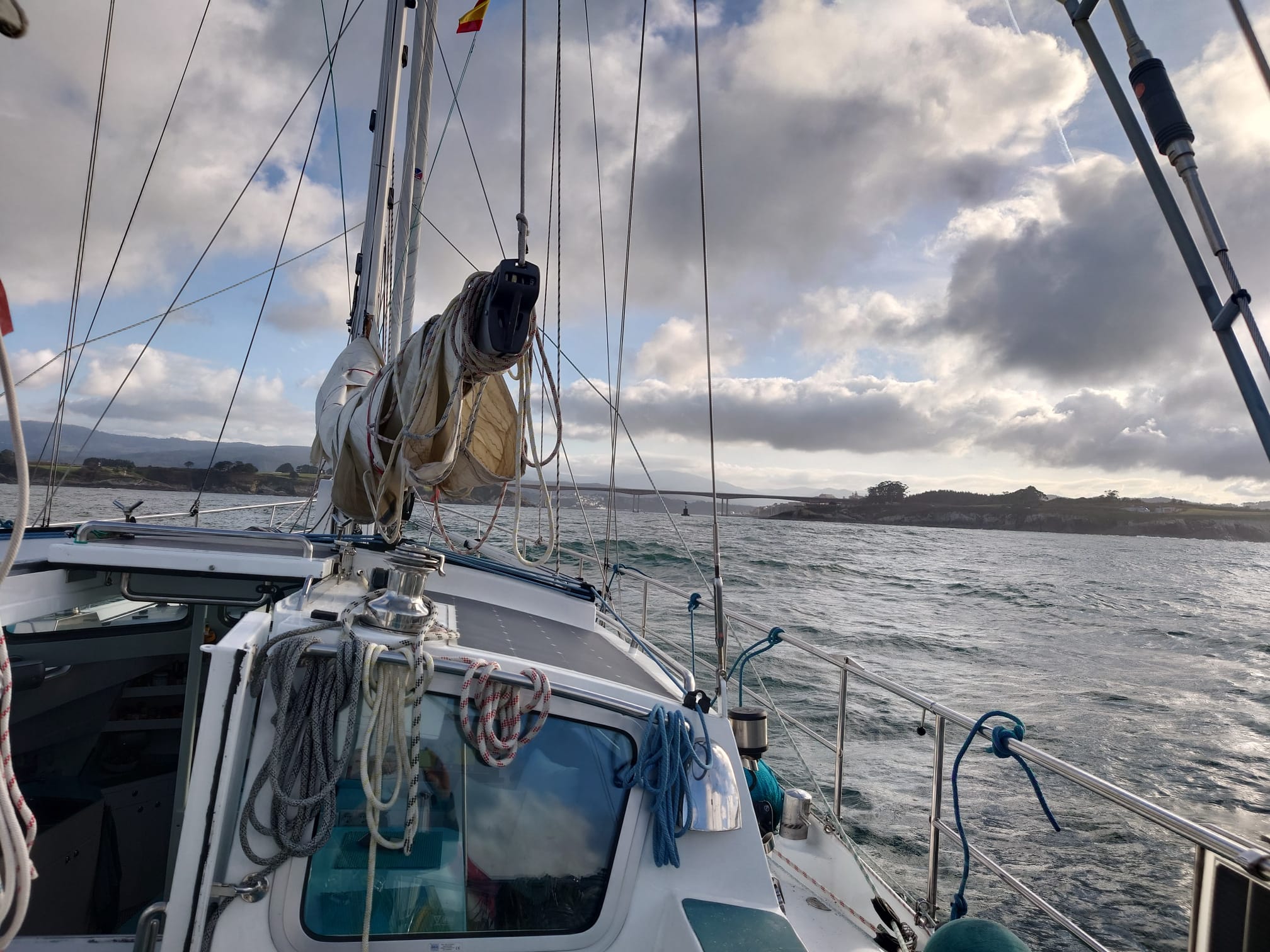
Around 4 o’clock, we enter the Ria de Ribadeo. In Spanish, “Ria” is the estuary of the river. The river itself is called a “Rio”.
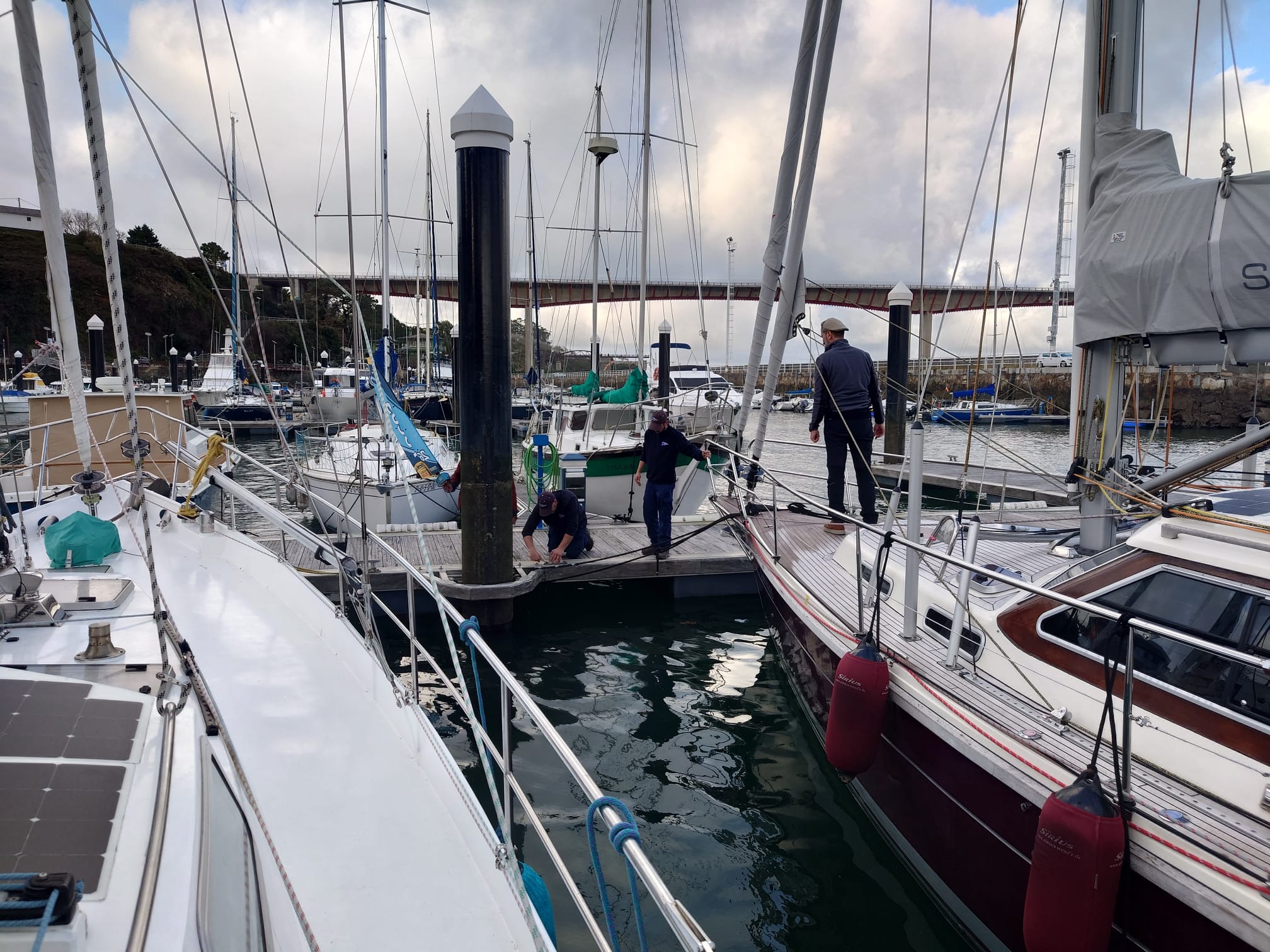
The river is the border between the regions of Asturias and Galicia. So we are now in Galicia! And what a reception! The Antares has already arrived there and 2 guys from the marina help with the lines! What a warm welcome! Ingo and Marleth invite us for an Austrian “Anlege bier” (anchoring/arrival beer) and we have a lovely evening on Antares 🙂
The following day starts with a gorgeous sunrise! First, it’s time to have a look at our Terrific Teal Coffeemaker. He’s been steaming quite a lot and a thorough vinegar cleaning didn’t help, so Wim takes him apart to have a look. It appears there are some particles stuck in the one-way valve. After cleaning that, he’s fine again!
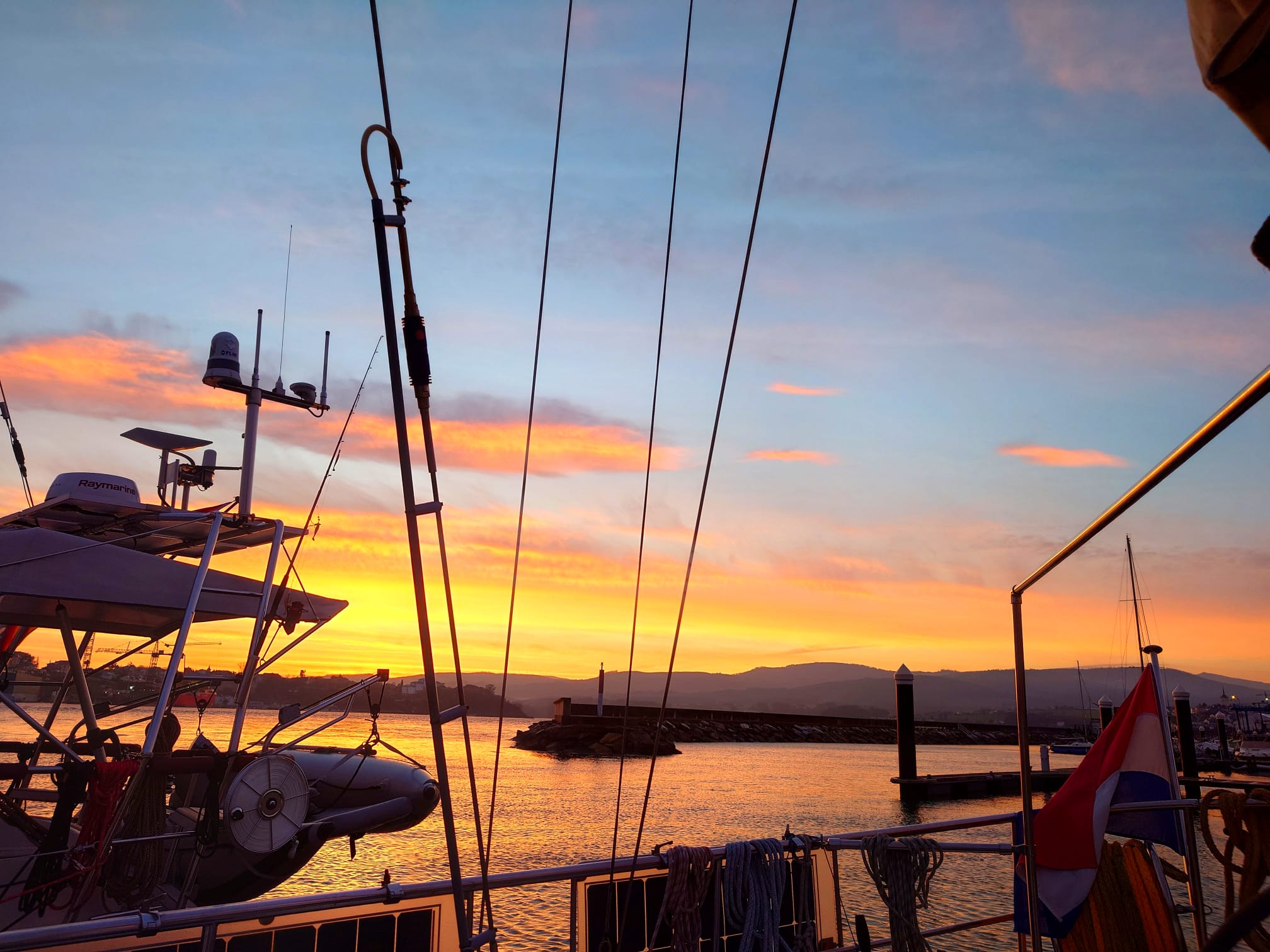
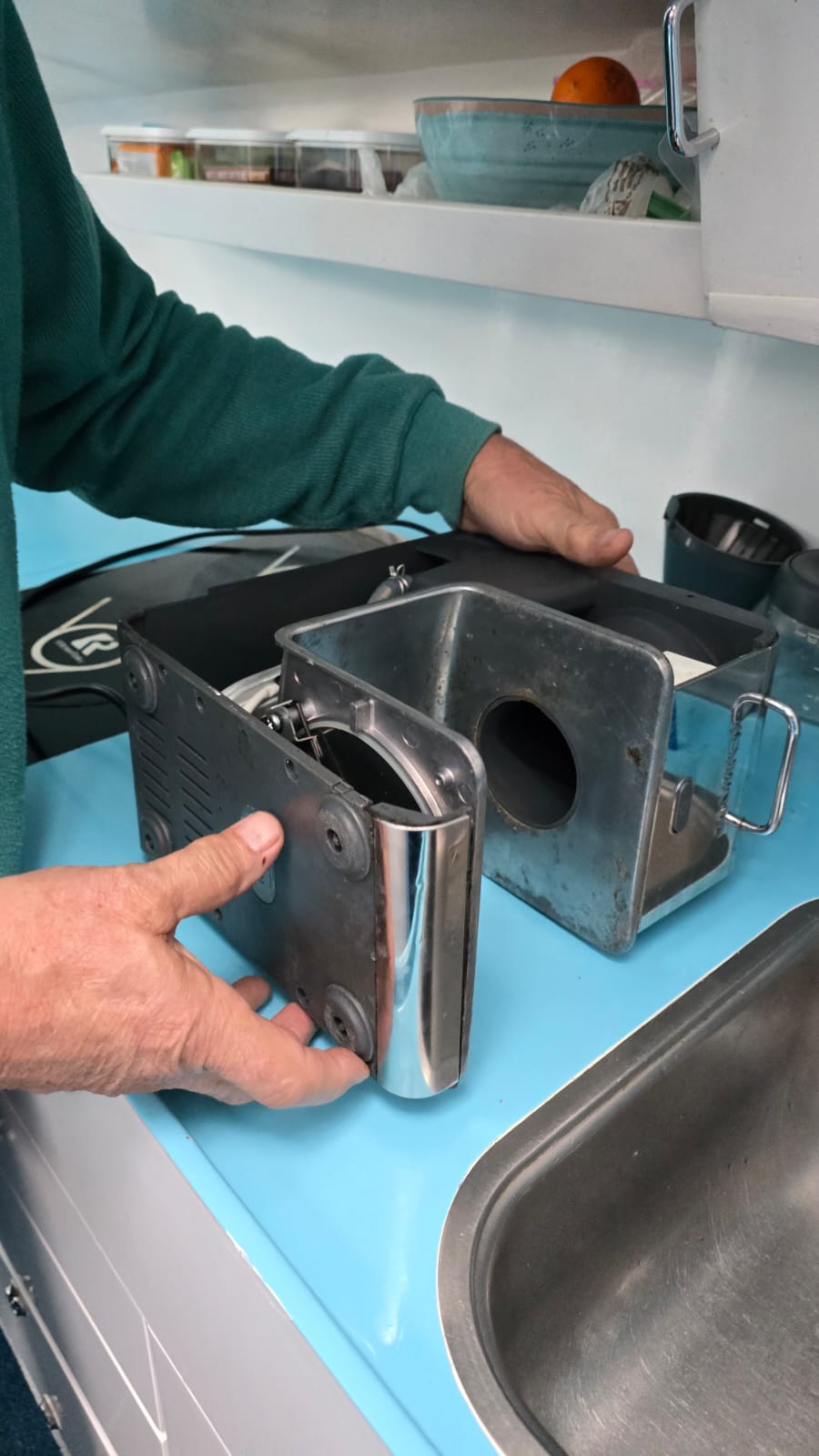
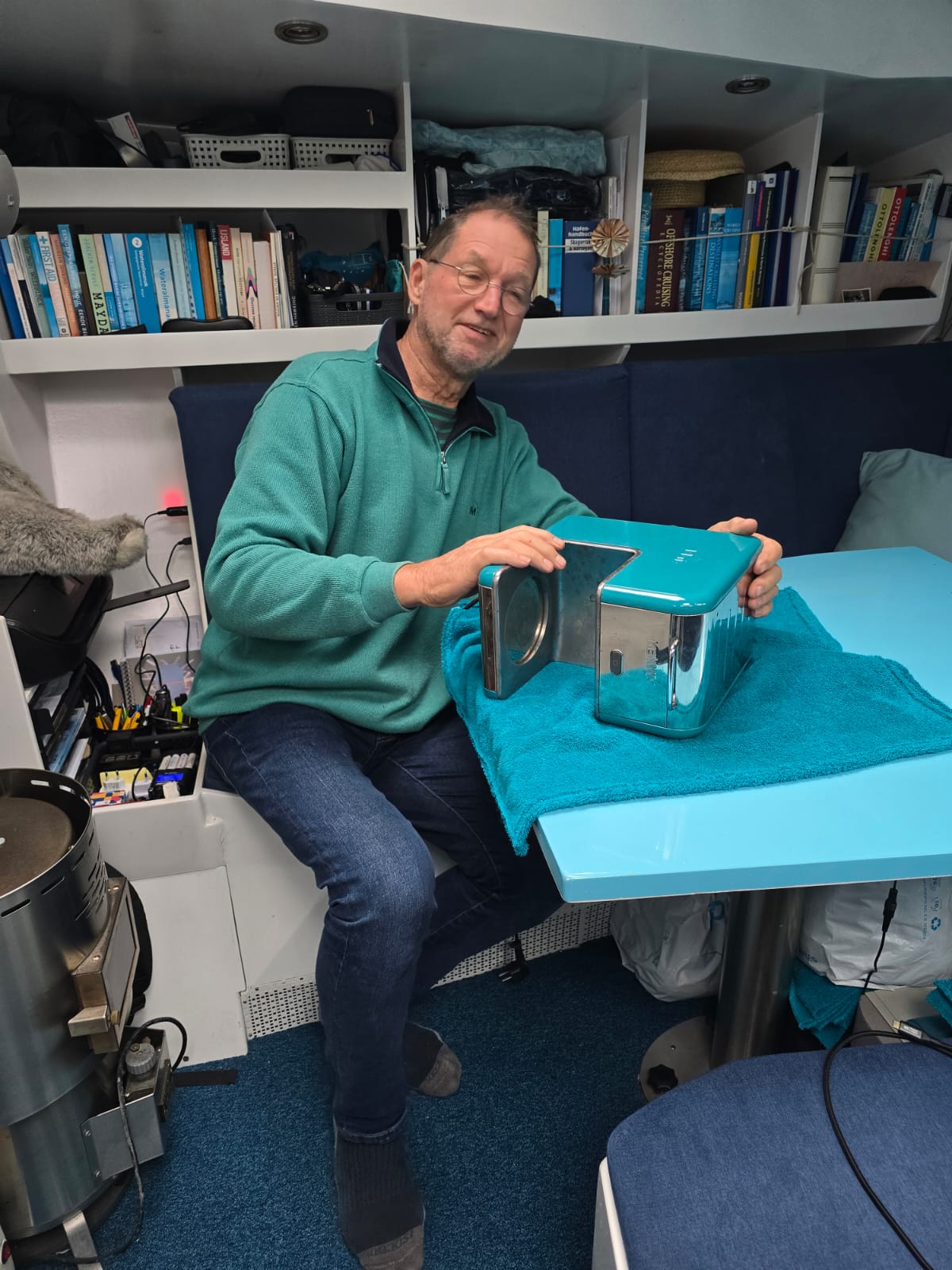
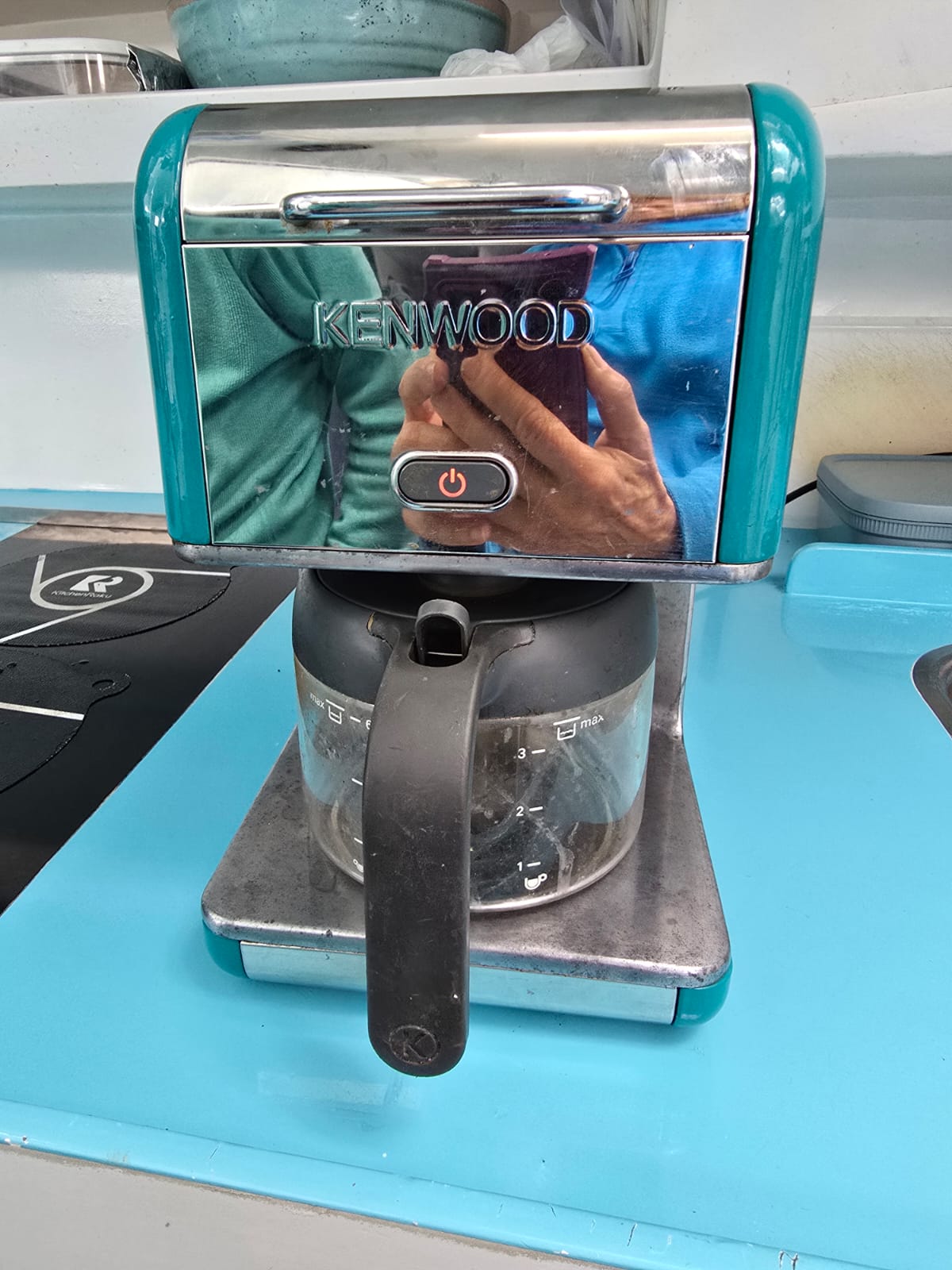
In the afternoon, we take a hike to the lighthouse at the entrance of the estuary with Ingo & Marleth of Antares. Great views!
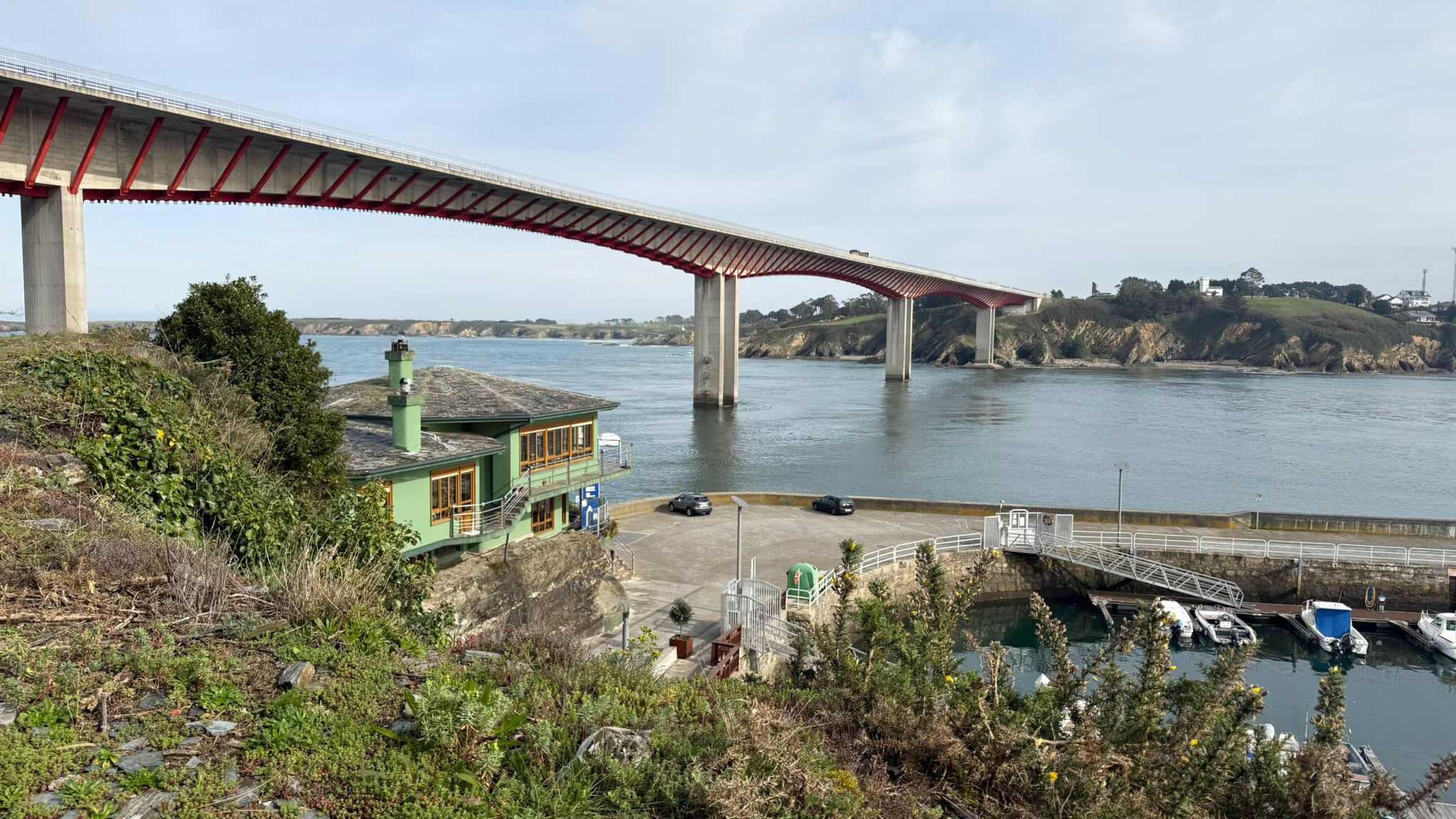
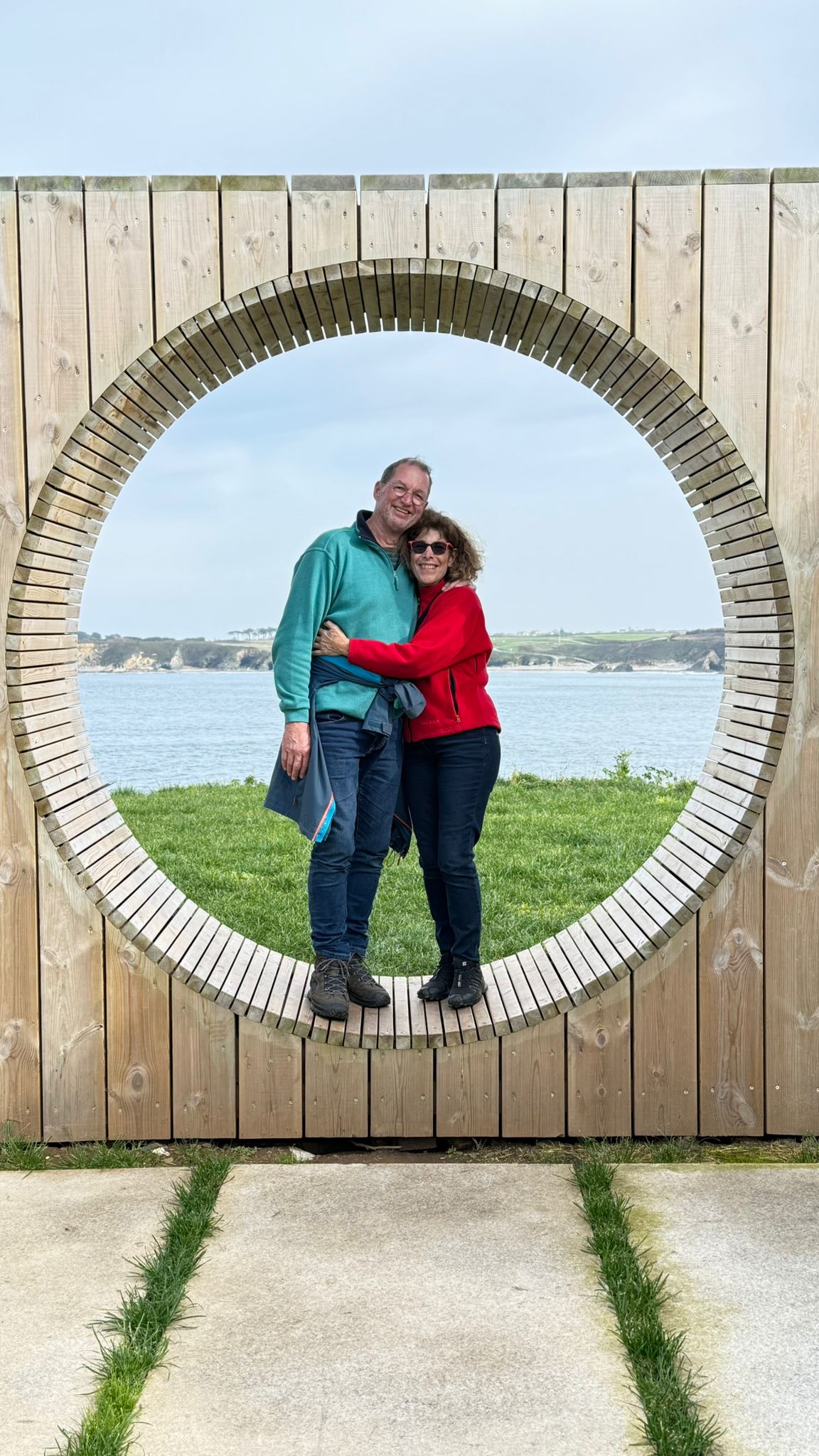
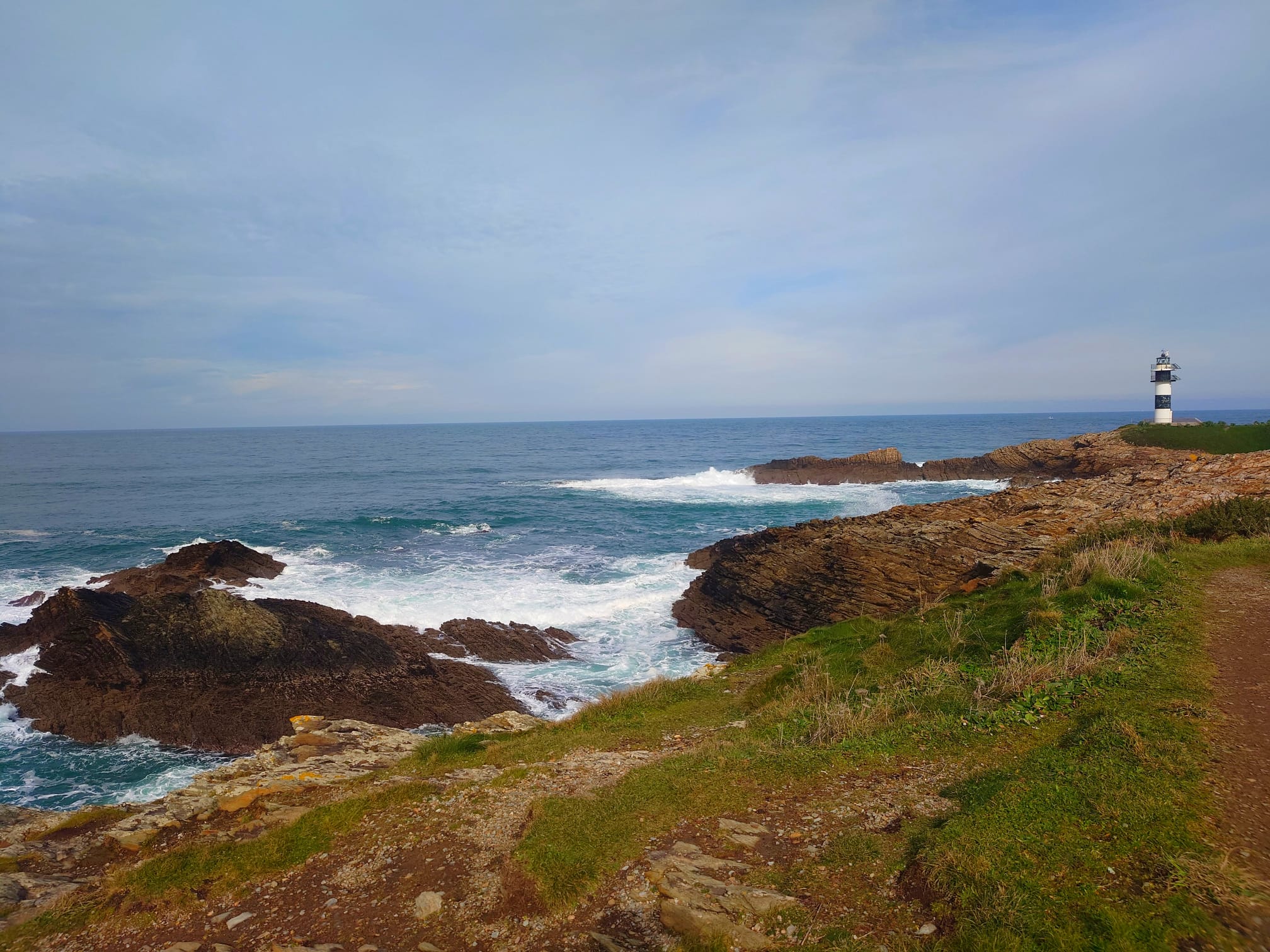
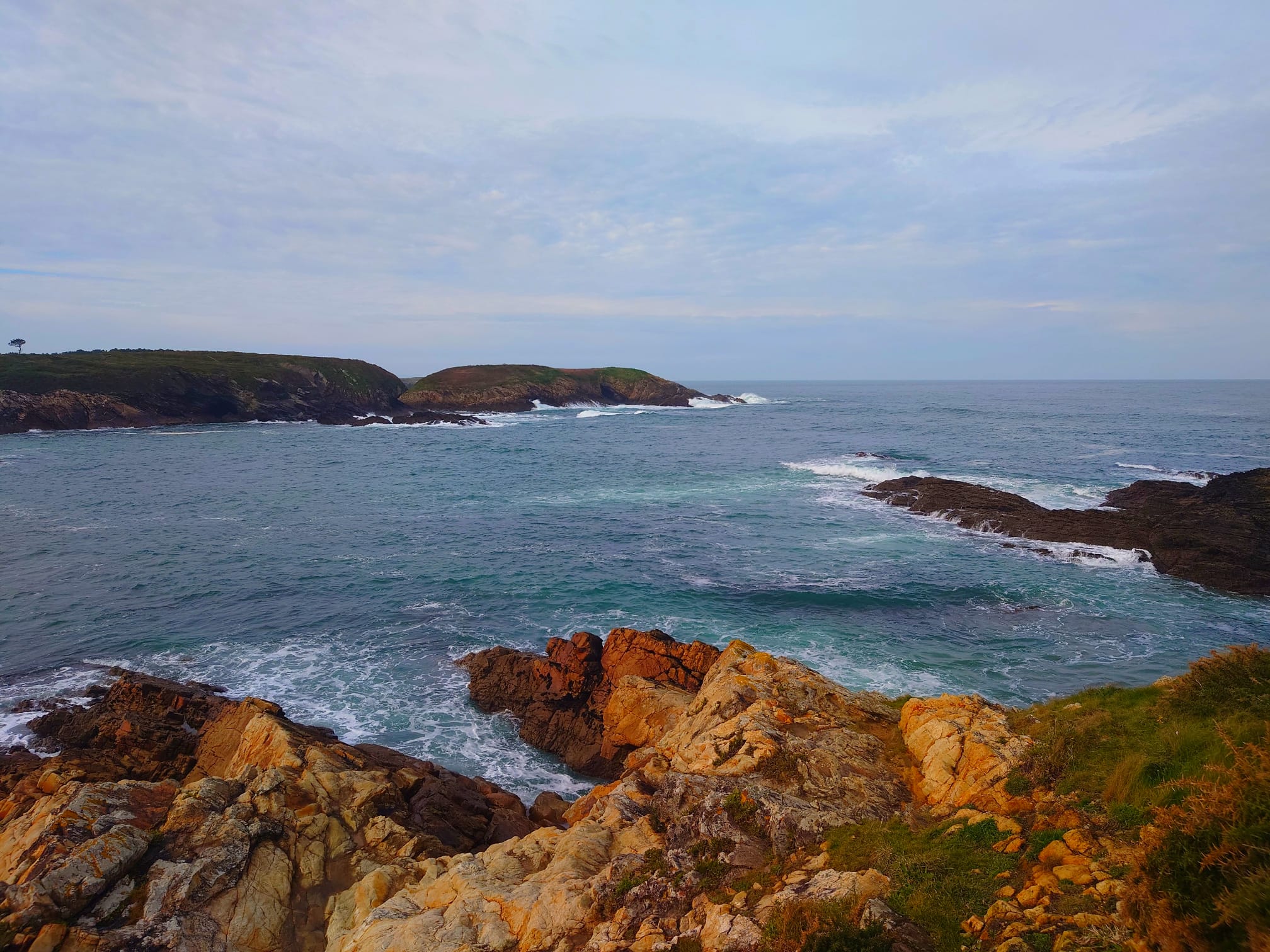
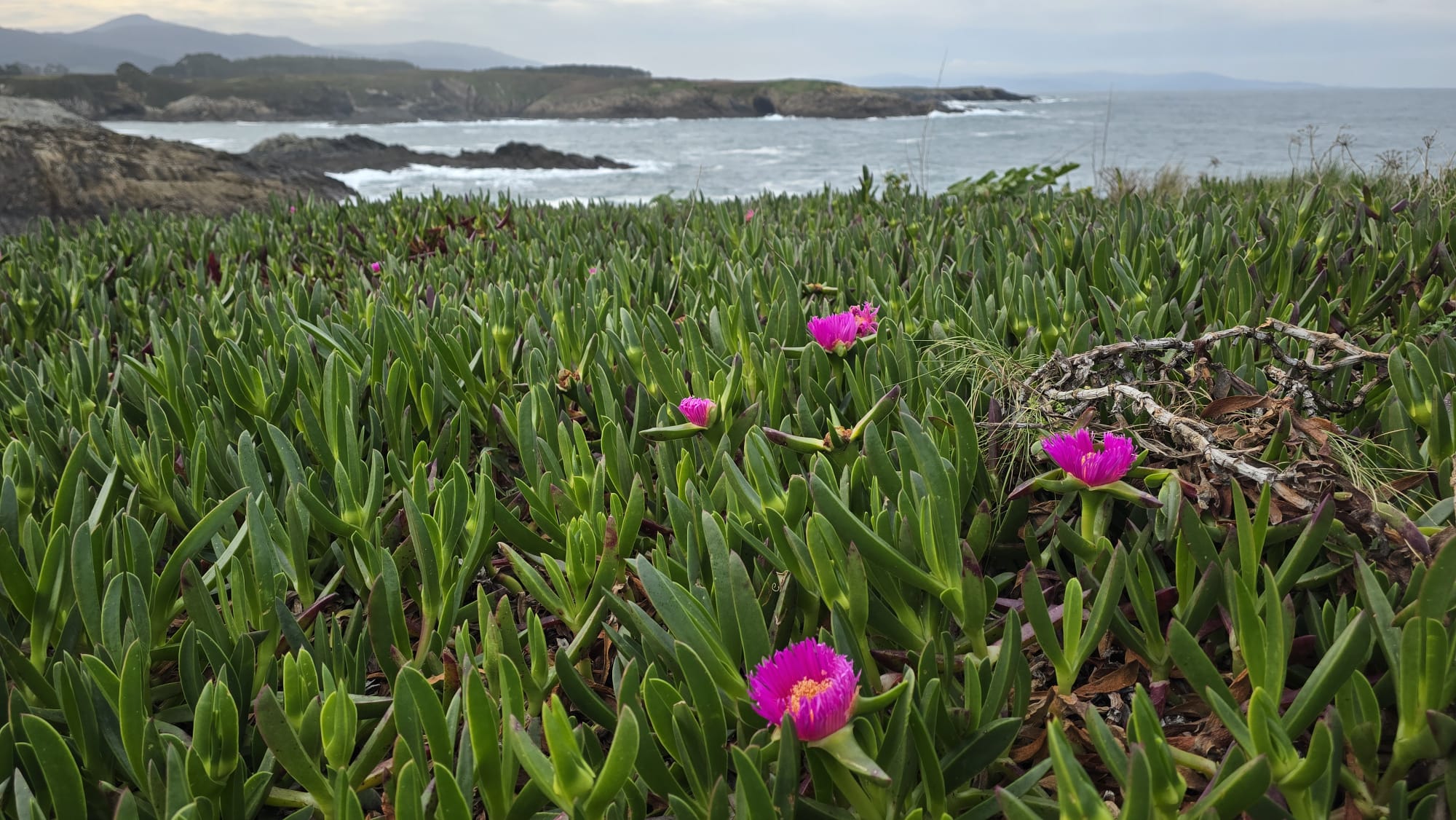
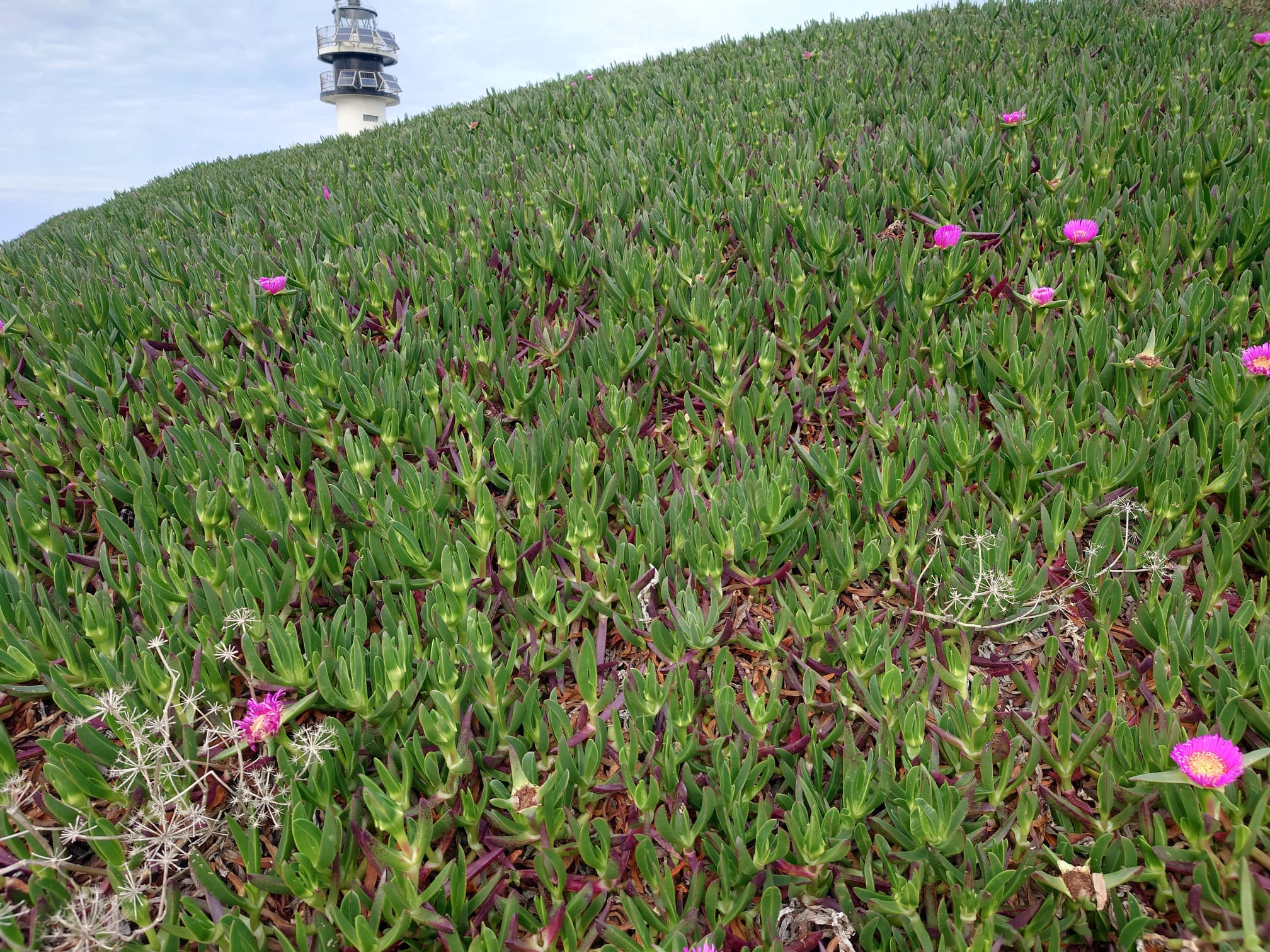
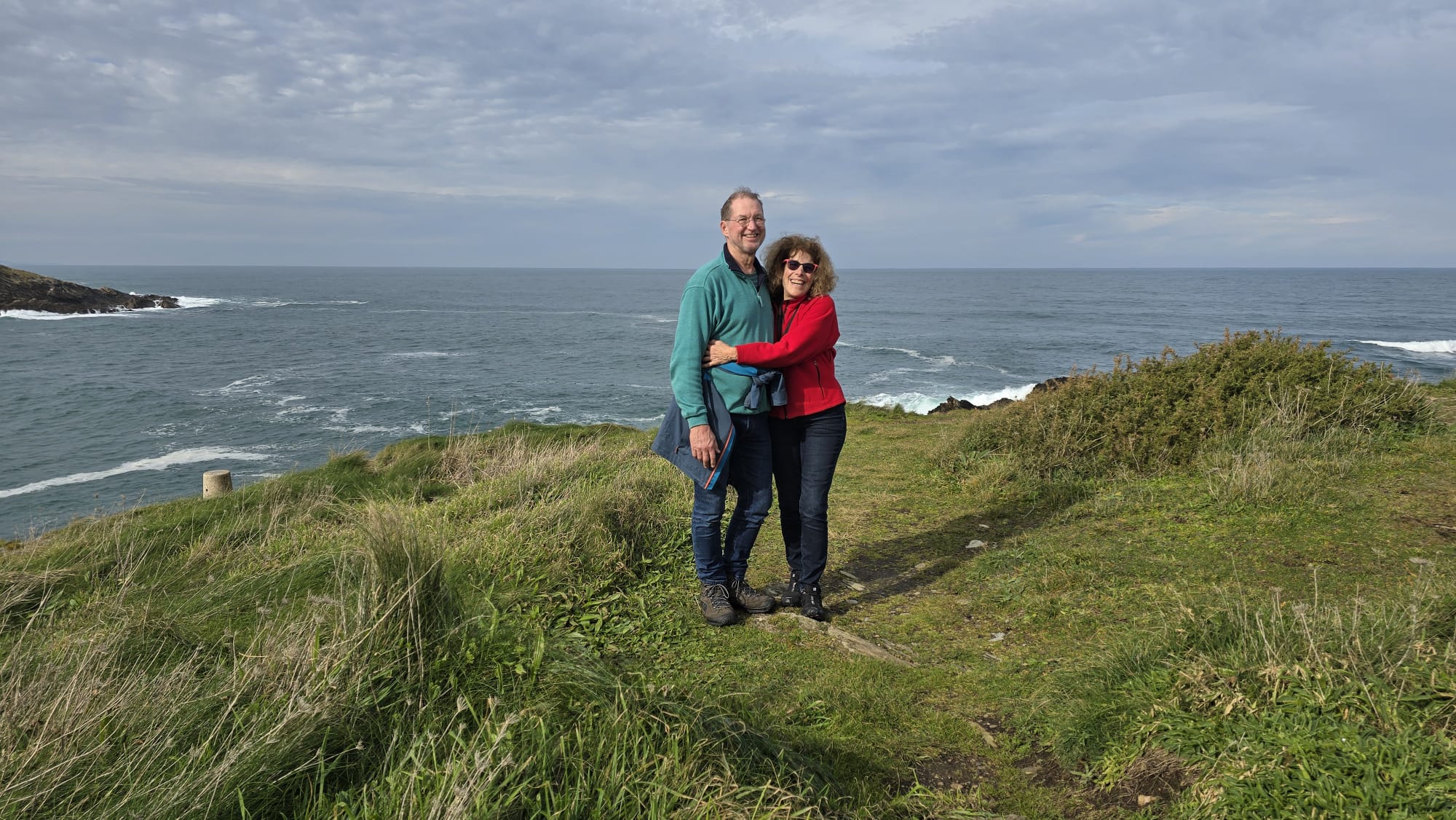
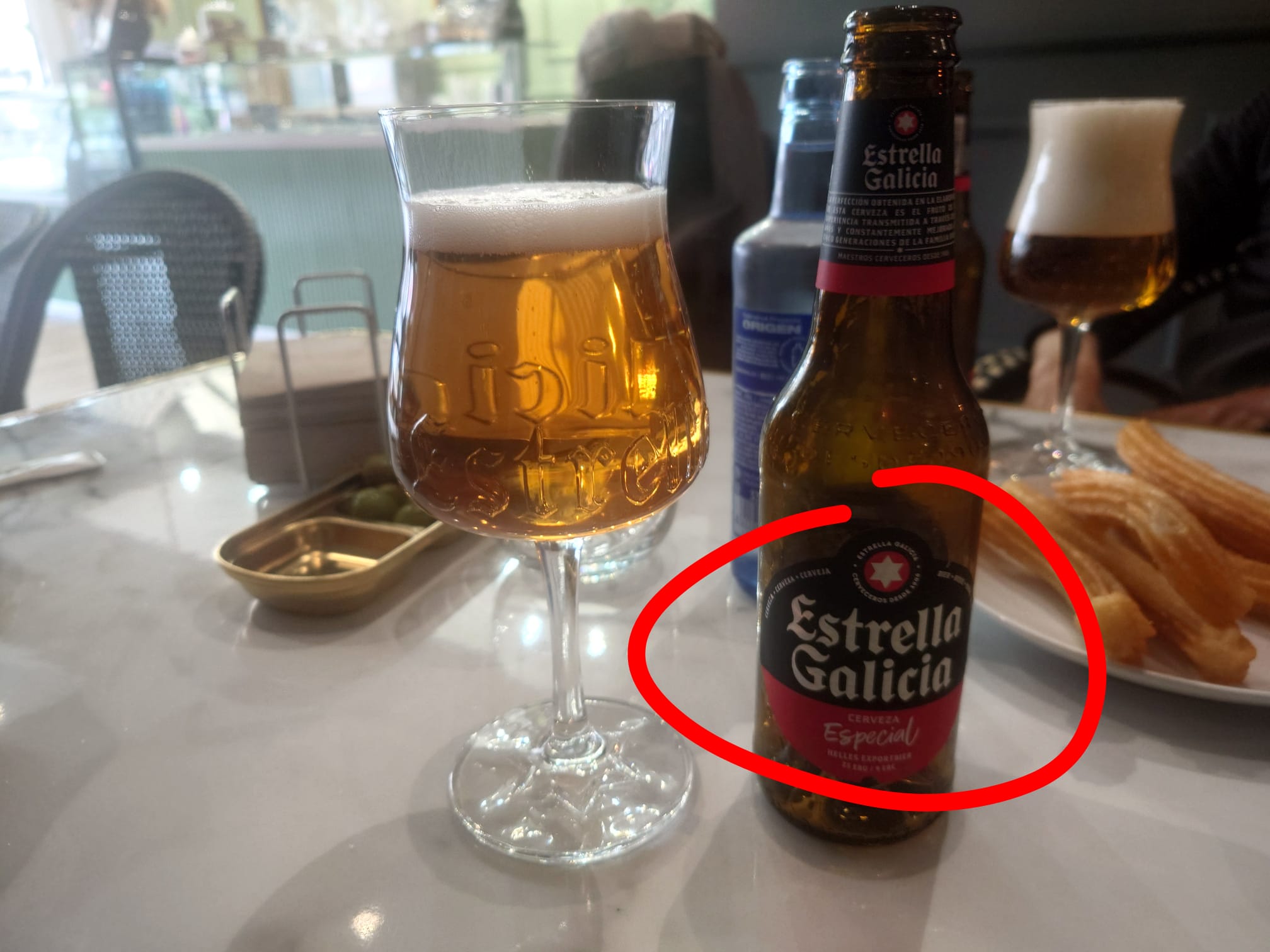
After that, we take a walk through the town of Ribadeo. This isn’t the most beautiful town we’ve seen so far, and we realize we’re totally spoiled after Cudillero.
We have a beer in a pub. Yes, we are in Galicia, so what else can we drink other than Estrella Galicia ??
For dinner we make a super delicious “Mujadara”, poor man’s food in Arabic. But we feel like the richest couple on earth! 🙂
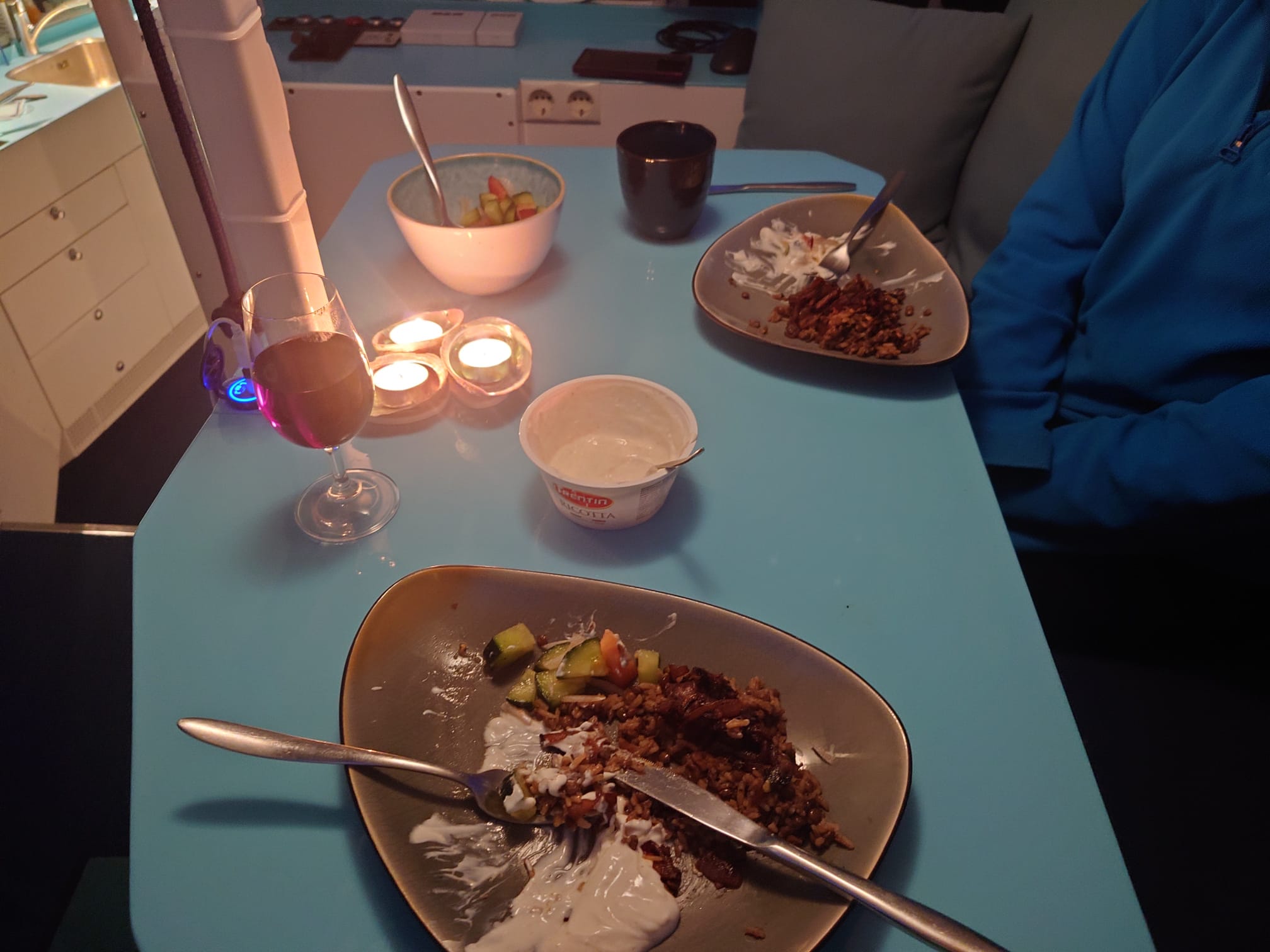
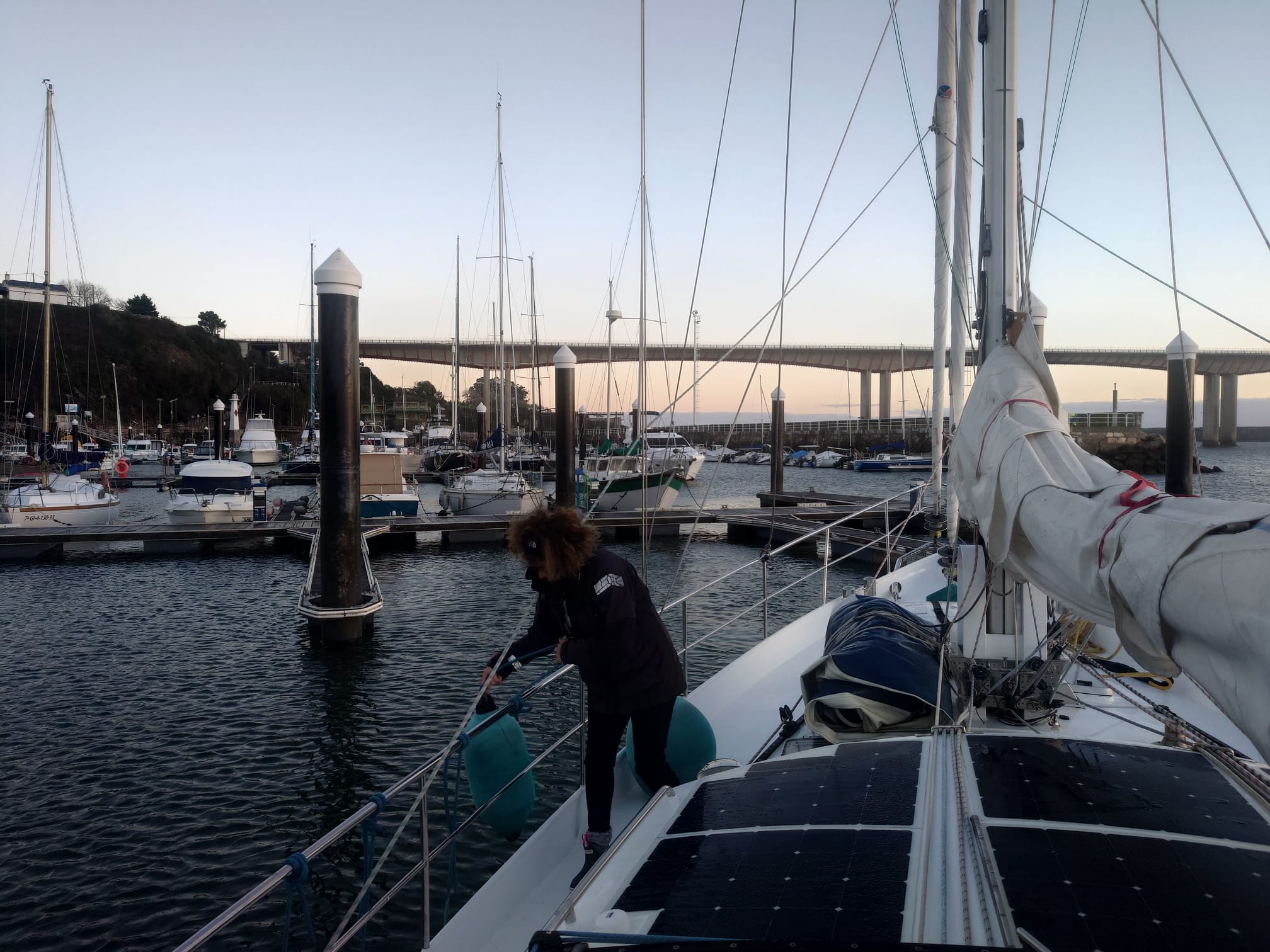
The weather forecasts are reasonably good so it’s time to move on to Viveiro today.
At 0830h, just before sunrise, we leave our berth.
As we have passed the bridge, the sun rises. It’s cold: only 4ºC. Sher dresses in all the warm clothes she could find, and Wim wears his “Fladen” Norwegian fisherman’s survival suit.
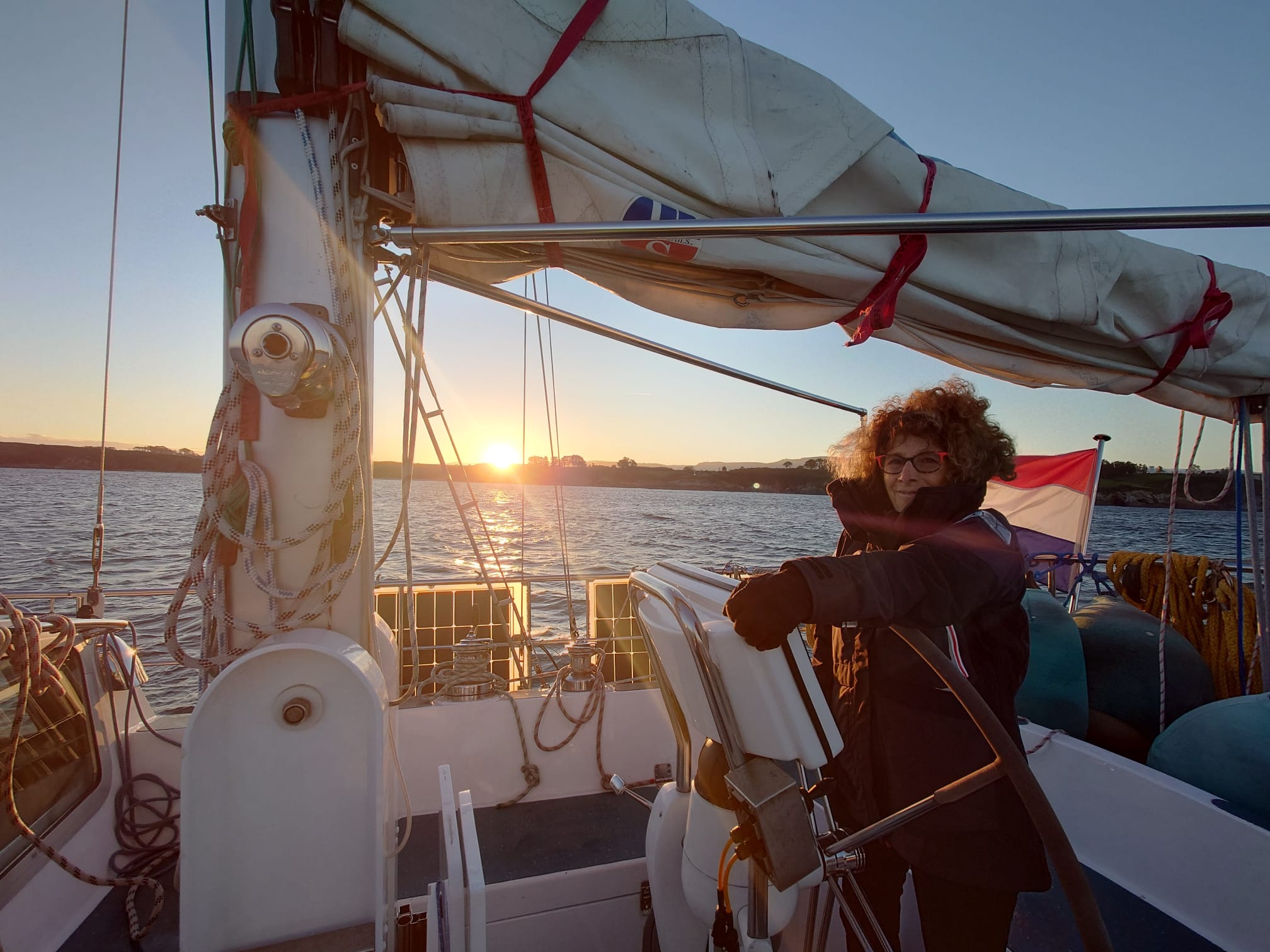
When we cross the wide bay to the cape Cabo Moras, the wind increases to 20-22 knots. Dione IV is at full speed but because the wind keeps increasing and we don’t know if will increase further, we put a reef in the main sail and furl in the yankee sail a bit. But once we get closer to the cape, the wind decreases, and we pull the reefs out. Once we reach the cape, the wind has completely gone and we start the engine.
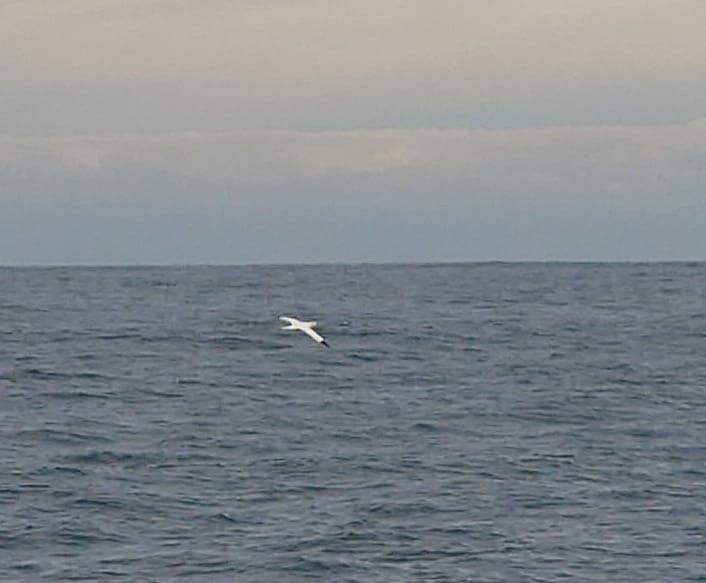
At a cape, everything changes, as we always say…
And what else at a cape? Of course: the ones who are crazy about capes! Gliding on the wind. Le fou du cape, in French. The beautiful Northern Gannet 🙂
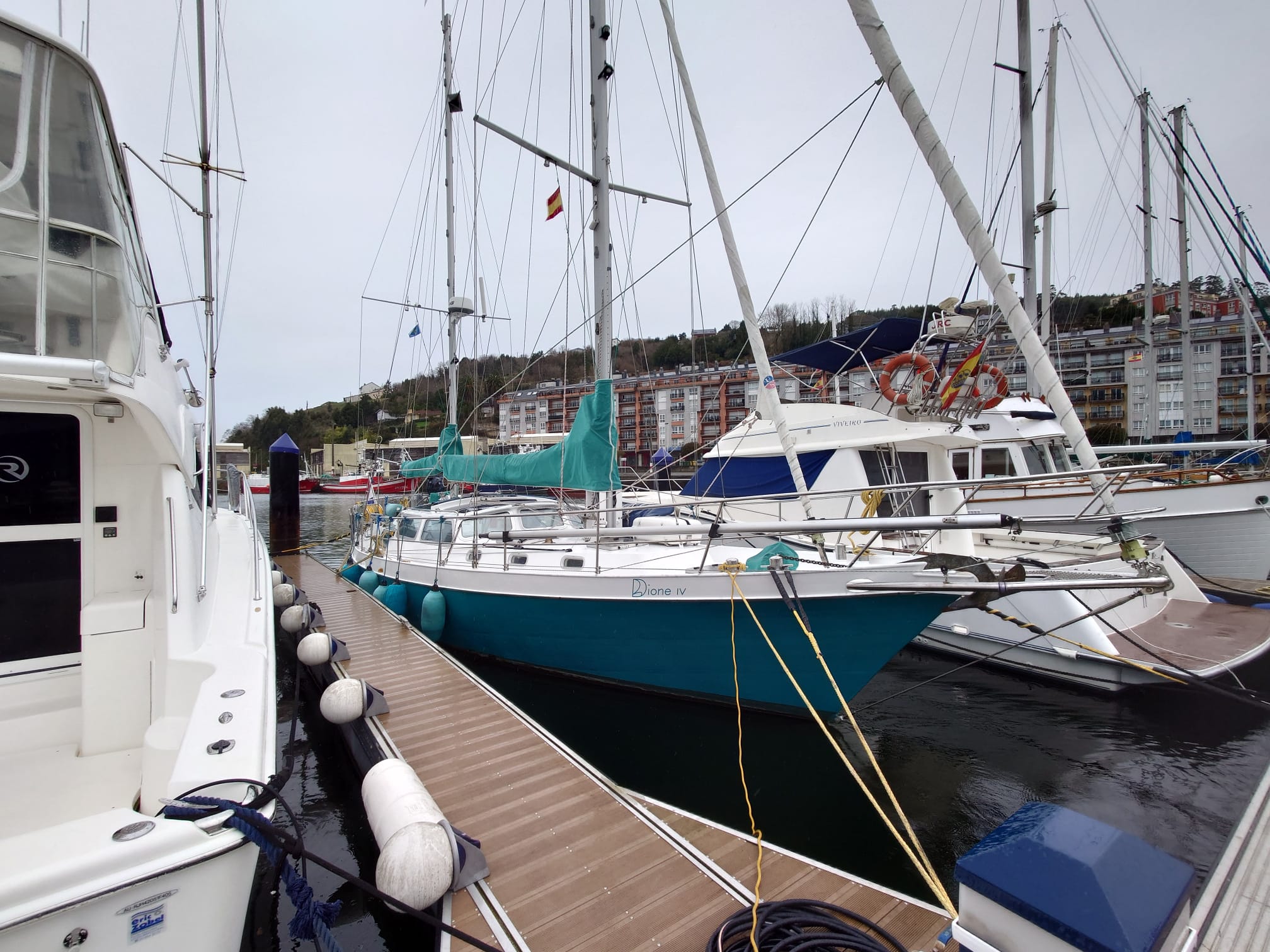
3 o’clock we arrive in the marina de Viveiro. It feels like a milestone. For Wim, because for two consecutive years he tried to sail here (from The Netherlands) but didn’t get this far due to unfavorable weather conditions in summer and for the both of us because this is where our Cruising Galicia starts! The famous Spanish Rias. Cruiser’s paradise, many say.
Since we’ll be in Viveiro for a bit, we have time to do some more projects in between our travels and our scooter rides. Sher continues sewing boat fender pajamas, and Wim installs LED lights behind the day fuel tank viewing tube and filters.
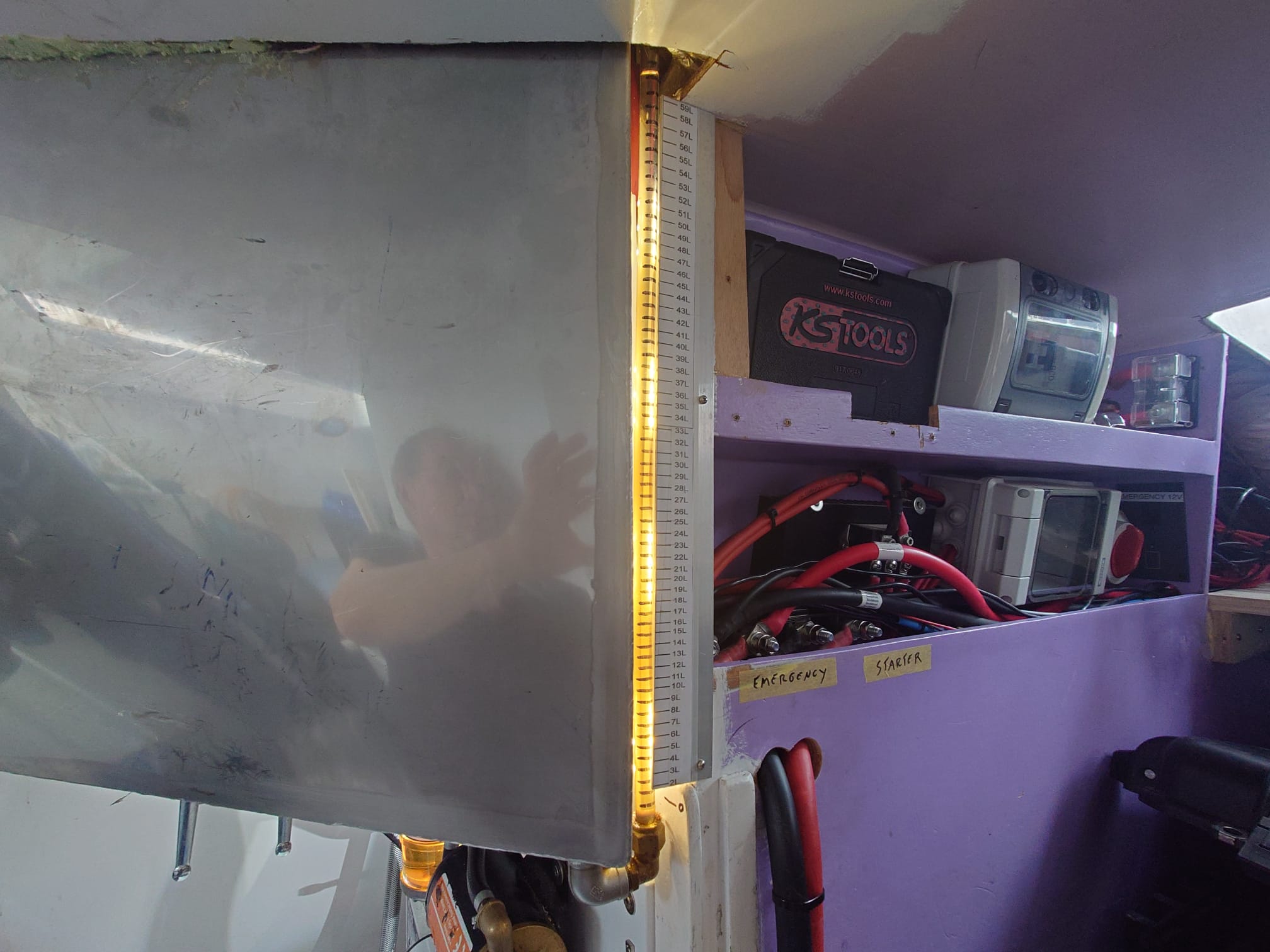
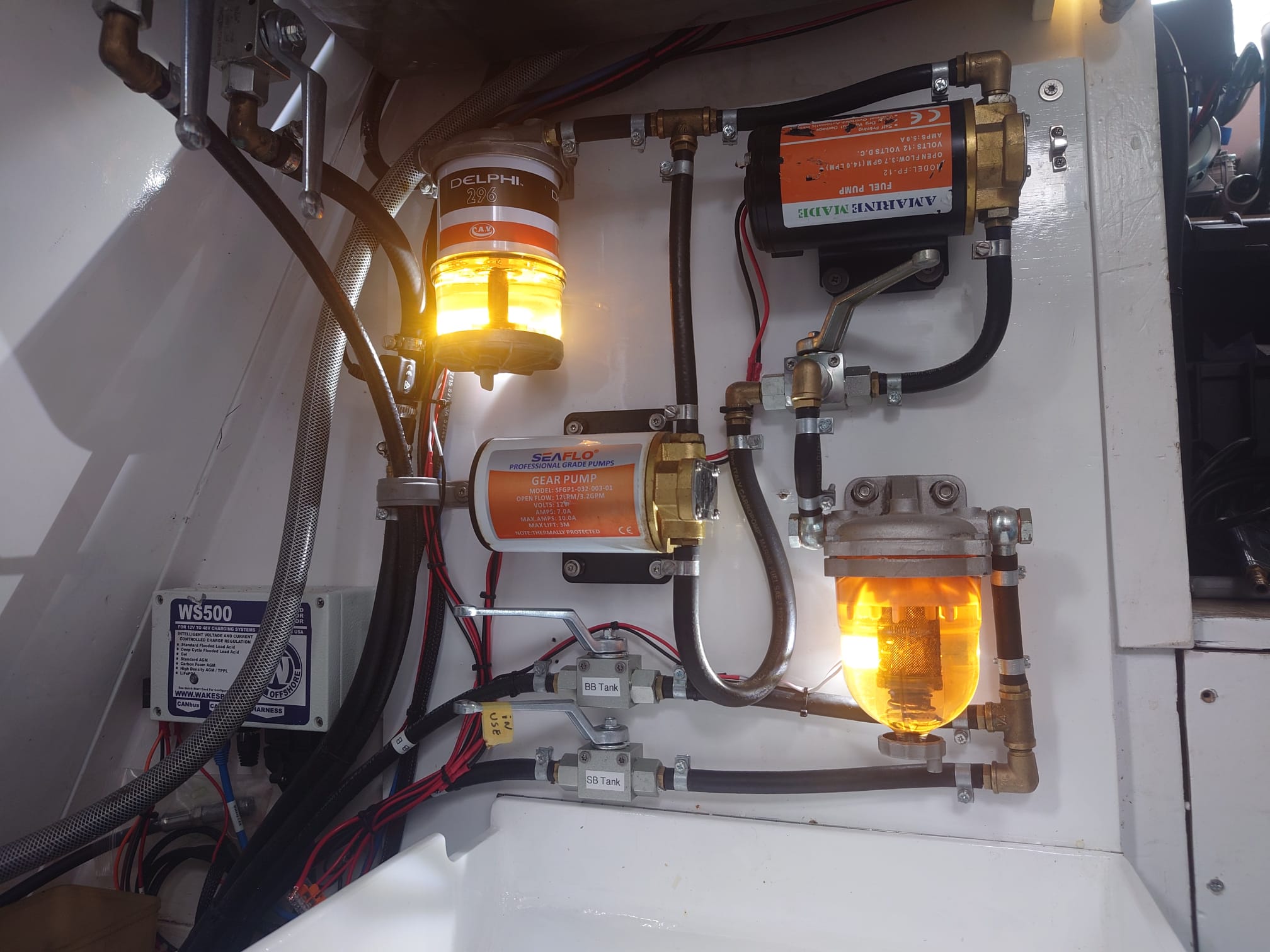
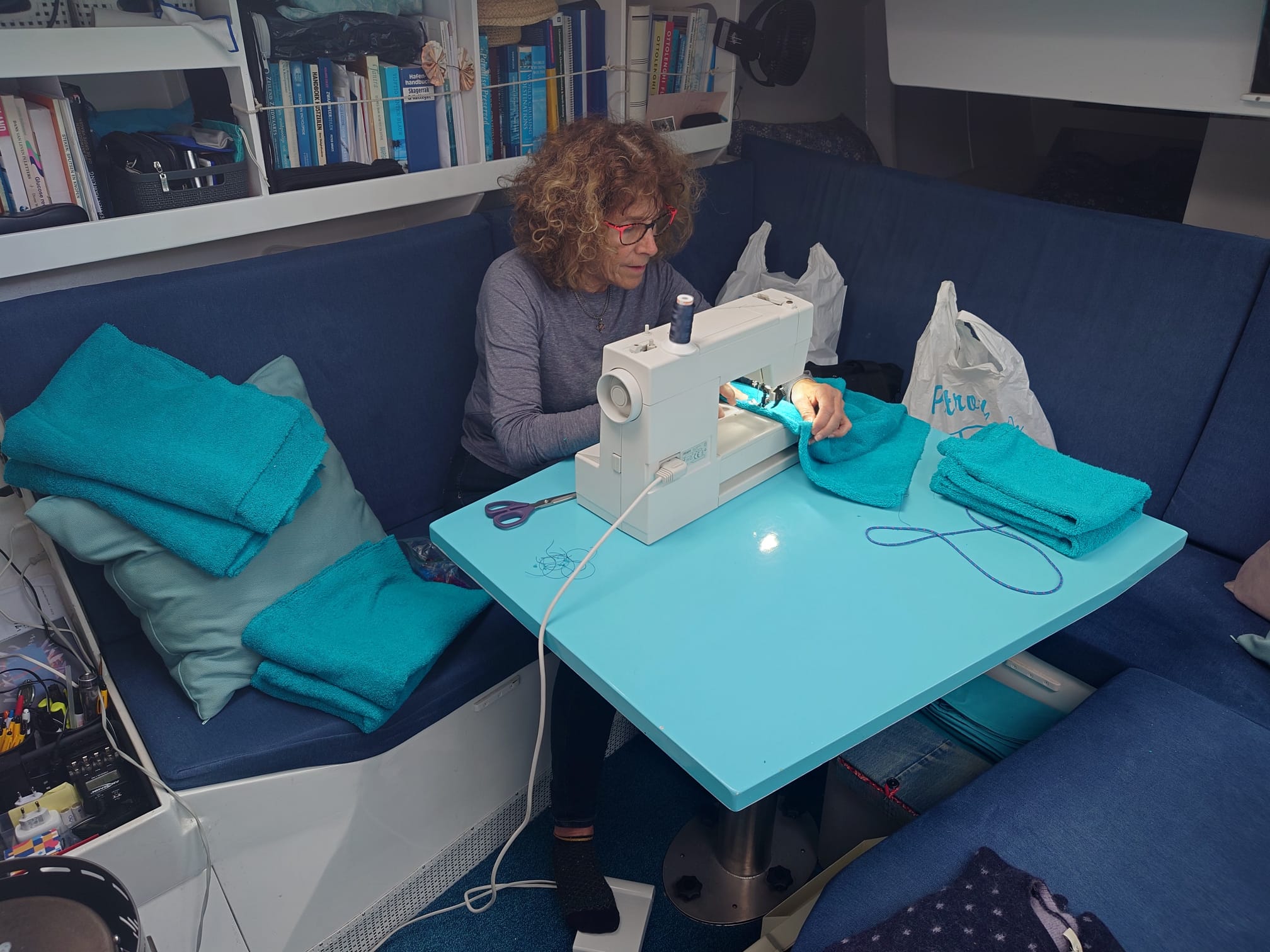
Now, let’s go scootering!!!! We decide to go to the viewpoint near de lighthouse on the cape “Punta de Faro”.
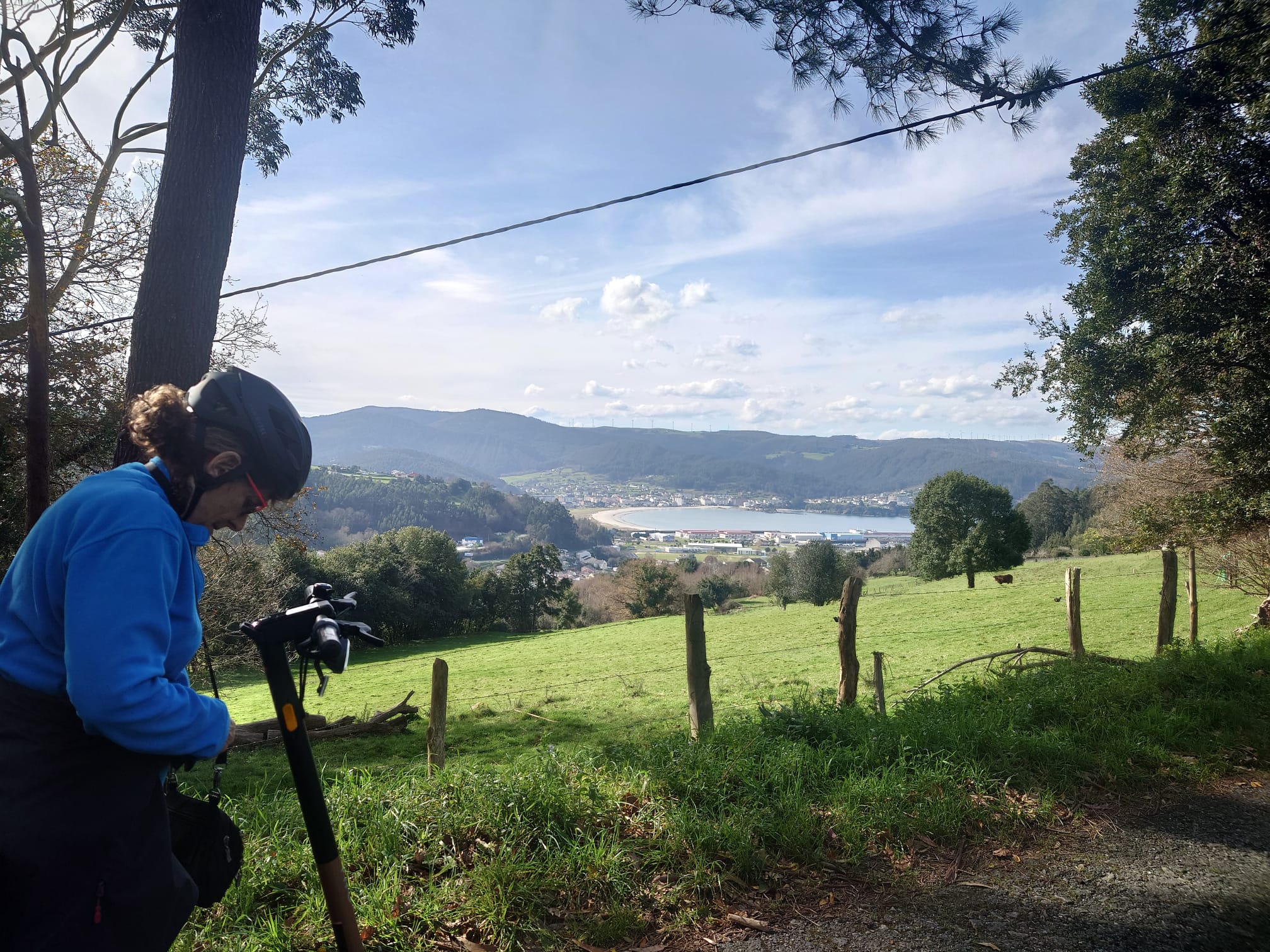
We take the small roads over the hills and through Eucalyptus forests.
The route to “Miradoiro do Monte Faro” is about 10km’s. It has a lot of steep hills and we already know that takes a lot of energy from the scooter’s batteries. So, to save energy we walk up hill and let the scooters cruise control at 4-5km/hr so that we don’t have to push them.
We pass the beautiful beach at the bay “Insua de Area”. This will be a lovely anchorage! At the moment, the weather is a bit too changeable to go anchoring but as soon as the weather gets nice, we will go anchor here!
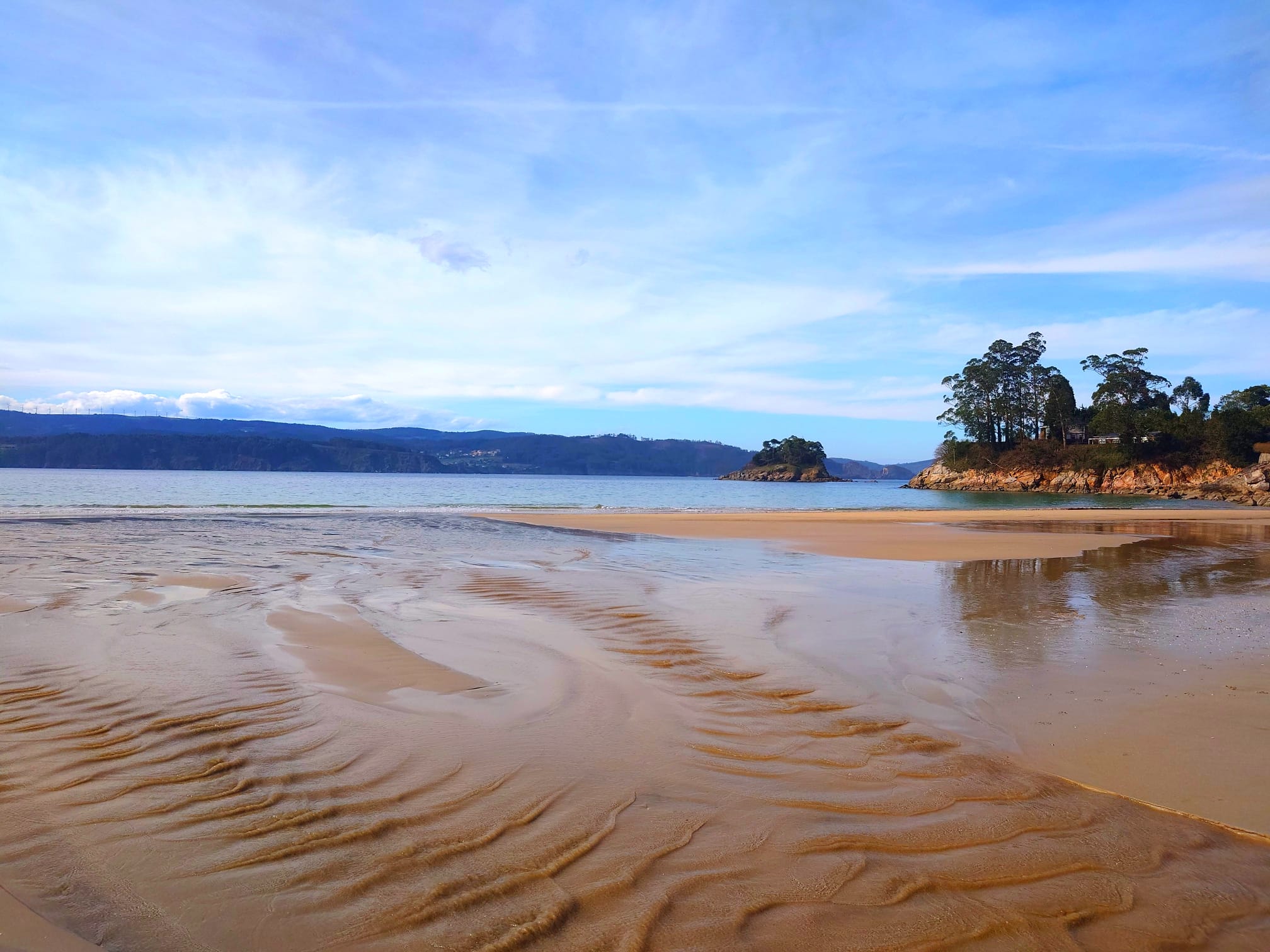
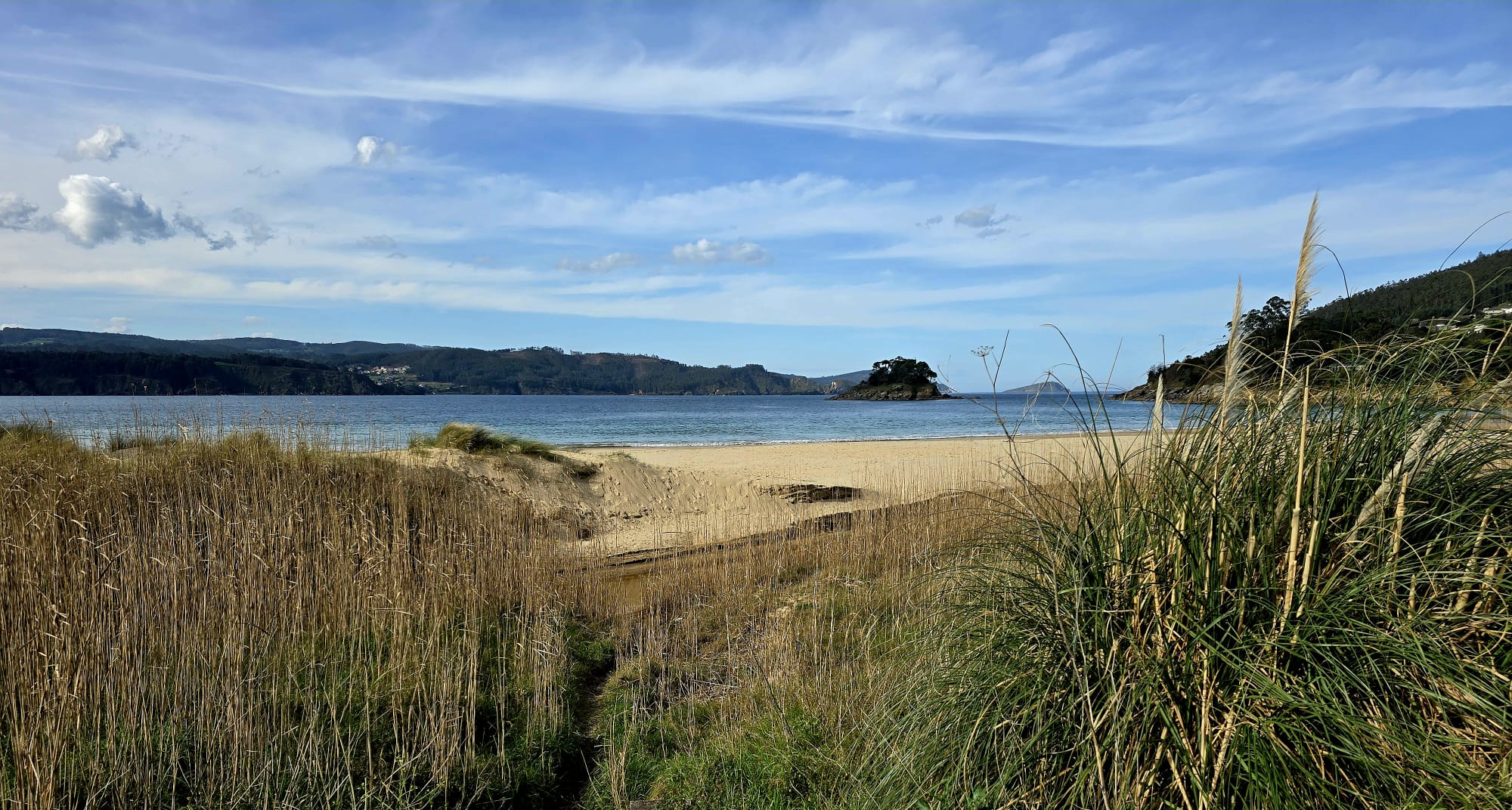
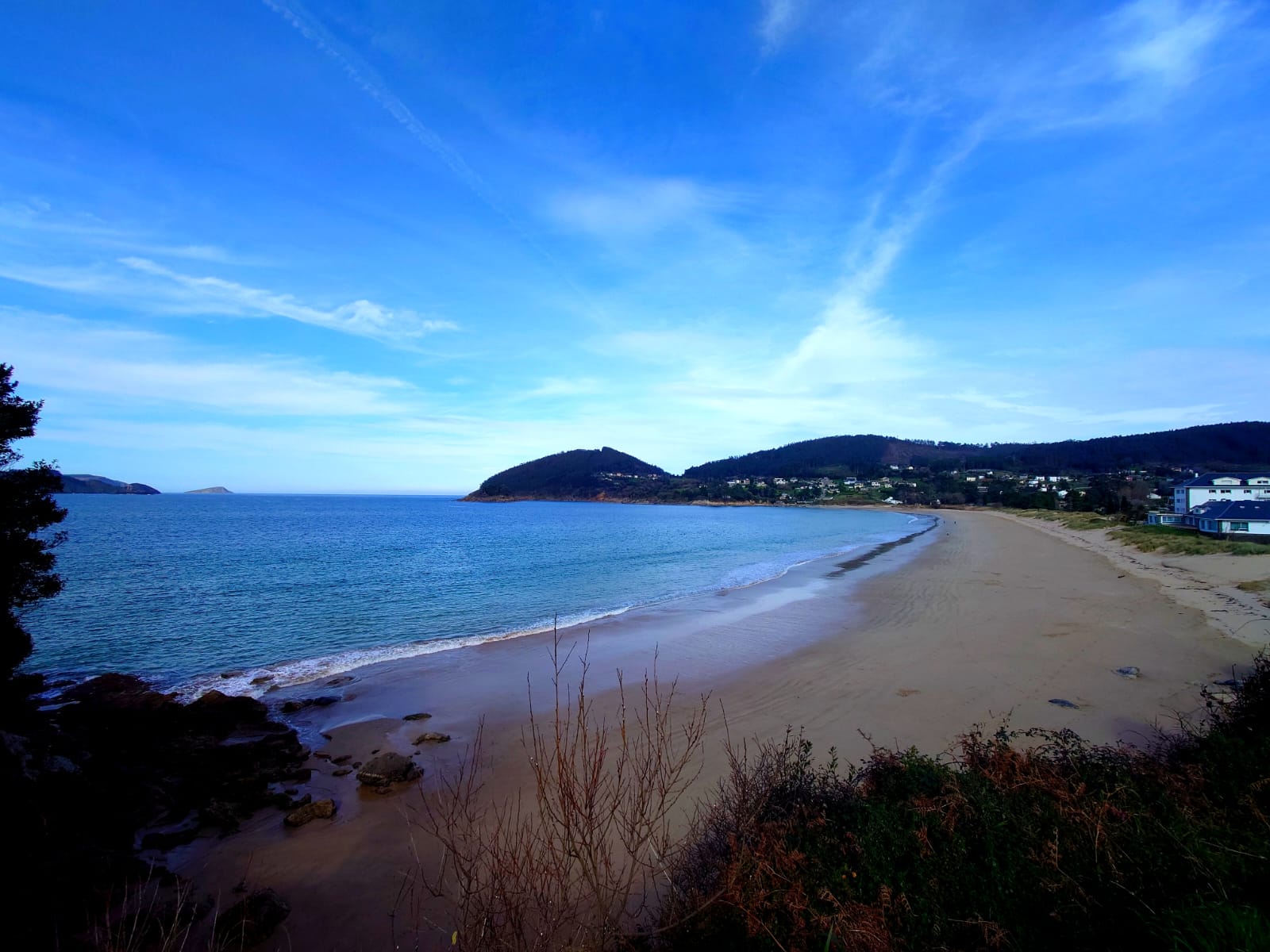
After the “Playa de Area”, we climb up to the viewpoint. With some sweat on our backs we enjoy the lovely views.
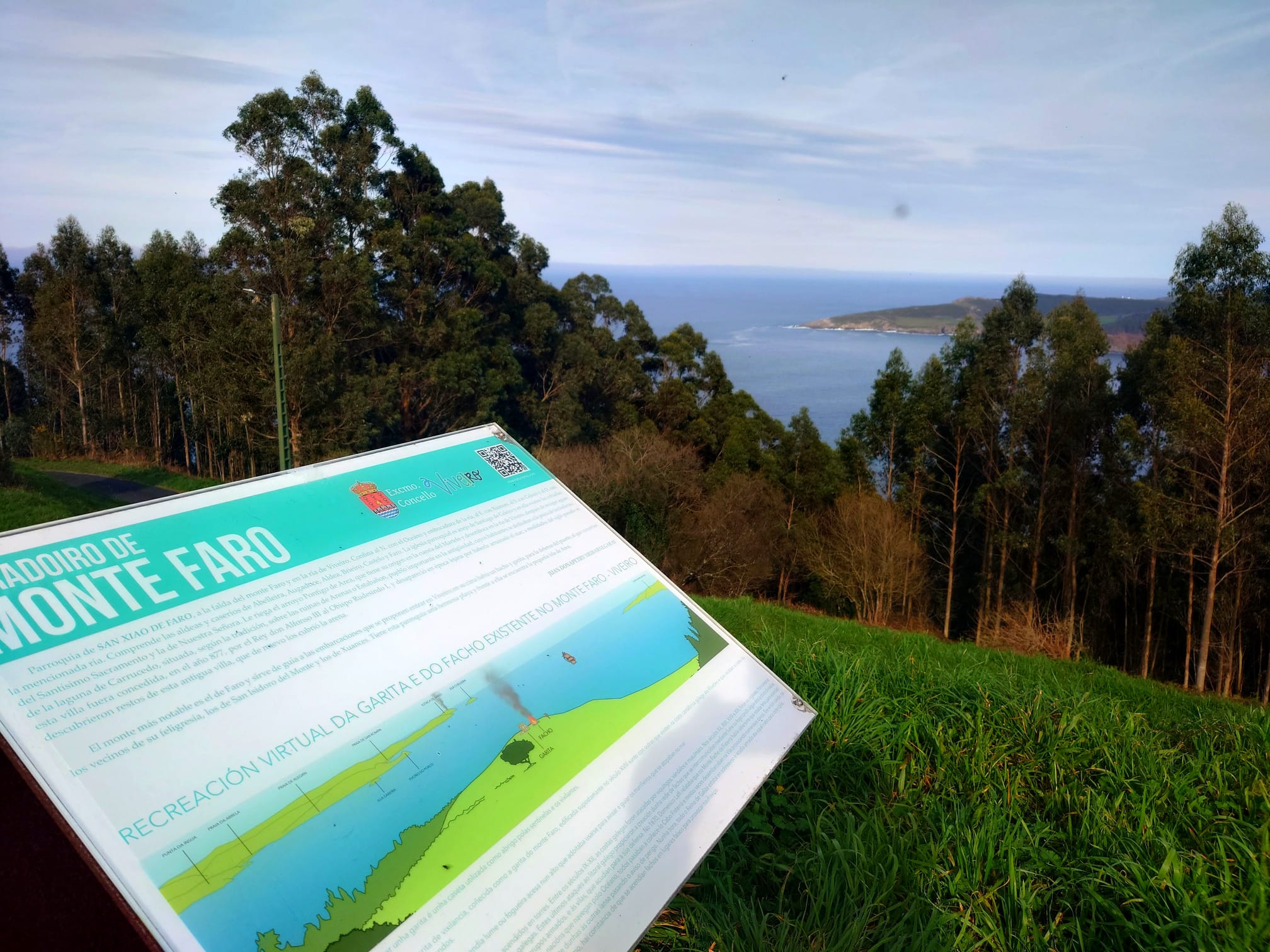
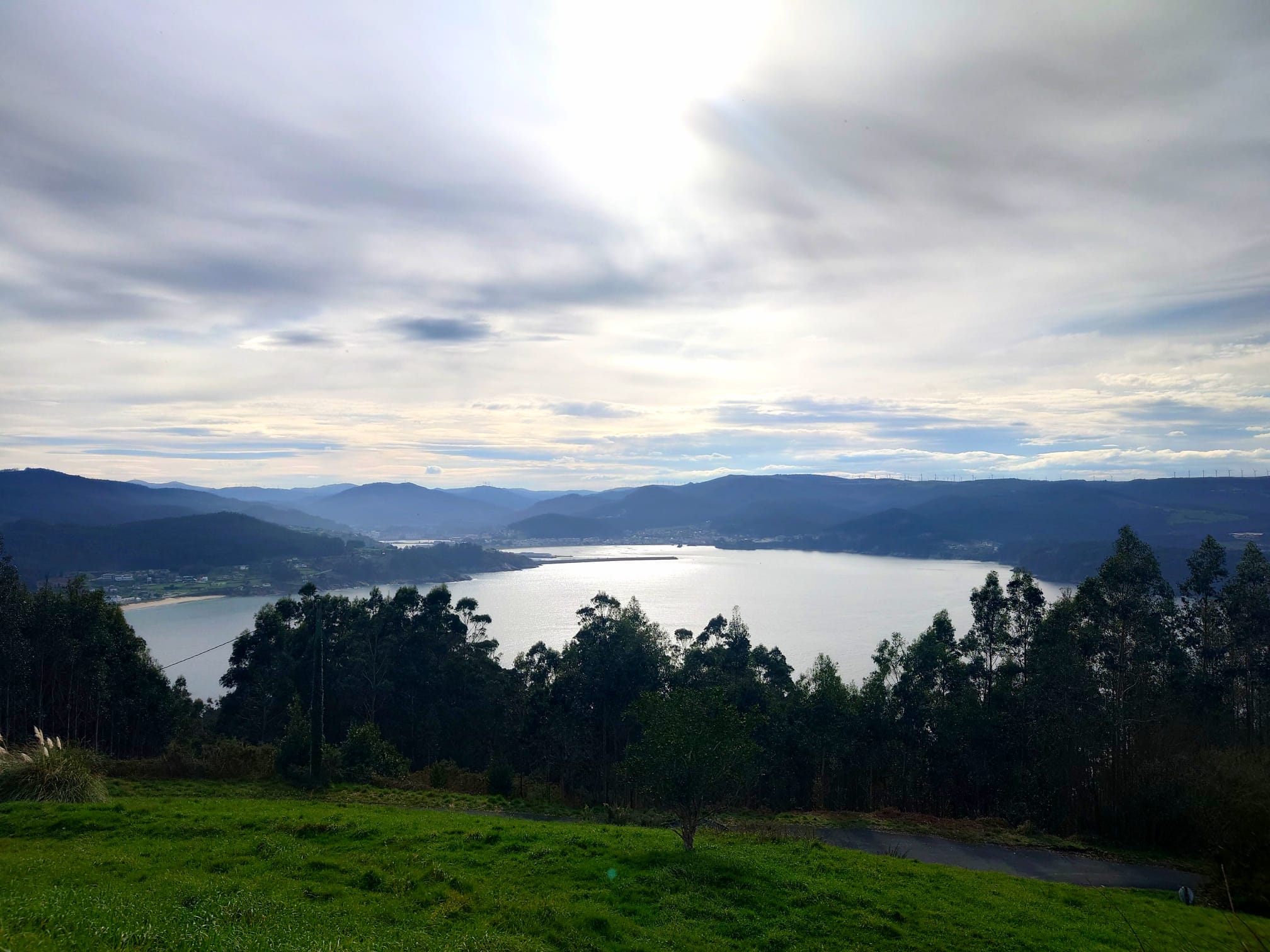
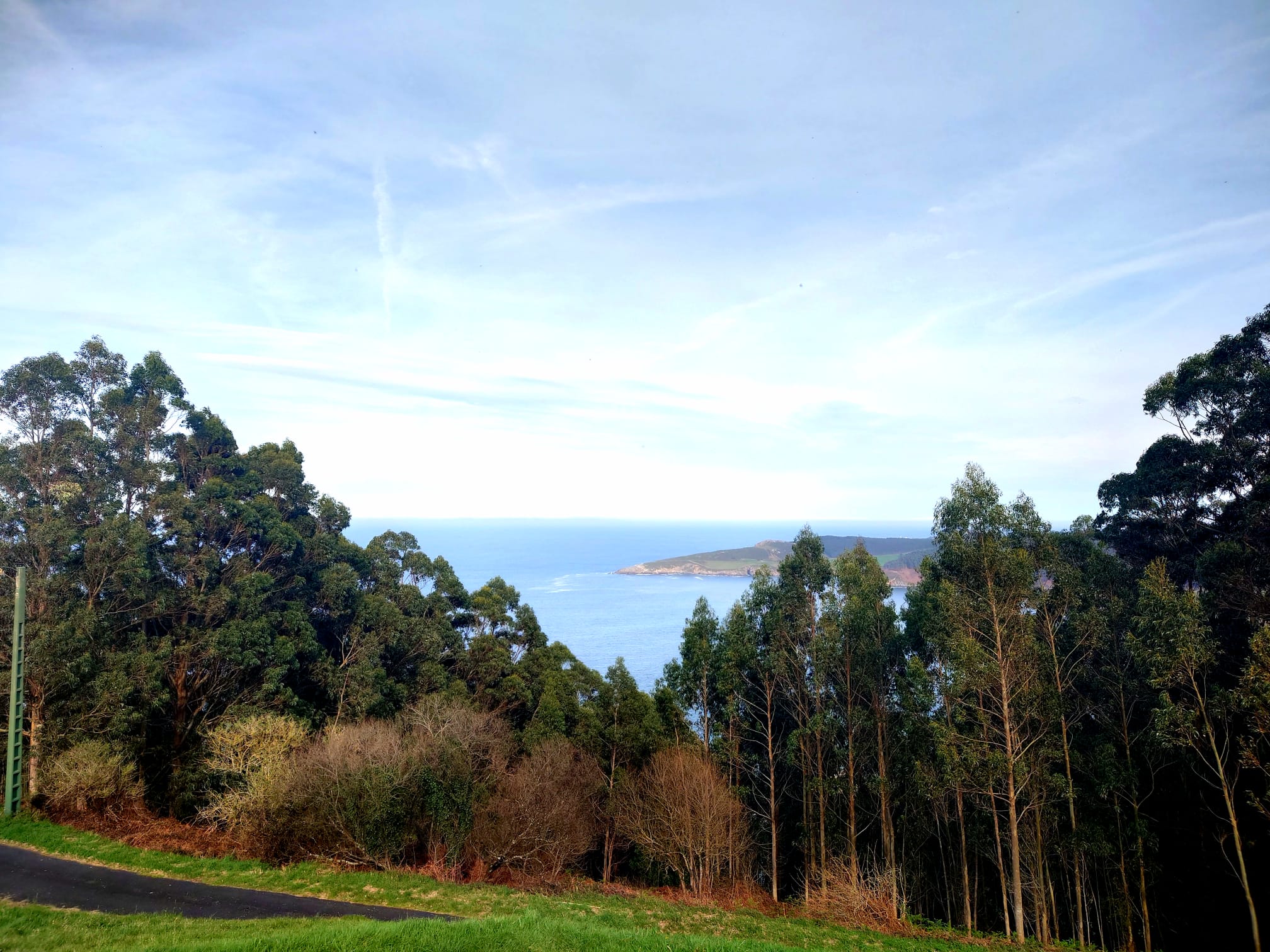
On the last few percents of battery power we arrive at the marina. Only 50 meters before the gate to our pontoon Wim’s scooter begins slowing down and right before the gate the battery is empty! What timing! Sher has 10% left in her scooter. Wim starts thinking of adding some more battery capacity… Many times, especially in the hills, it has been a challenge to get back home without empty batteries. Hmm, this needs some research…
That evening, we have a delicious dinner with Iranian herbs beignet from an Ottolenghi recipe along with the rest of our Mujadara. Those two Arabic dishes go very well together!
We enjoy our meals so much. We almost never we go out to eat in a restaurant ashore, except when socializing with others. Restaurant Dione IV is the best!
And after dinner, at 9 o’clock or so, we watch an episode (of 50) of the Spanish series “La Casa de Papel” (Money Heist). Interesting plot and good for our Spanish language.
What a good life we have!!
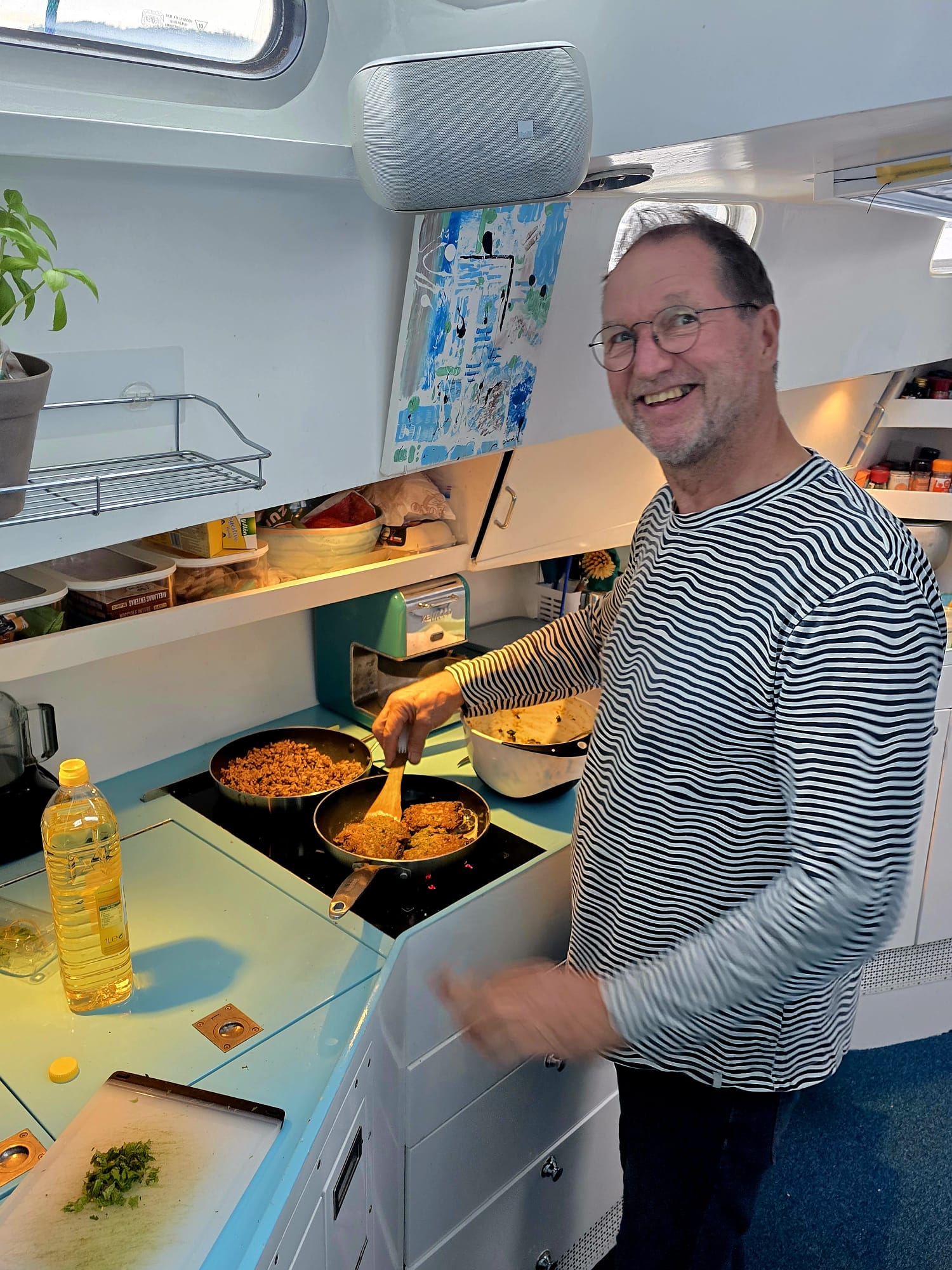
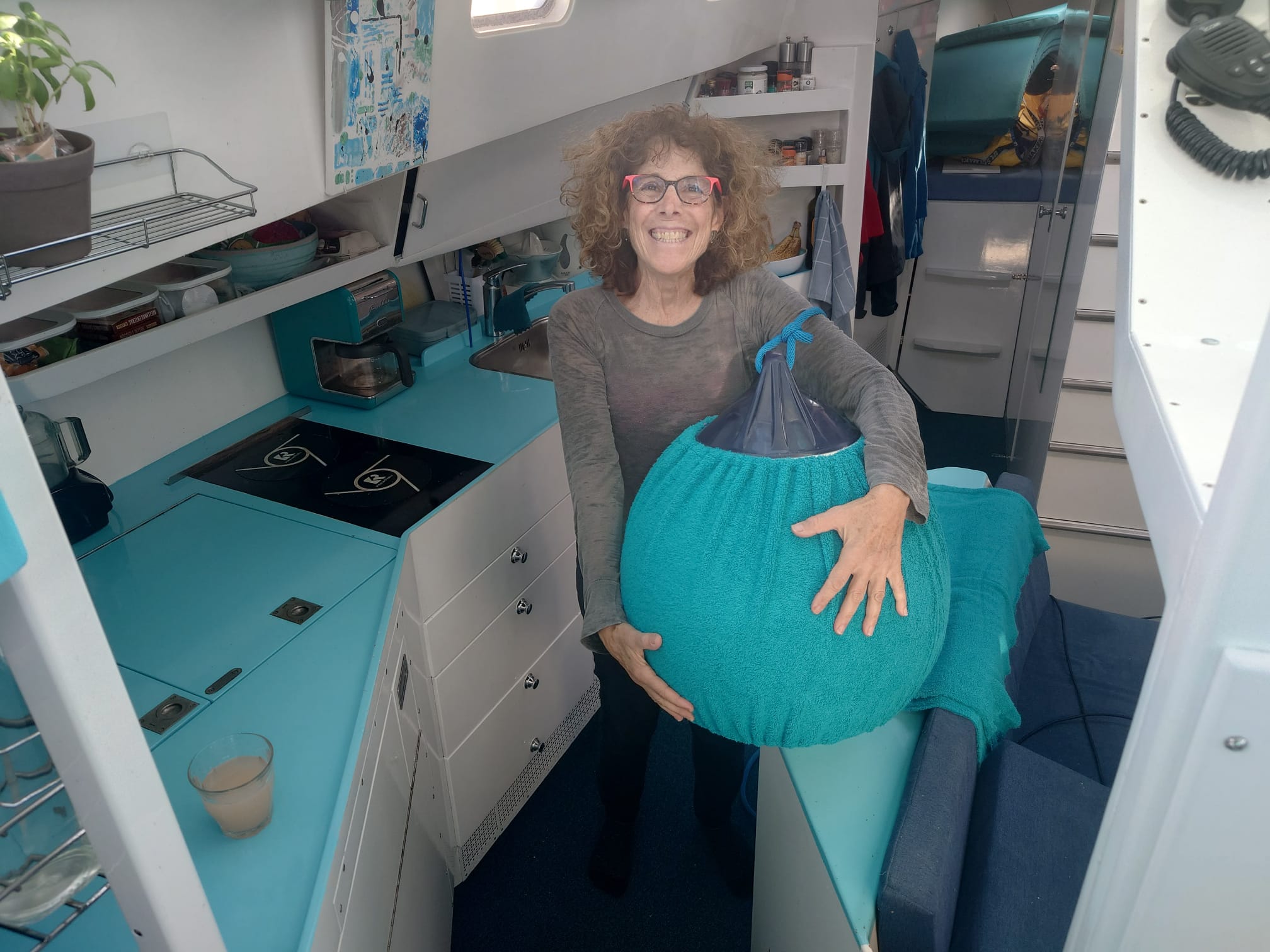
In the morning, Sher sews new pajamas for our big ball fenders!
Wim is doing some research on how to make external additional batteries for the scooters, to extend our range. He orders some items from Amazon. Amazon is really great here in Spain, they have a lot of technical stuff and the delivery to the marina office is smooth and quick.
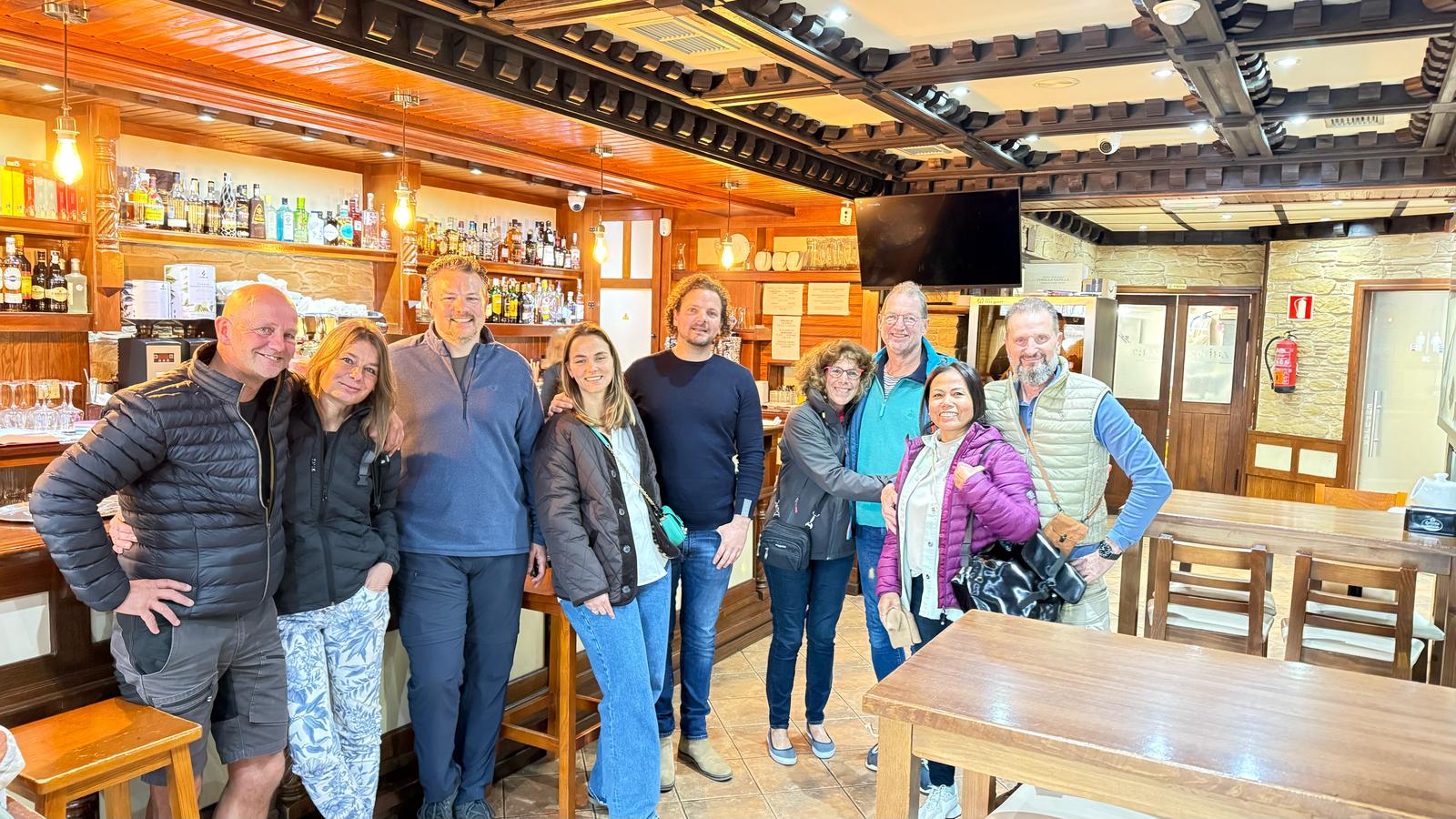
In the afternoon, we have a lunch in a local restaurant with the other cruisers on the pontoon. Very nice conversations and good food!
After that, we take a long walk together, along the river.
A lovely sunny day and another wonderful scooter ride into the hills on the west side of the Ria…
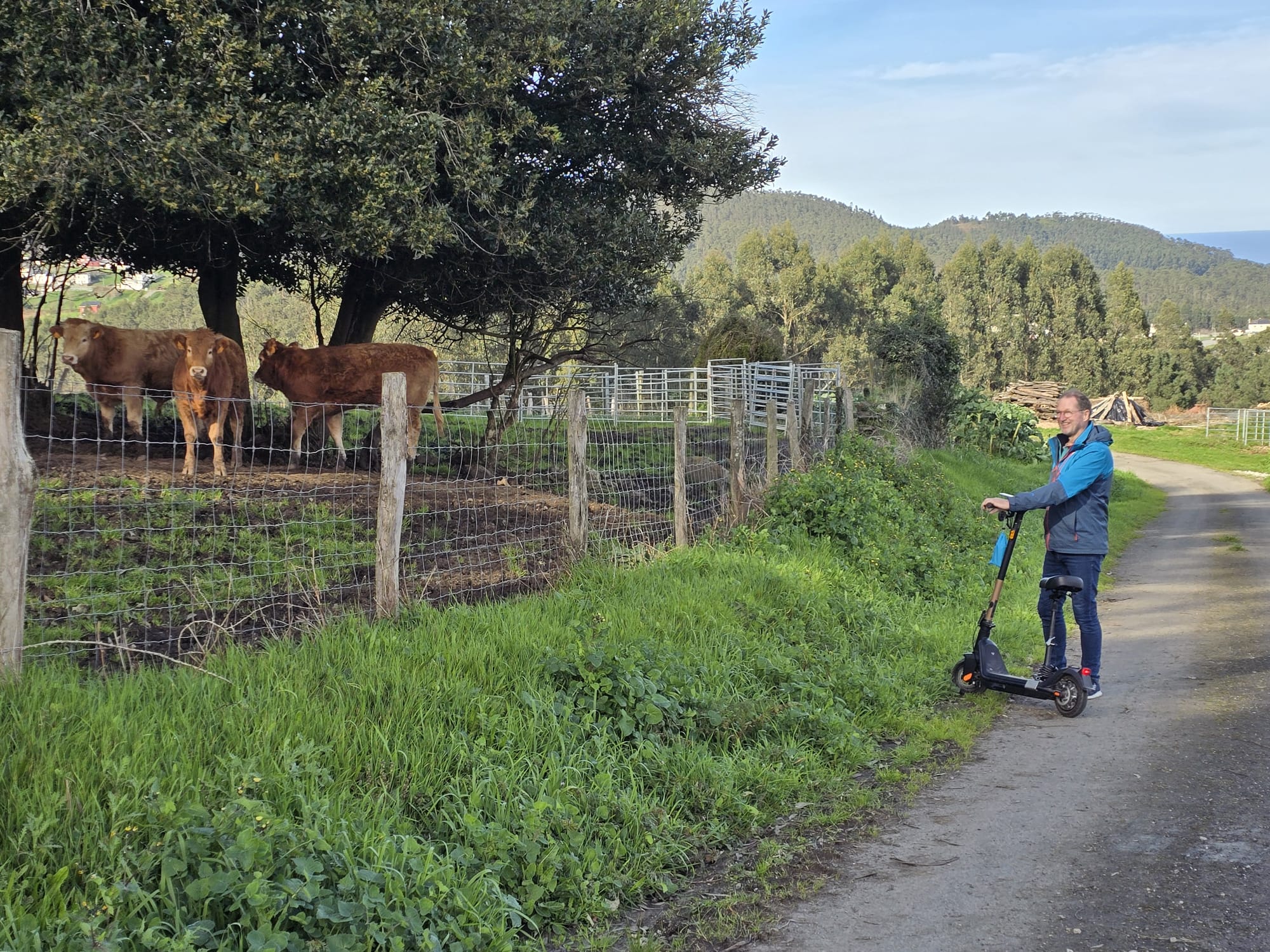
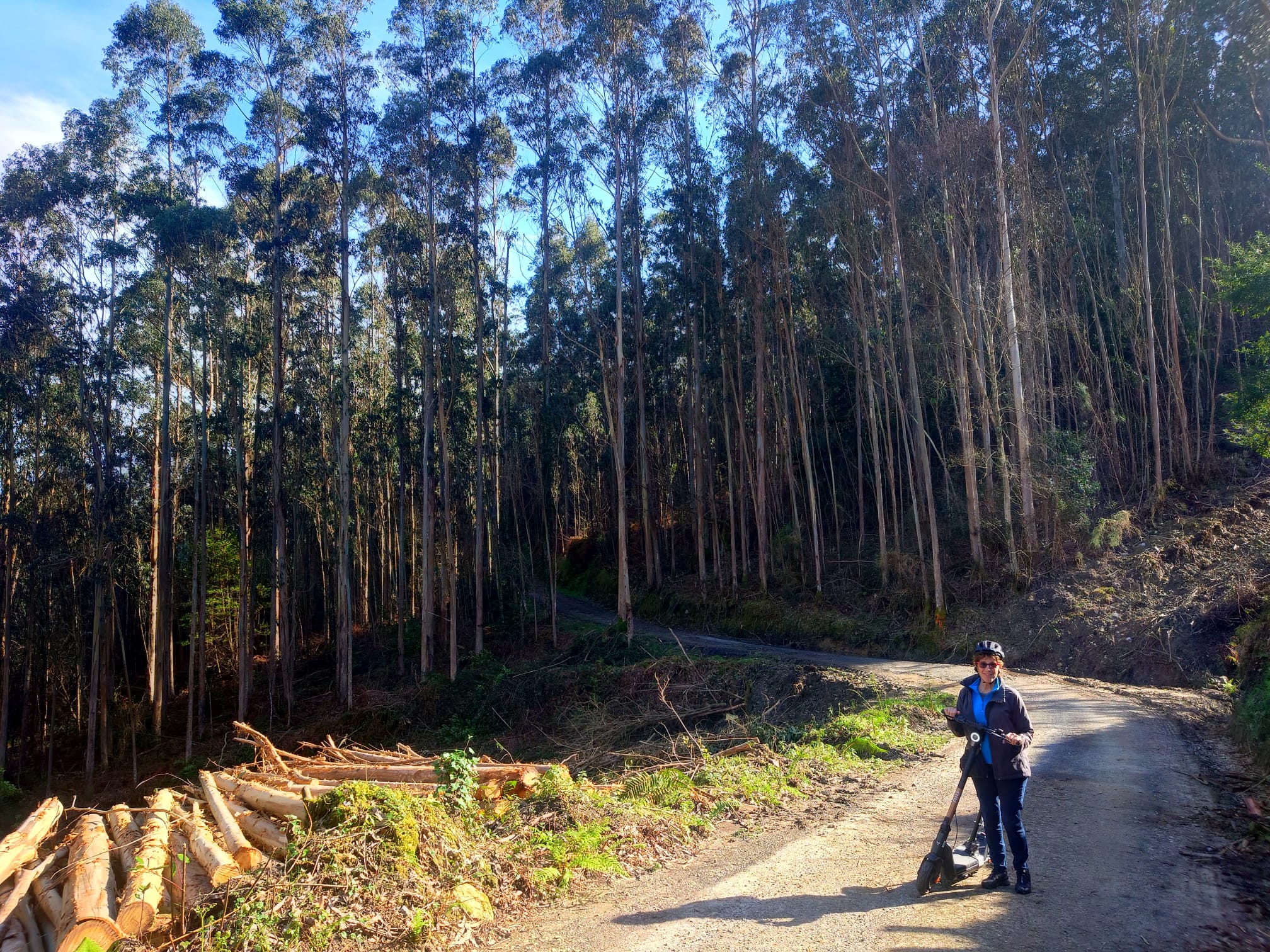
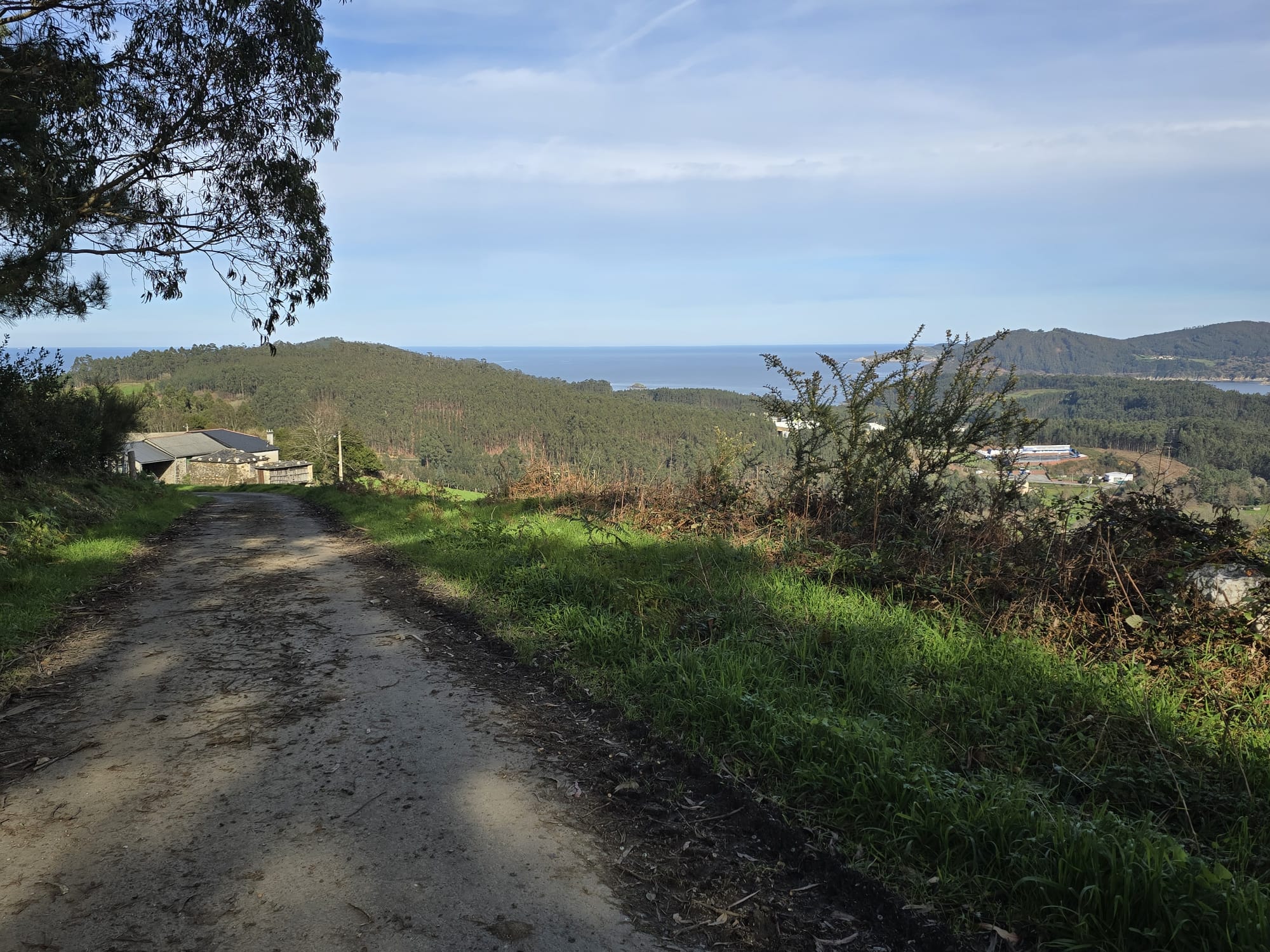
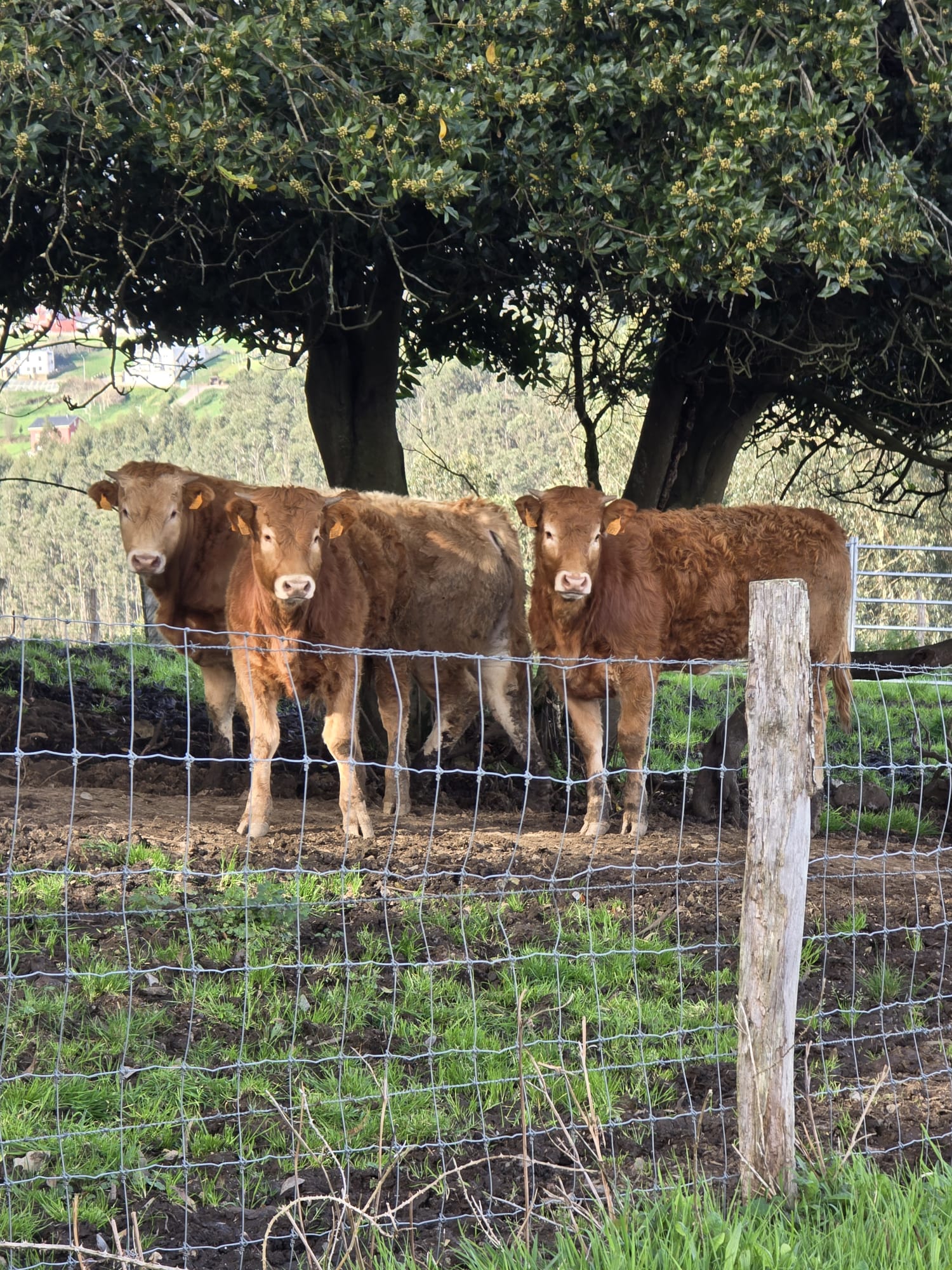
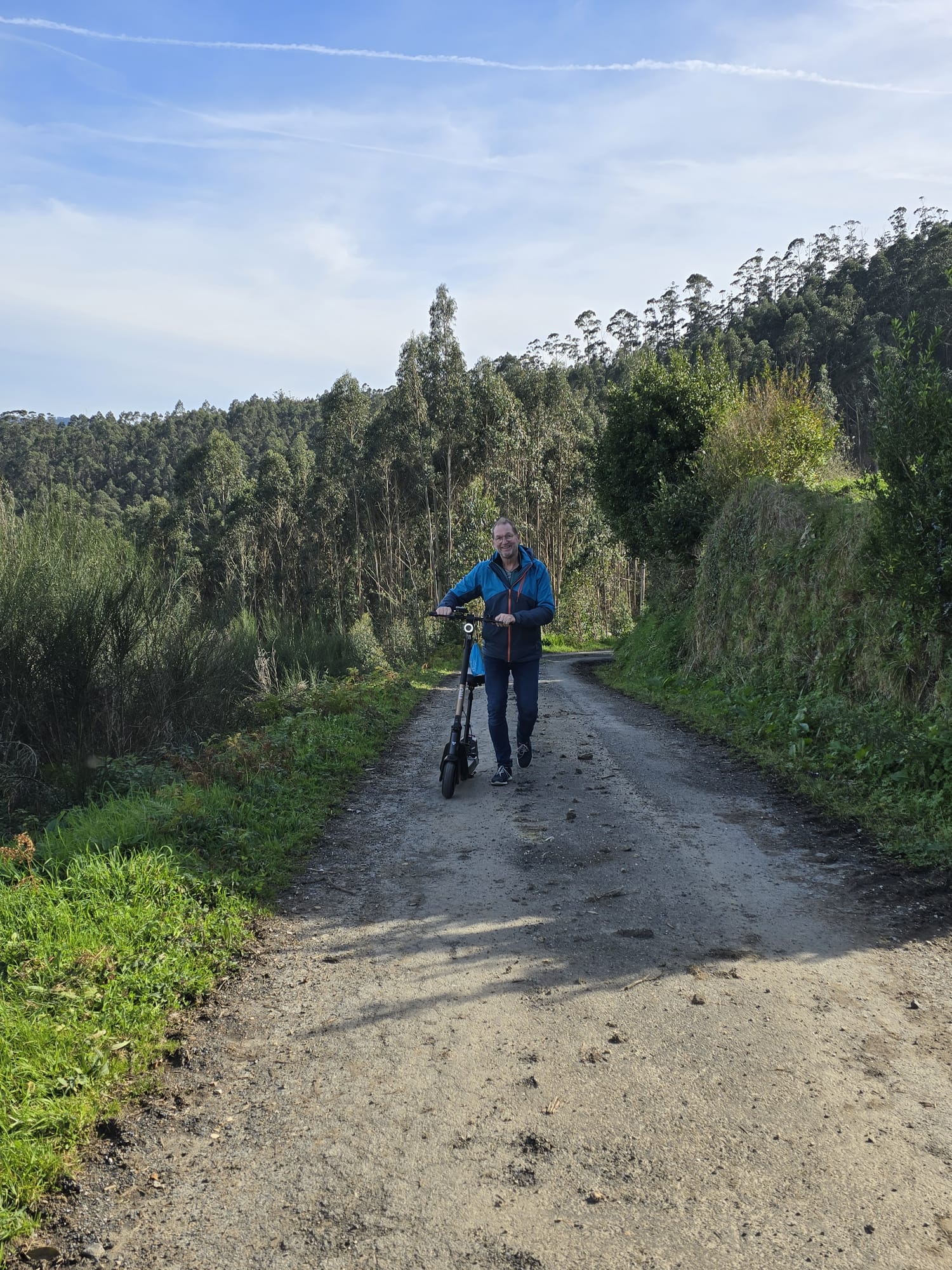
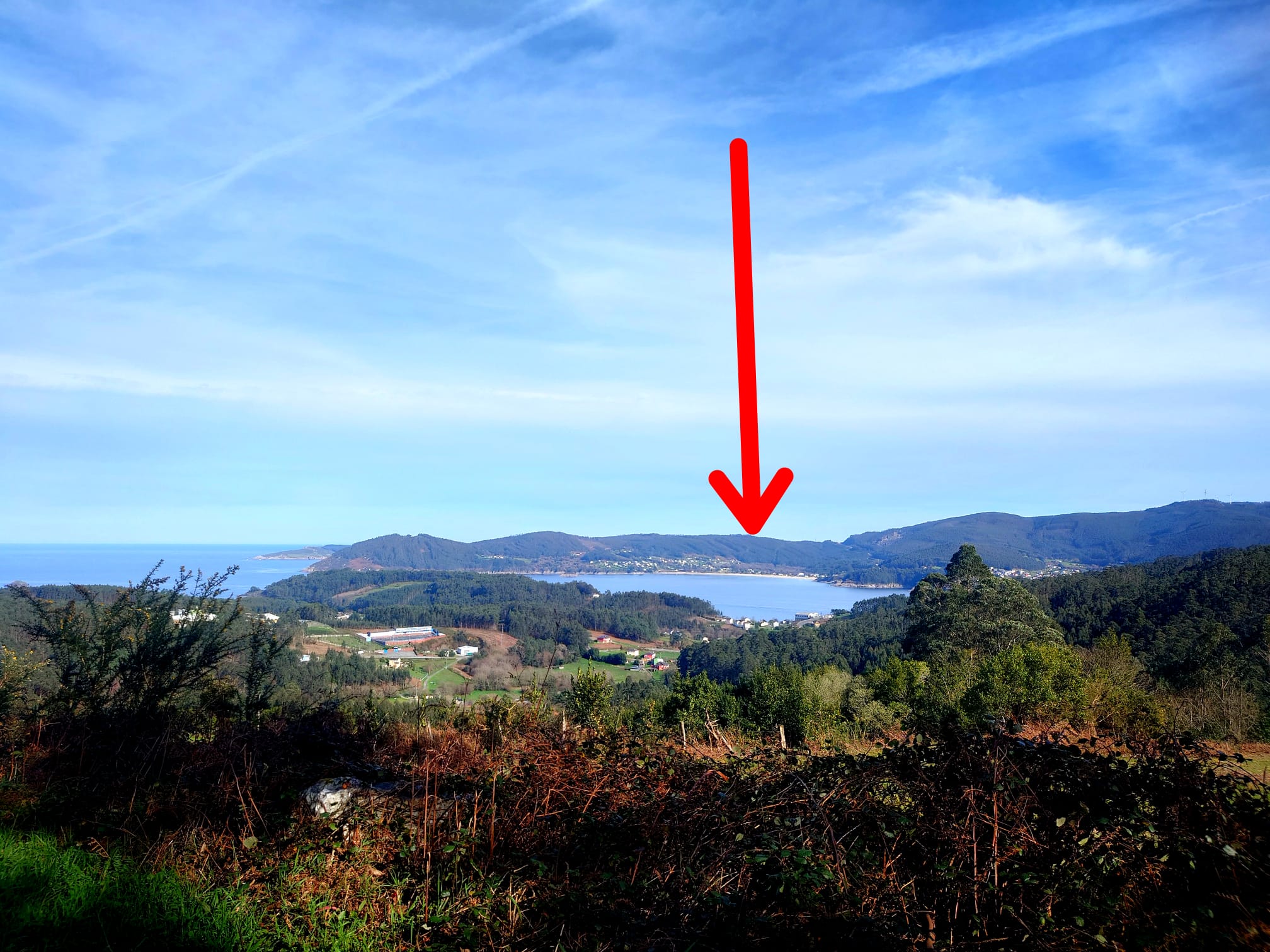
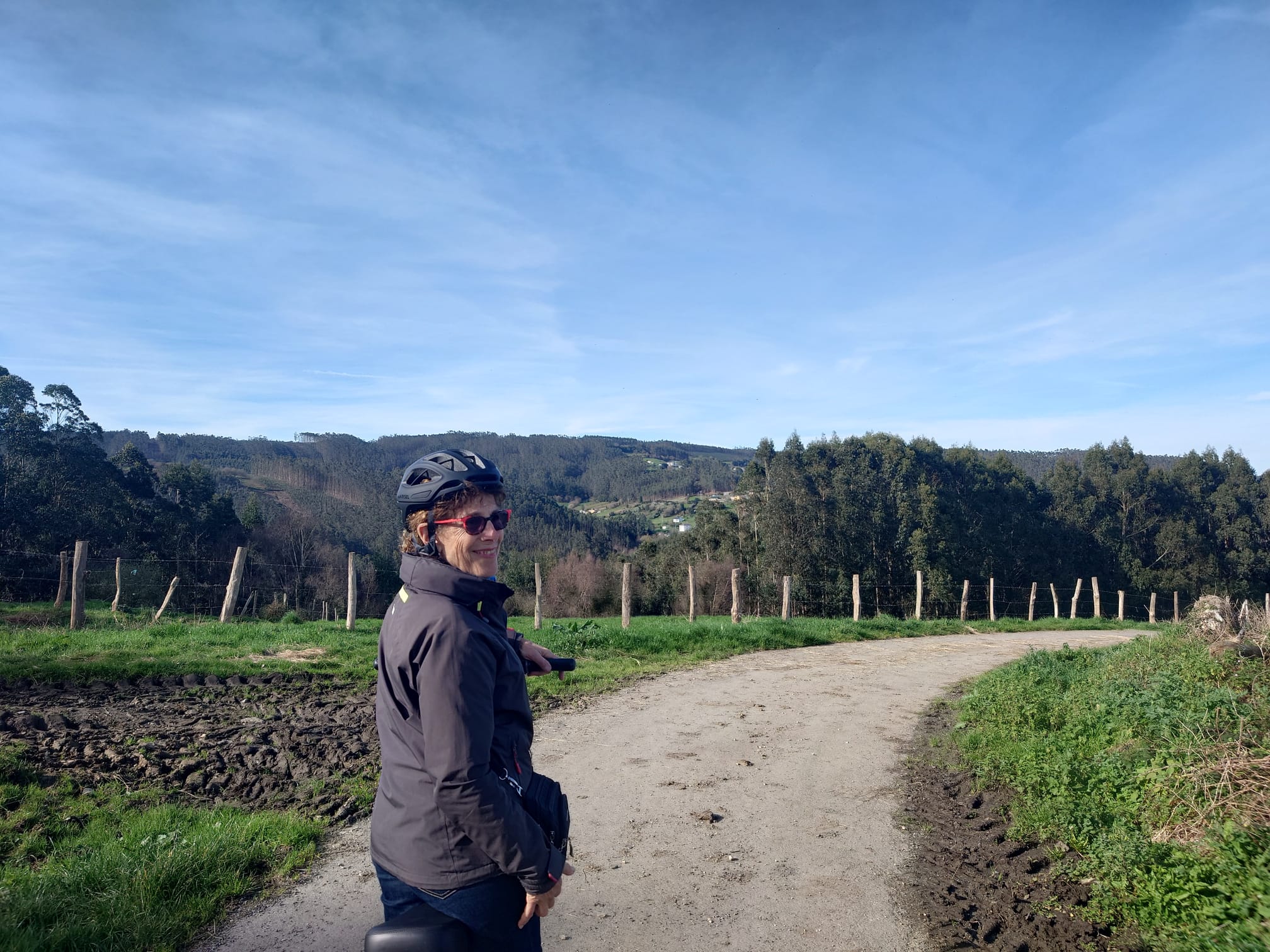
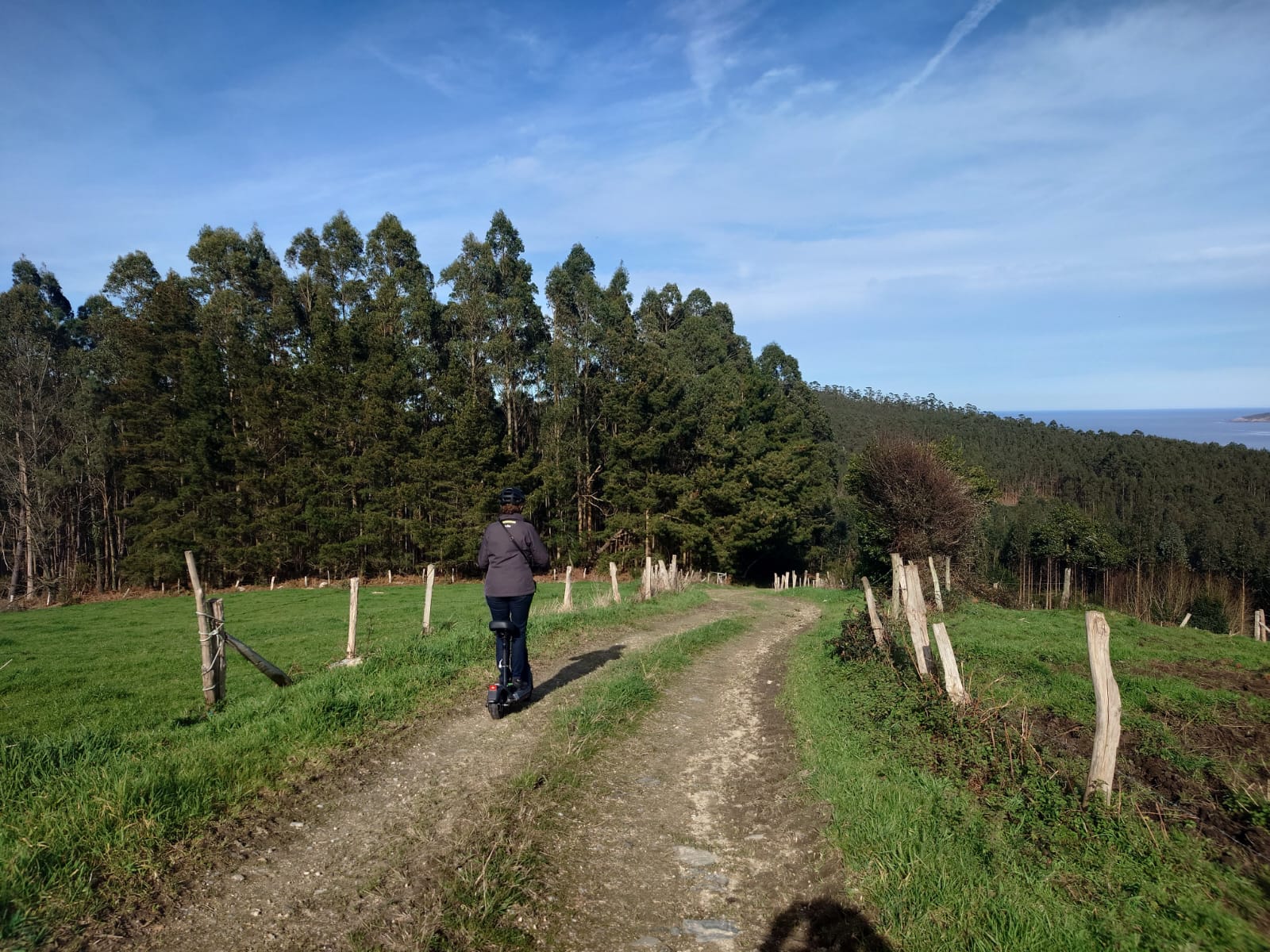
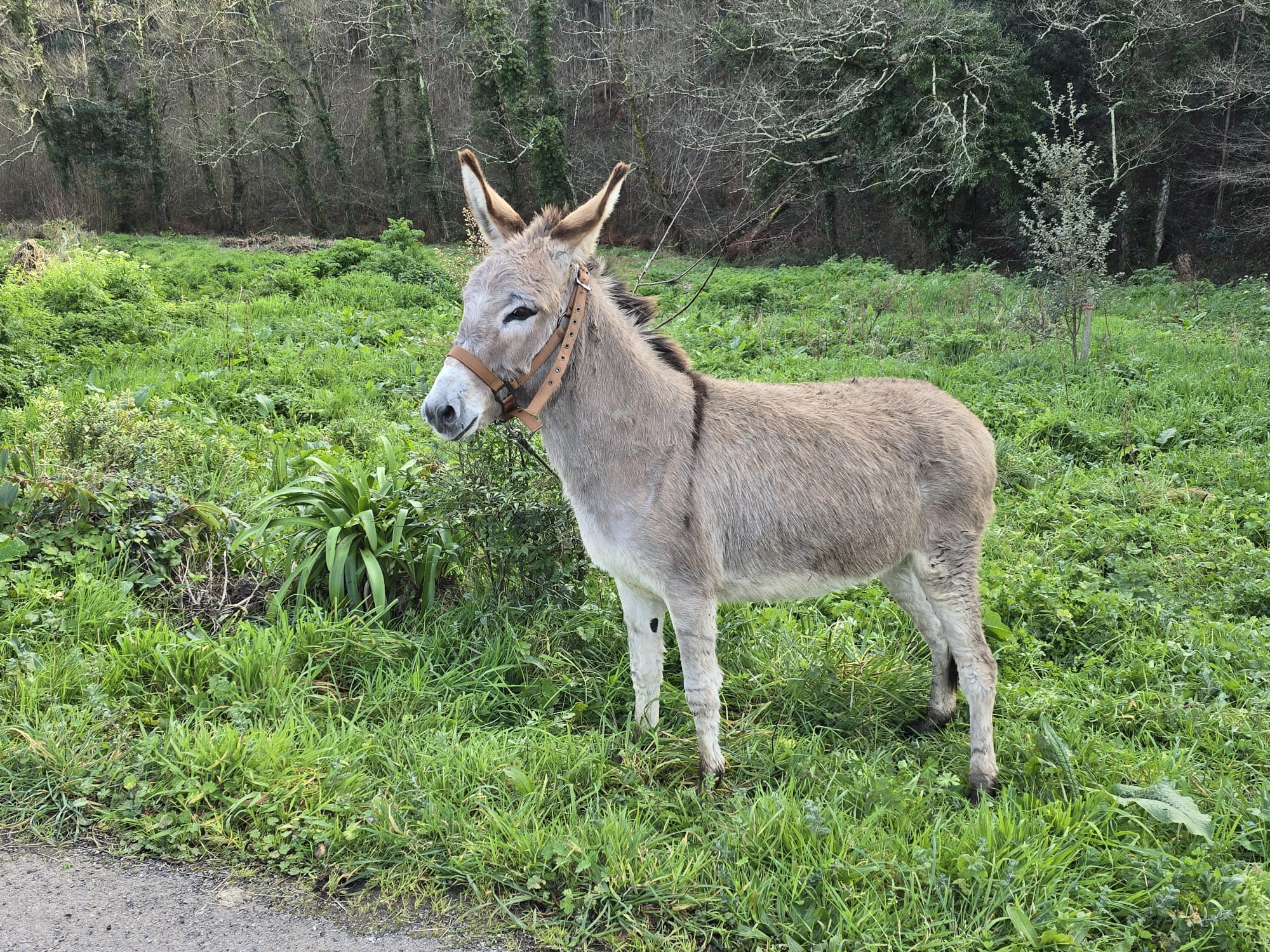
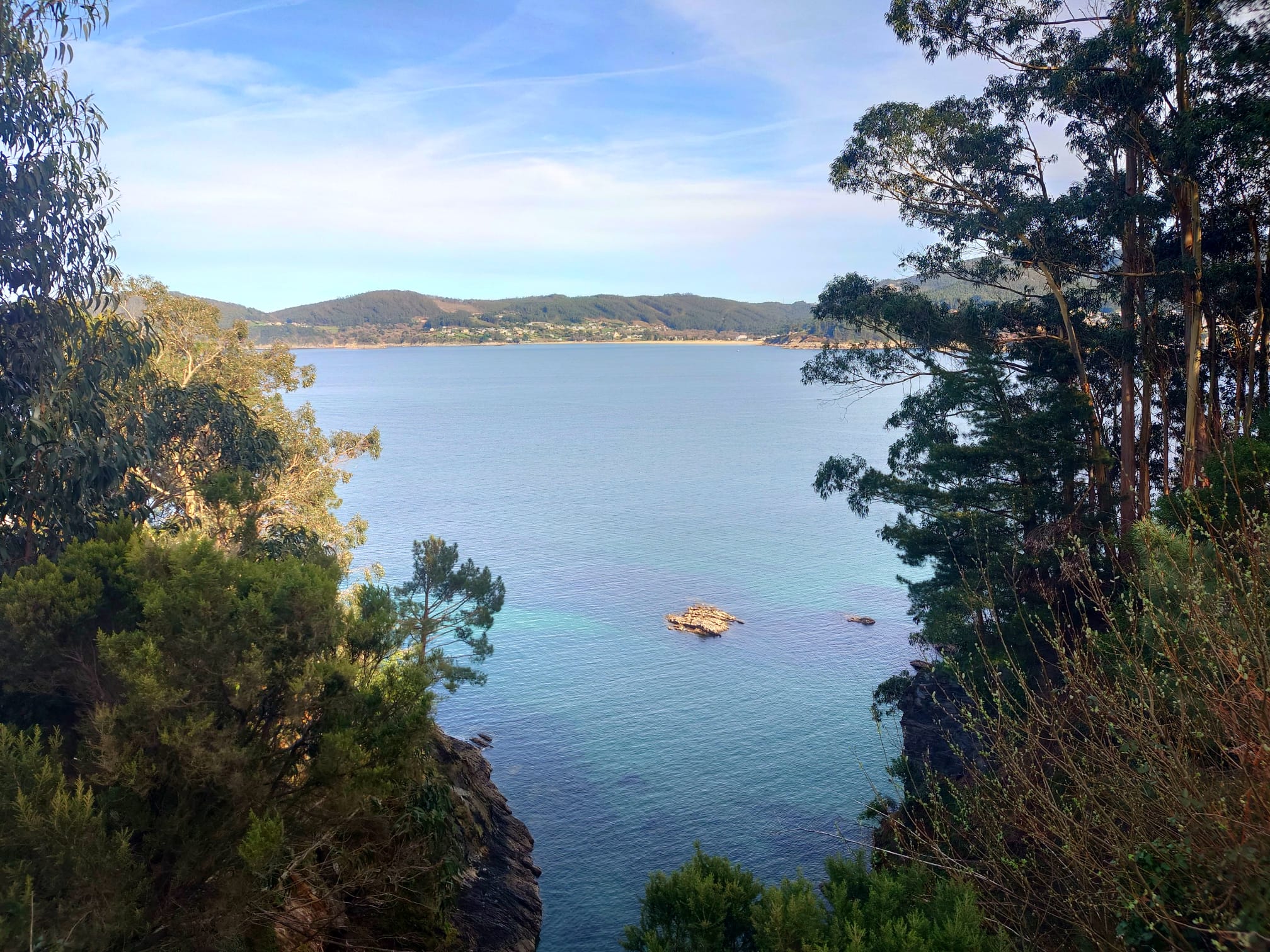
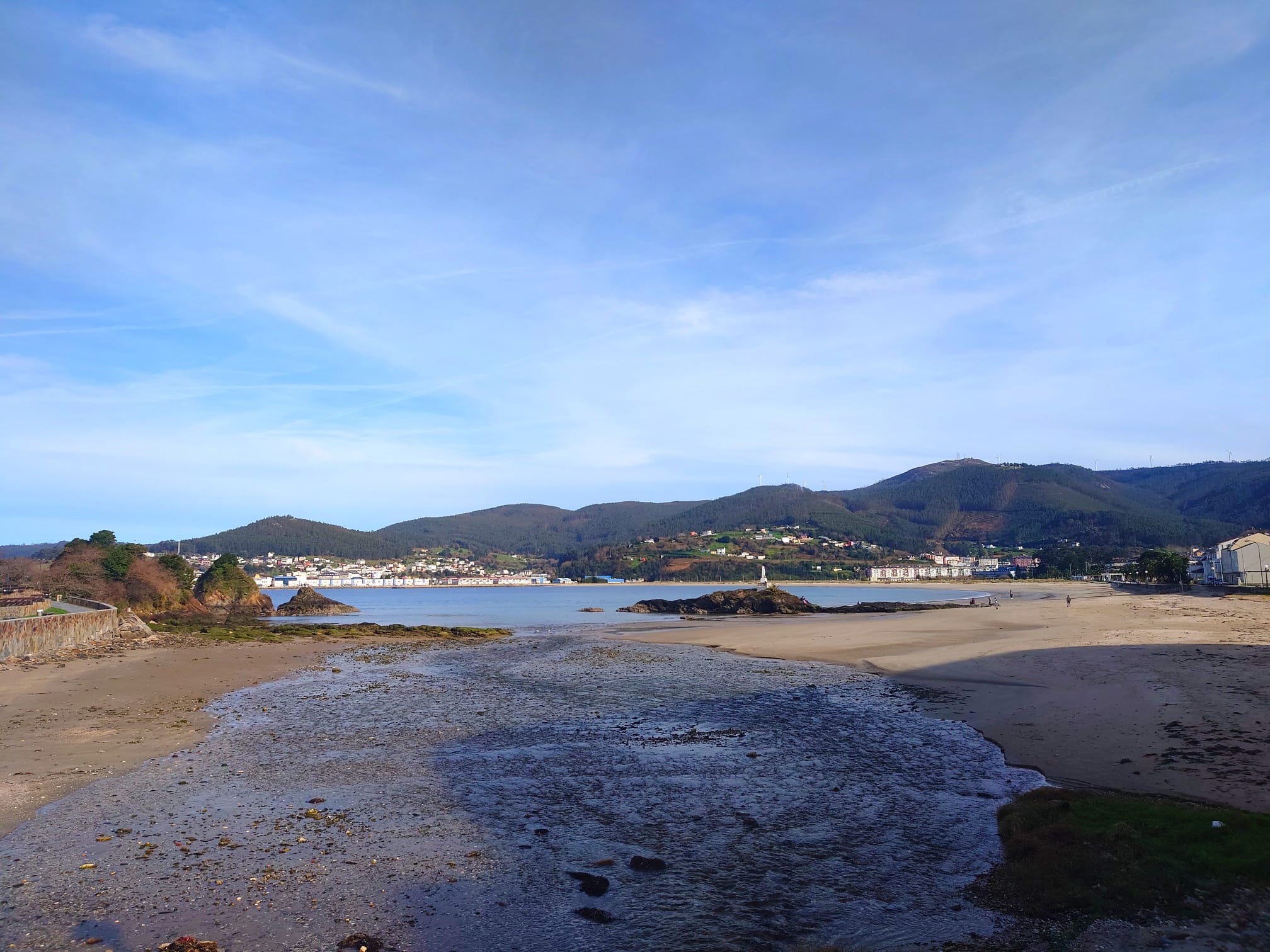

When we get to the marina, some packages from Amazon have arrived… some electronics for Wim’s experiment with external batteries for the scooters. And so begins project “Super Scooter”, hopefully taking us further than our scooters have ever gone before! Stay tuned for the upcoming post with details!
The Captain’s Log (T+231,232,…244) – the complete story
February 5 – Sailing to Ribadeo
We have left Puerto de Cudillero and we sail to Ribadeo today. Here are a few last pictures of Cudillero, sent to us by our neighbor boat, the “Antares”.

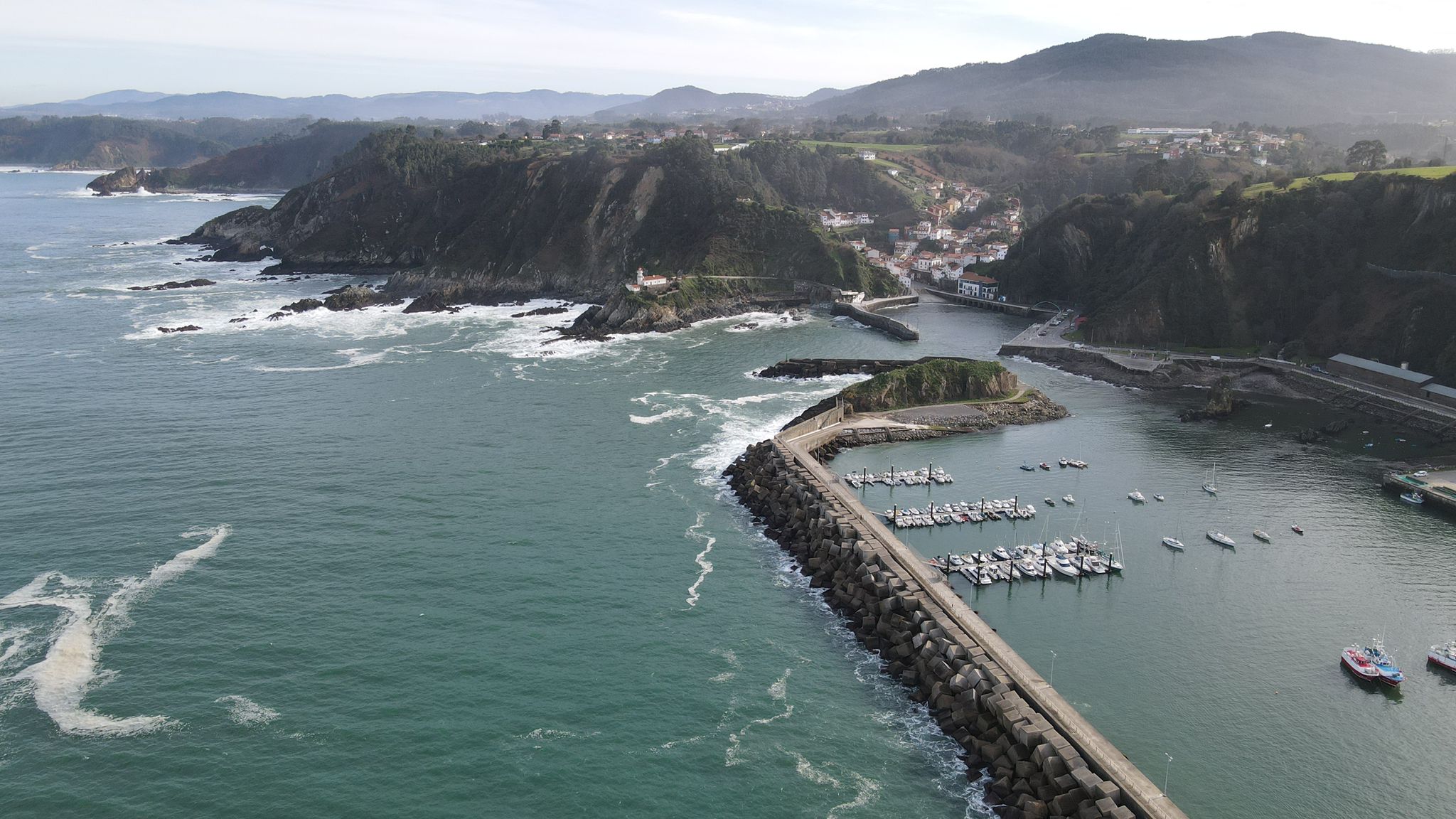
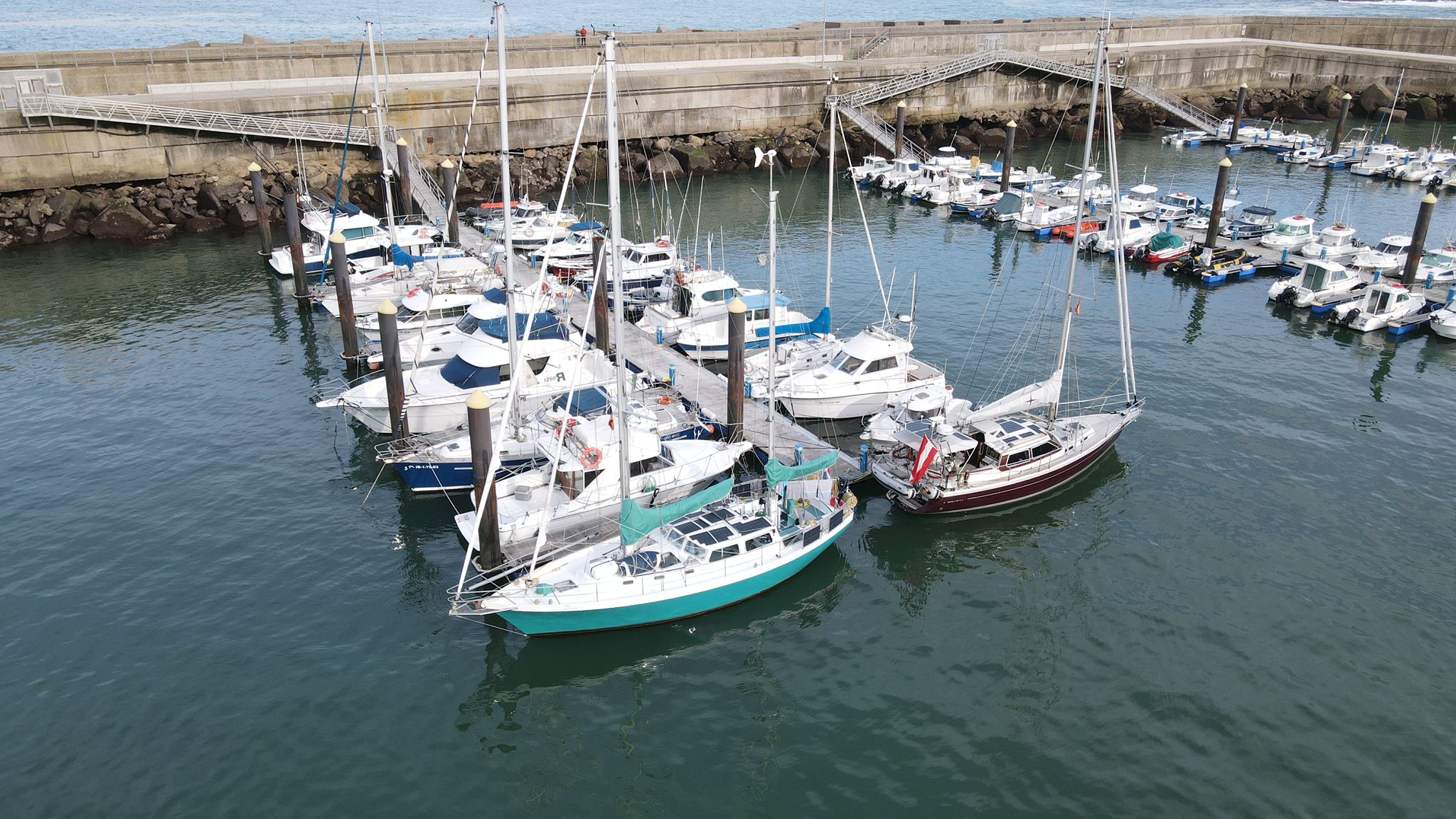
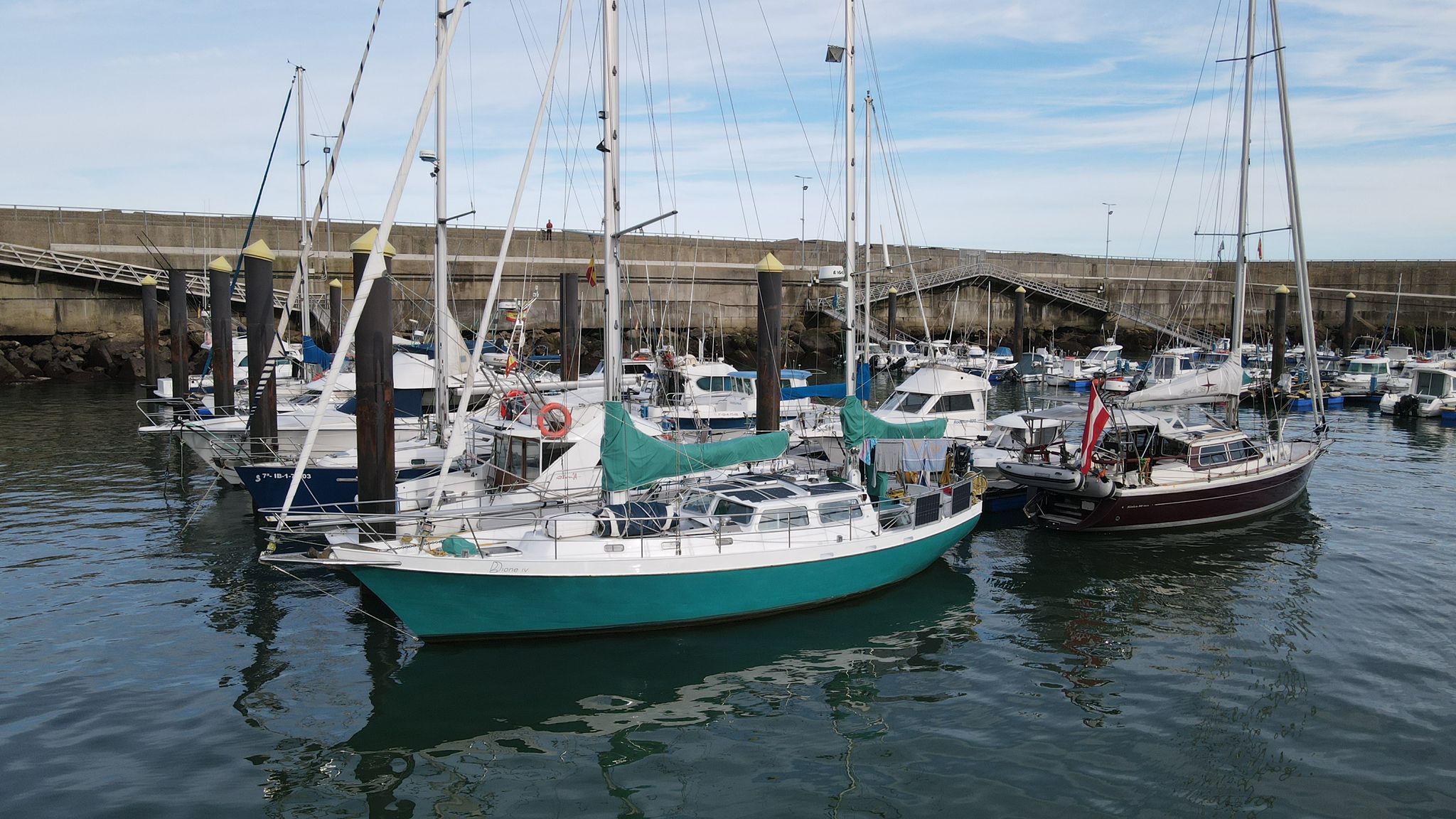
Ribadeo is a 40 sea miles sail. In the morning, there’s no wind so our Marvelous Mighty Mitsu pushes us West. There’s a big swell (2-5m) from the northwest but these large, long hills of water don’t bother us. However, on top of the swell, there are wind waves from the northeast that cause us to roll. We lower our centerboard all the way down and we hoist our mizzen sail to stabilize Dione IV a bit… but it is a restless sea.
We notice we are moving a bit slow. We have to throttle up to 1400 revs to reach 5 knots of speed. Normally 1200 should be enough for 5 knots. The prop is clean, we can see that from the diesel consumption: 3L/hour is normal for 1400 revs. So, the growth on the hull seems to slow us down. There’s a layer of about 5mm slimy weed on the hull. We will have to clean this. Another diving job…
The Austrian boat “Antares” left Cudillero a short time after us and they motor a bit faster than we, so they overtake us and shoot this nice video:

You can see the enormous swell in the video: our mizzen mast, that’s about 10 meters, almost disappears behind the wave! Of course, the Antares is in a trough and Dione IV is in a trough as well, so both of us are 5m down and the top of the wave is 5m up.
After lunch, the wind picks up: 15 knots from the north-east. We set full sail and turn the engine off. The sails stabilize Dione IV and that feels a lot better.
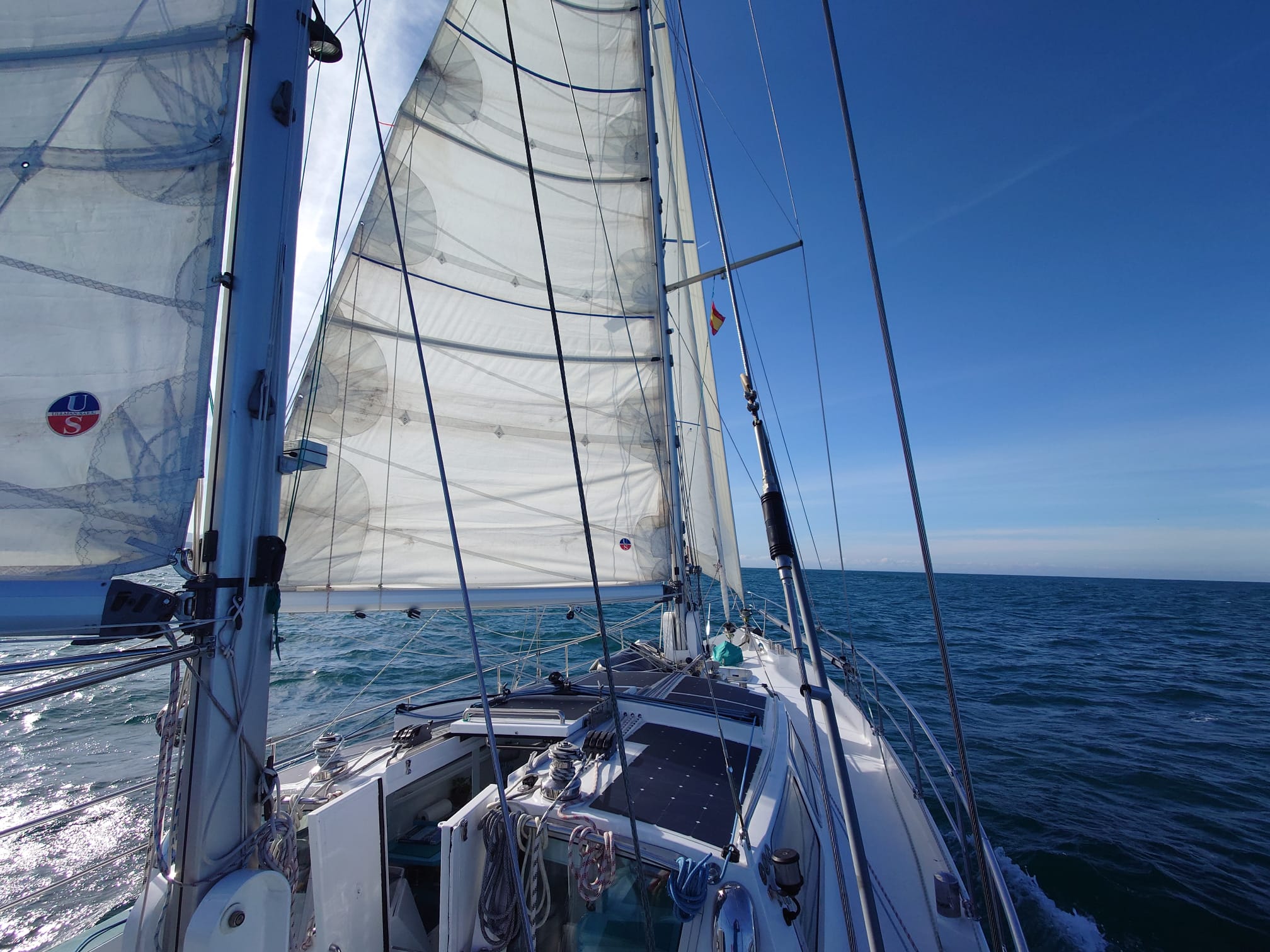
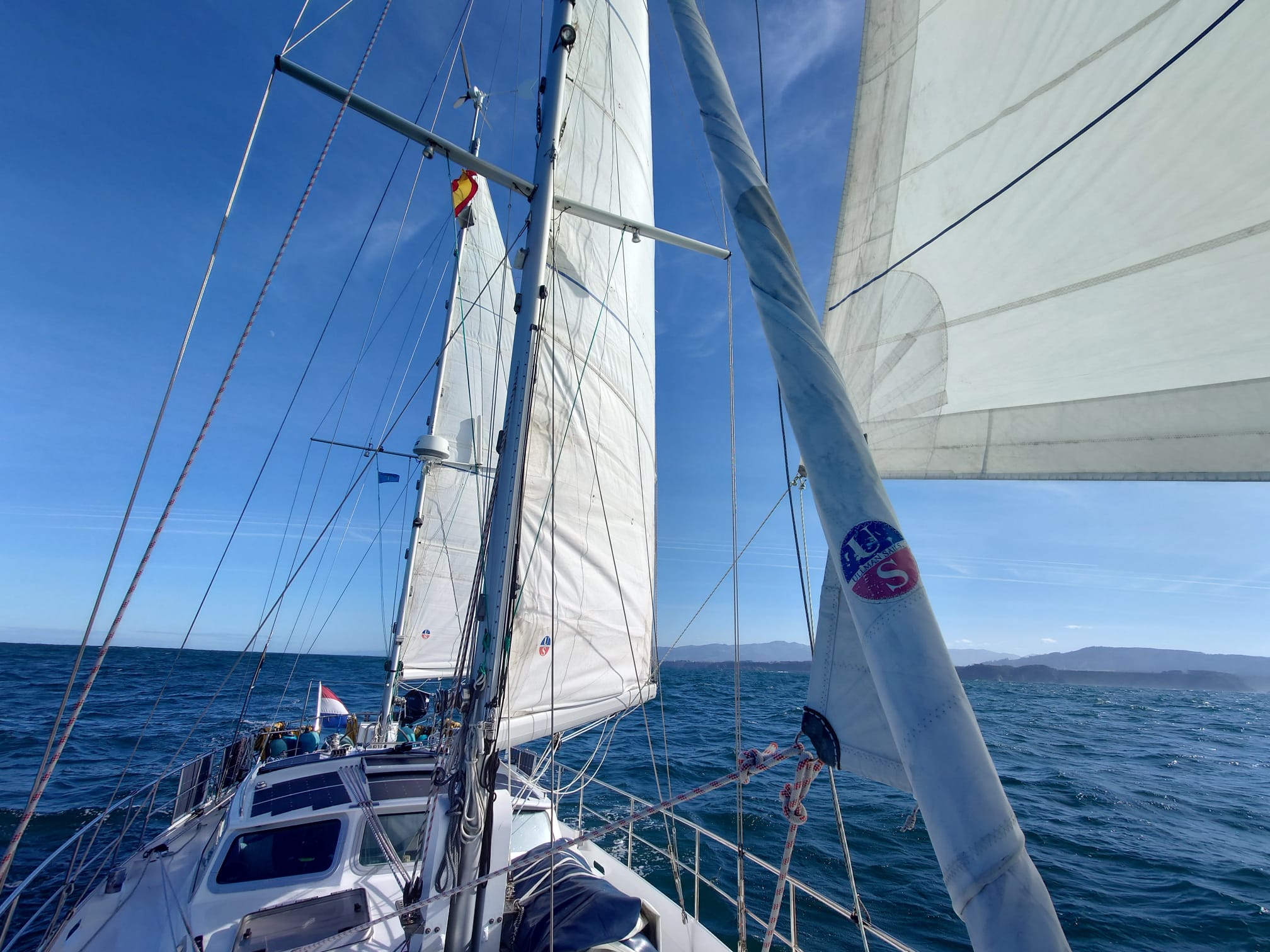
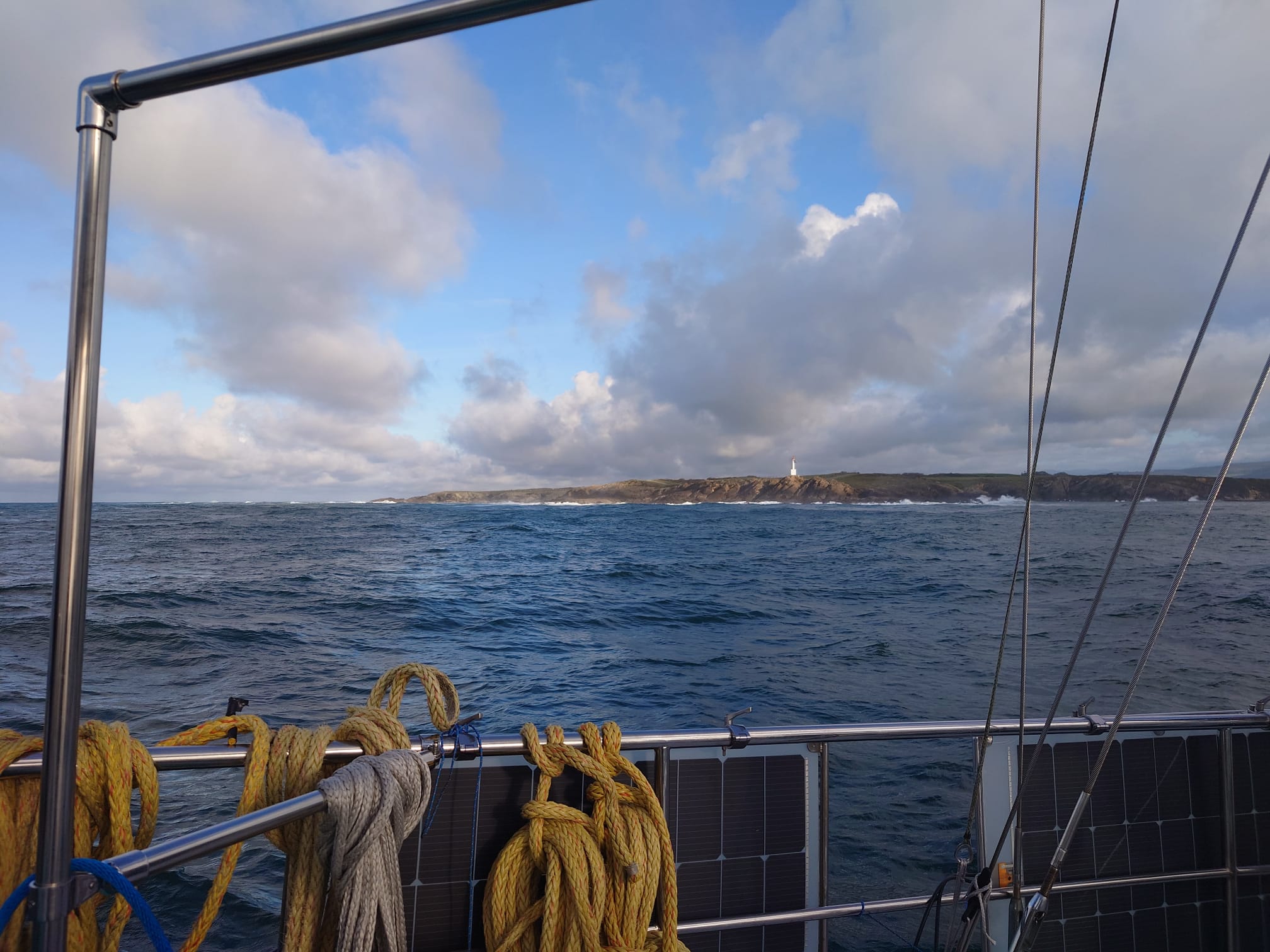
We do 5-6 knots in this wind and sail along the beautiful coast and capes. At the capes, sometimes a beautiful gannet gracefully soars by.

Around 4 o’clock, we enter the Ria de Ribadeo. In Spanish, “Ria” is the estuary of the river. The river itself is called “Rio”.

Although the swell eases down on the shallows of the estuary, it breaks heavily on the rocks left and right of us. But we have a nice smooth entrance.

We pass under the bridge that is 35 meters high, that’s twice our mast height but it always looks like our mast is going to touch the bridge, before we pass it…

After the bridge, we turn in the marina. The river is the border between the regions of Asturias and Galicia. So, we are now in Galicia! And what a reception! The Antares is already there to catch our dock lines and 2 guys of the marina help with the lines! It was a long time ago that we had such a warm welcome! Ingo and Marleth invite us for an Austrian “Anlege bier” (anchoring/arrival beer) and we have a lovely evening at the Antares 🙂
February 6 – A lovely day in Ribadeo and some TLC for Terrific Teal Coffeemaker
In the morning, we take apart our Terrific Teal Coffeemaker. It is steaming a lot and the hot water isn’t flowing well to the coffee filter. We have already tried to flush it with vinegar but it doesn’t seem there’s much limestone in it. So, it needs more investigation. It appears there are some particles stuck in the one-way valve. After cleaning that, he’s okay again! This fantastic coffeemaker has served for 10 years already and we have a spare one. We were almost thinking to exchange it with the spare this time… But no! He survived again and continues to make delicious coffee for us!
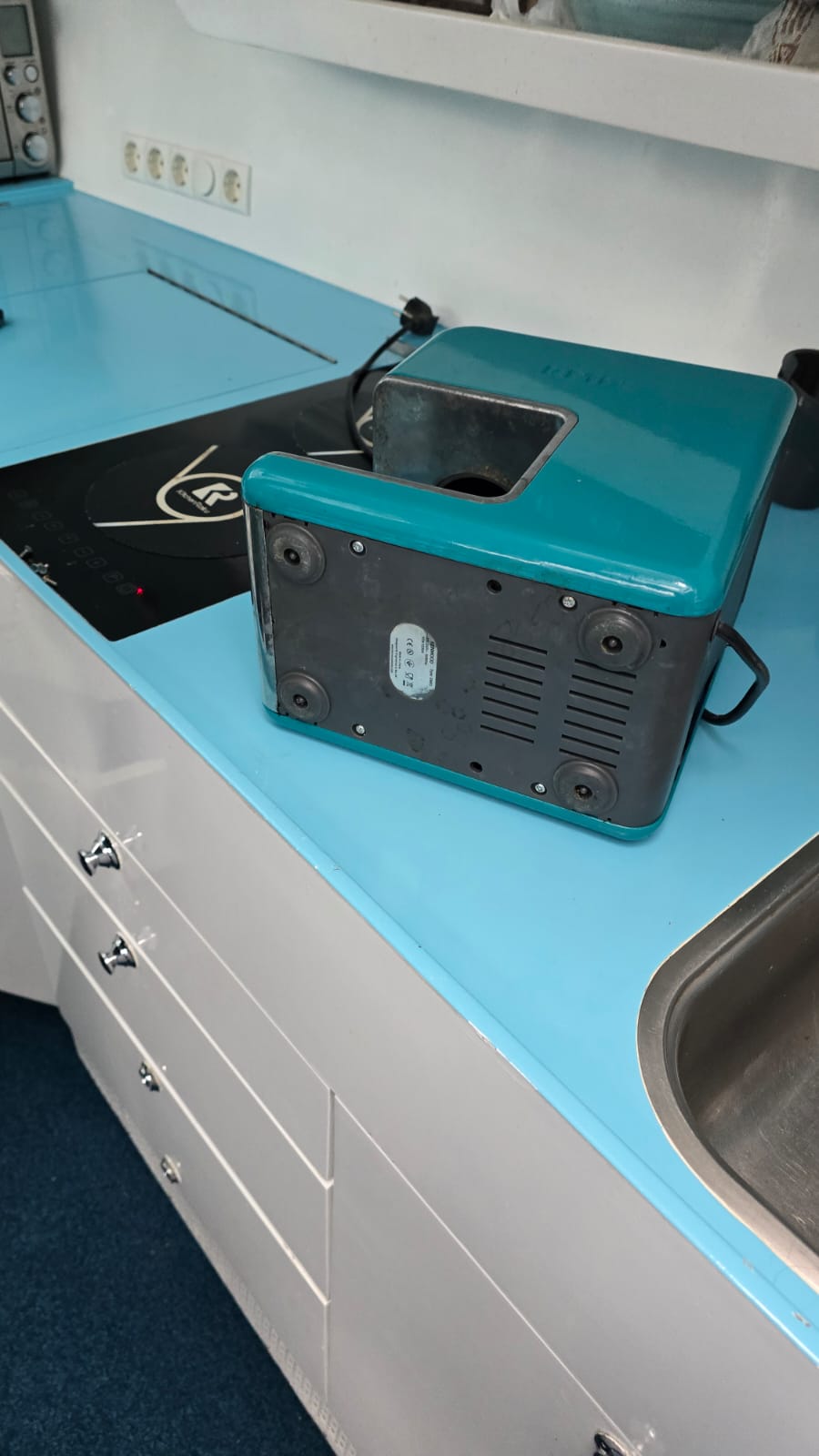



In the afternoon, we take a hike to the lighthouse at the entrance of the estuary with Ingo & Marleth of Antares. Great views!



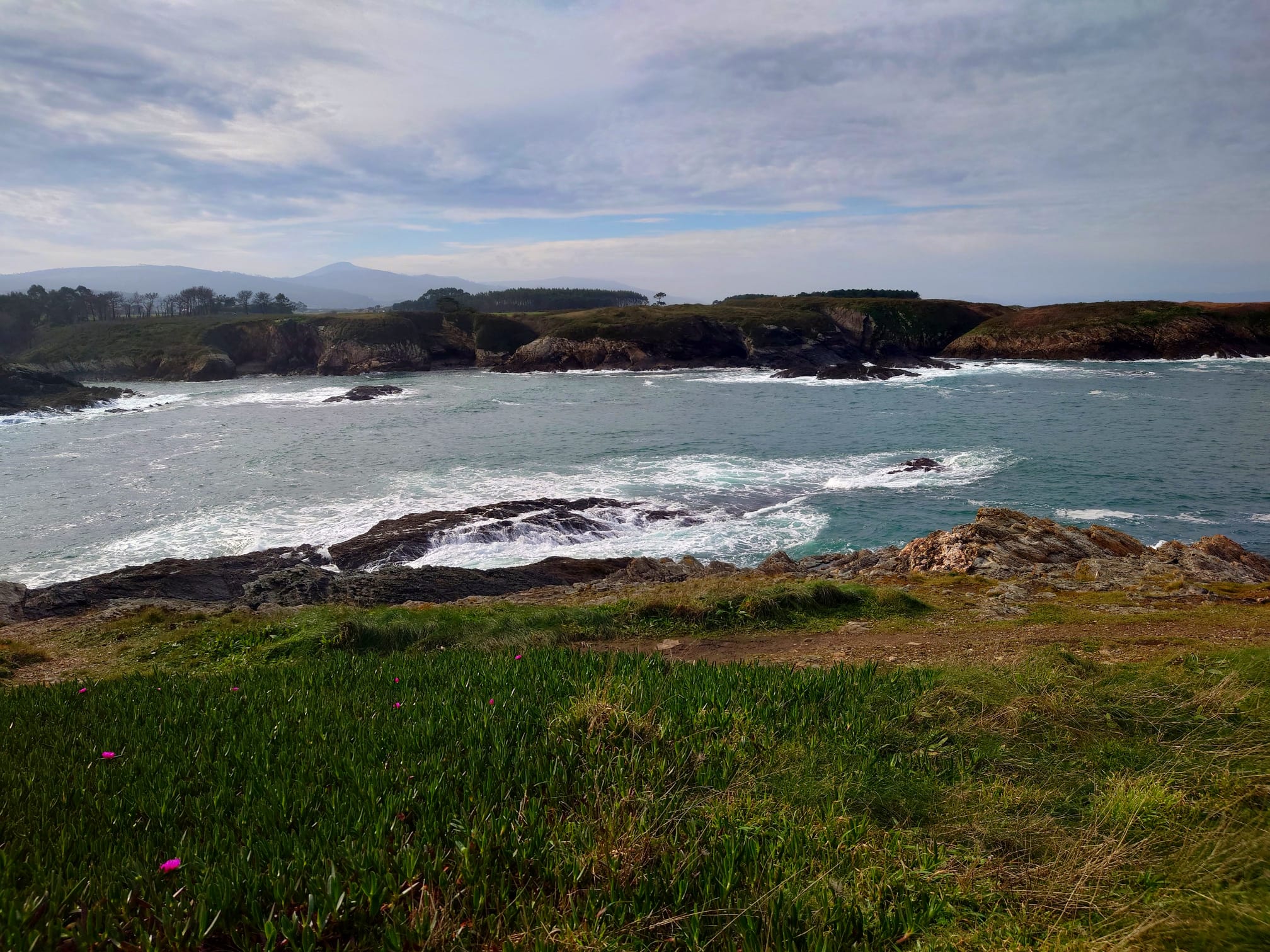

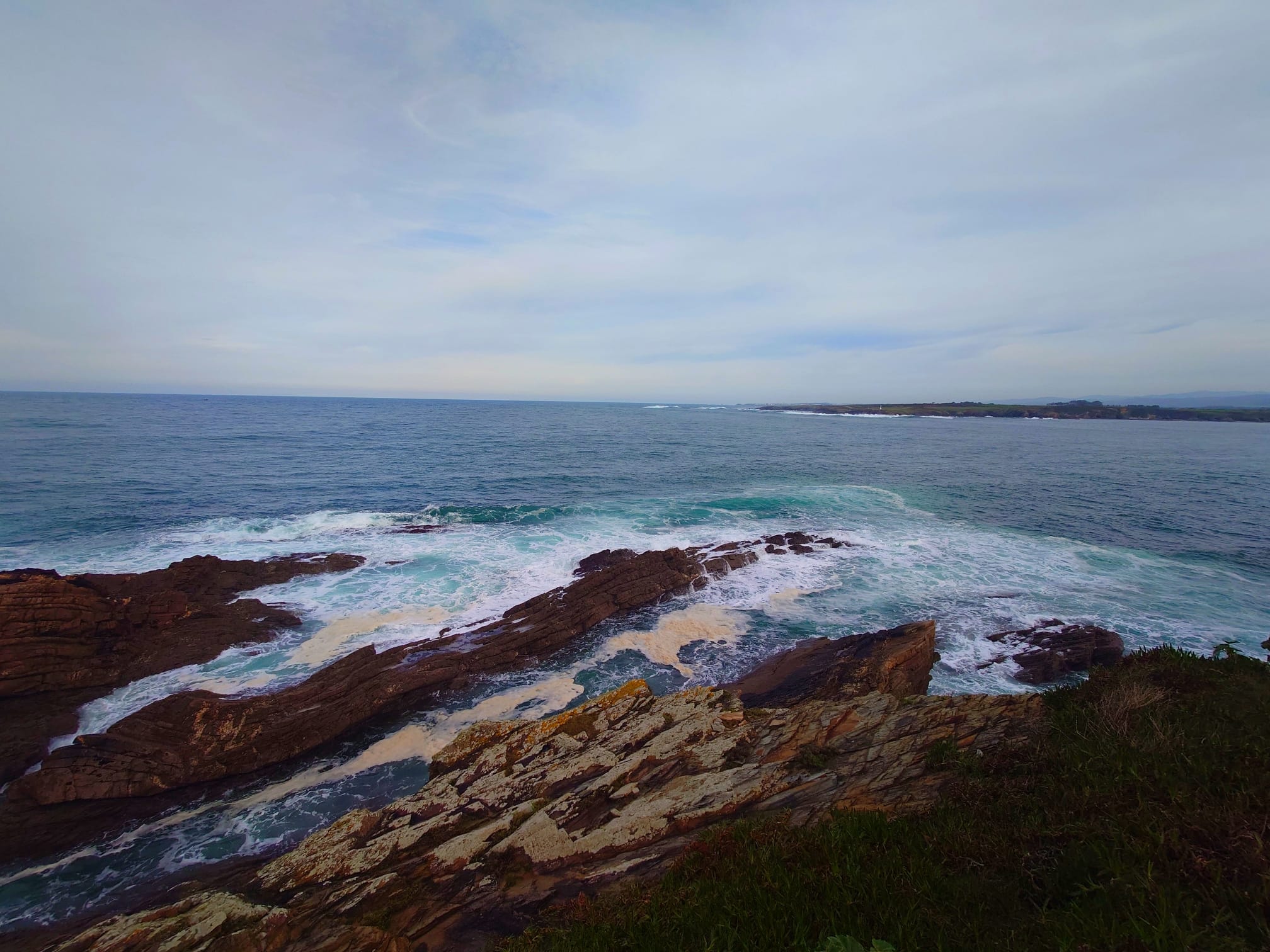


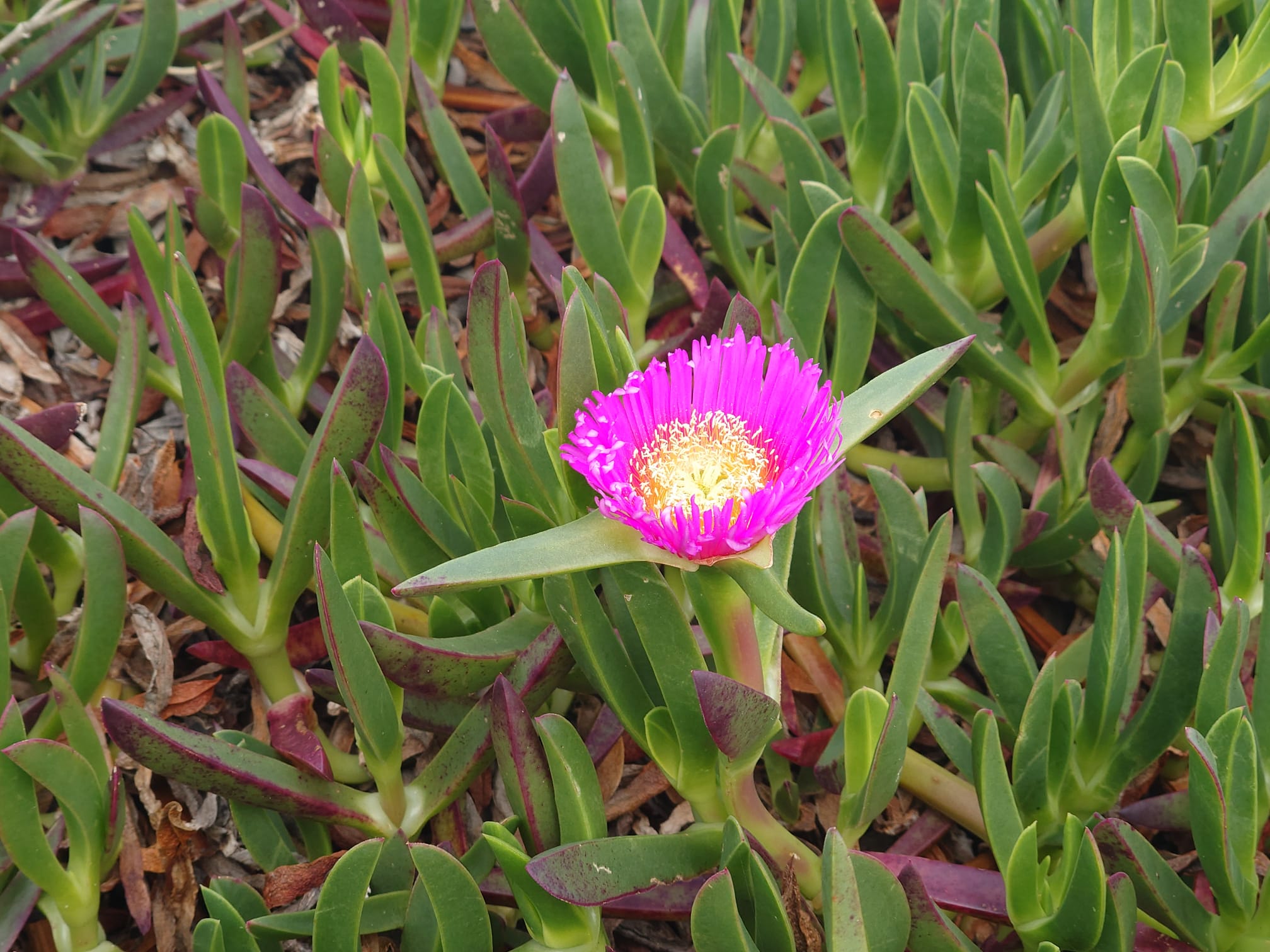


After that, we take a walk through the town of Ribadeo. No, this isn’t the most beautiful town we’ve seen… Hmmm. Actually, we realize we’re totally spoiled after Cudillero…
We have a beer in a pub. Yes, we are in Galicia so what else than Estrella Galicia can we drink??

For dinner we make a super delicious “Mujadara”, poor man’s food in Arabic. But we feel like the richest couple on earth! 🙂
February 7 – on to Viveiro!

The weather forecasts are reasonably good so we move on to Viveiro today.
At 0830h, just before sunrise, we leave our berth.

As we have passed the bridge, the sun rises. It’s cold: only 4ºC. Sher dresses all warm clothes she could find and Wim wears his “Fladen” Norwegian fishermen’s survival suit.

We hoist the sails and set course to Viveiro. There is 10-15 knots wind from the south-west, a nice beam reach.
When we cross the wide bay to the cape Cabo Moras, the wind increases to 20-22 knots. Dione IV at full speed but because the wind keeps increasing and we don’t know if will increase further, we pull a reef in the main and furl-in the yankee a bit. But once we get closer to the cape, the wind decreases, and we pull the reefs out. Once we reach the cape, the wind has completely gone and we start the engine.

At a cape, everything changes, as we always say…
And what else at a cape? Of course: the ones who are crazy about capes! Hovering on the wind. Le fou du cape, in French. The beautiful Northern Gannet 🙂
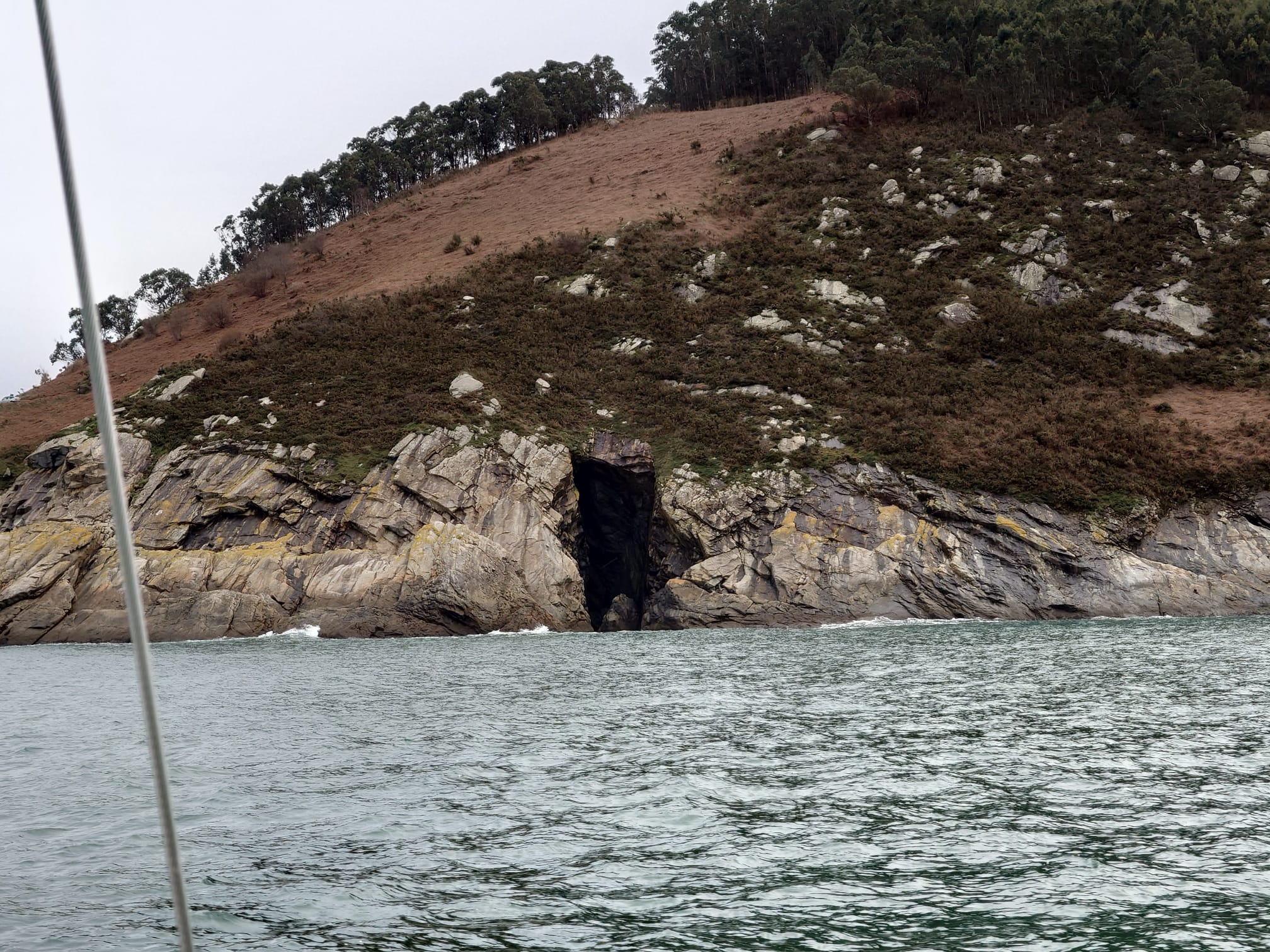
Once we enter the Ria, the wind is on the bow so Marvelous Mighty Mitsu has to push us into the estuary and into the town of Viveiro.

3 o’clock. Arrived in the marina de Viveiro. It feels like a milestone. For Wim, because for two consecutive years he tried to sail here (from The Netherlands) but didn’t get this far due to unfavorable weather conditions in summer and for the both of us because this is where our Cruising Galicia starts! The famous Spanish Ria’s. Cruiser’s paradise, many say.
The Antares is already there and together with a German couple which was already for some days at the pontoon we have an “Anlege bier”. Cheers! 🙂
February 9.
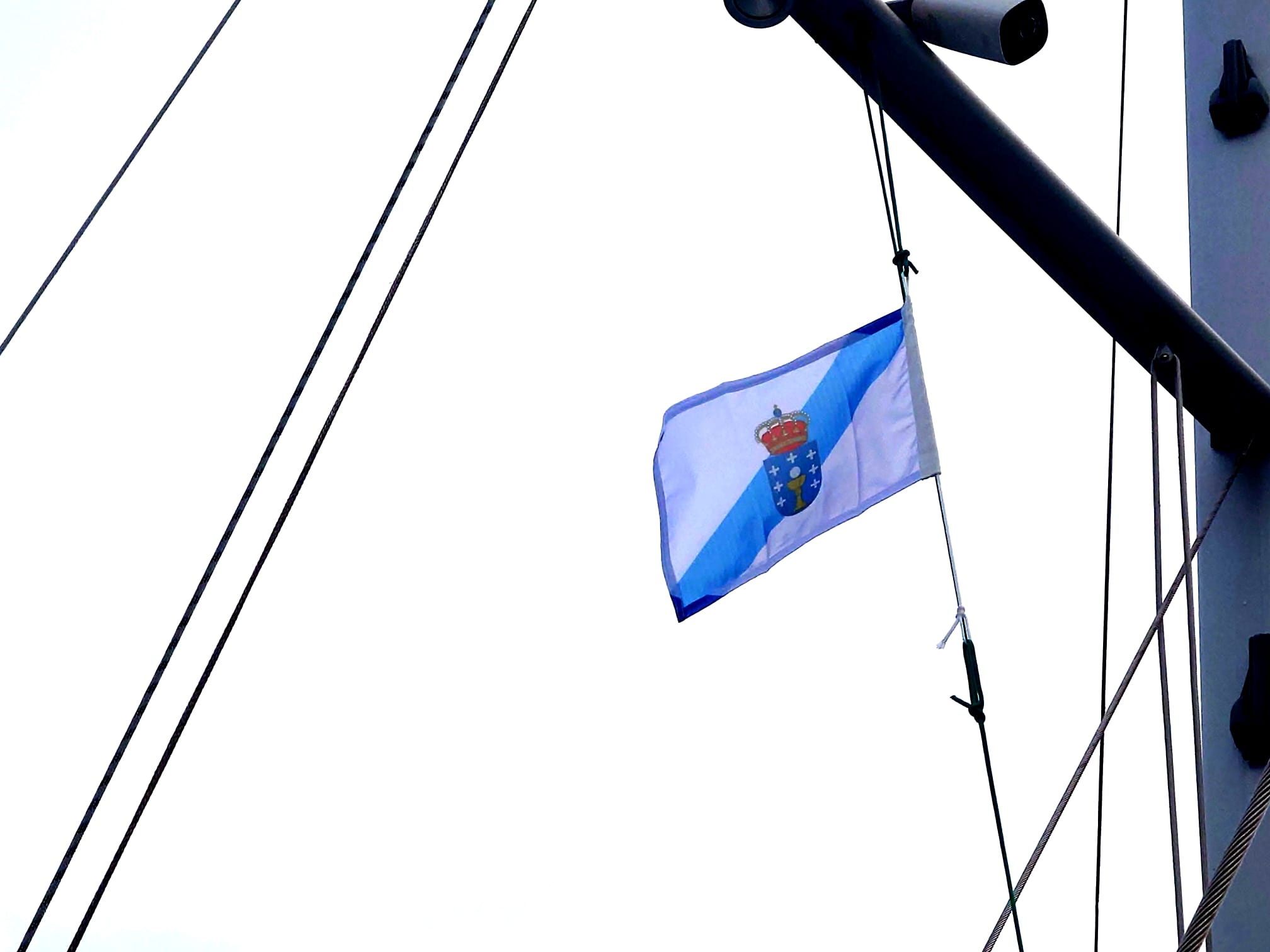
A rainy Sunday. We do 3 loads of laundry, register at the marina office and buy our Galicia courtesy flag!
February 11.
The marina asks us to move to another berth so, we move to the other side of the pontoon. This is a much better place. We were stuffed up between two big ugly motor boats. Now, we have a better view, more light, more sun!
It’s a lovely day, temperature 20ºC. We do some provisioning at the supermarket which is right opposite of the marina, very convenient!
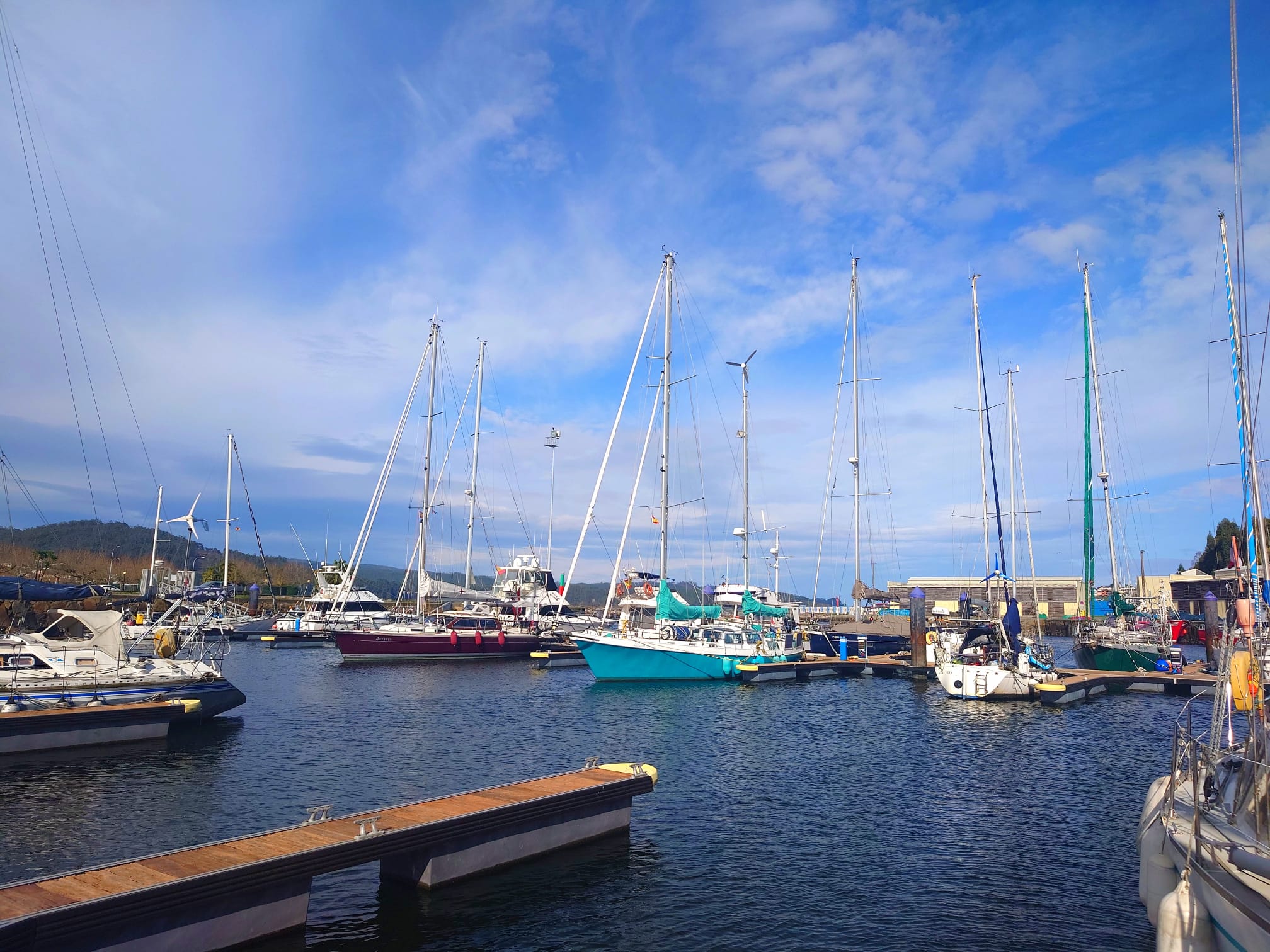
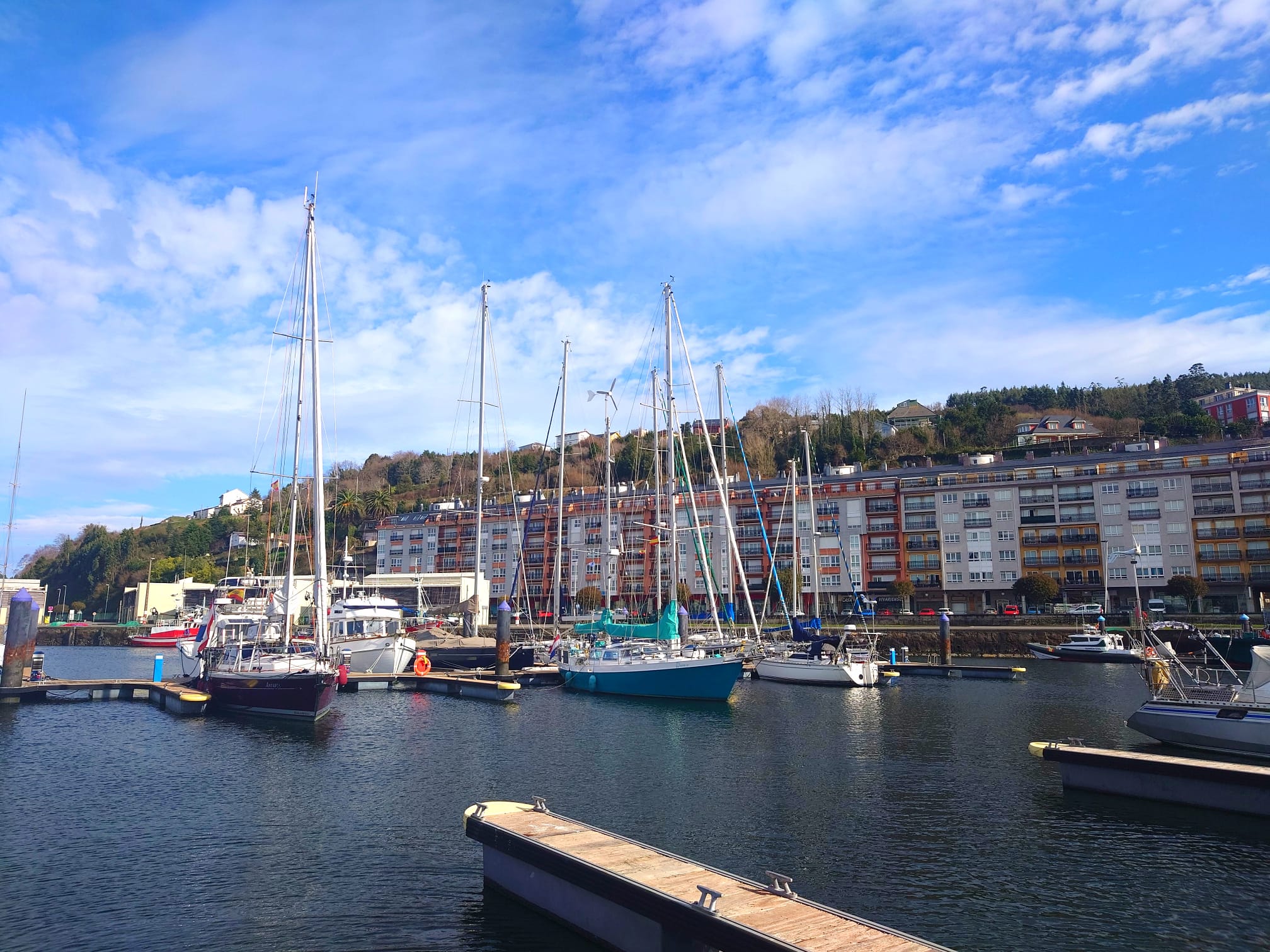
February 14.
Valentine’s day. Sweetheart’s day. For us, this is no special day because every day is Sweetheart’s day 🙂
The weather is slightly variable, the last couple of days. Sometimes some wind, sometimes a little rain, sometimes some sunshine. But the temperature is nice: 15-20ºC.
An item that is on our to-do-list already for a long time is installing some LED’s at our diesel day tank and day tank filling system.
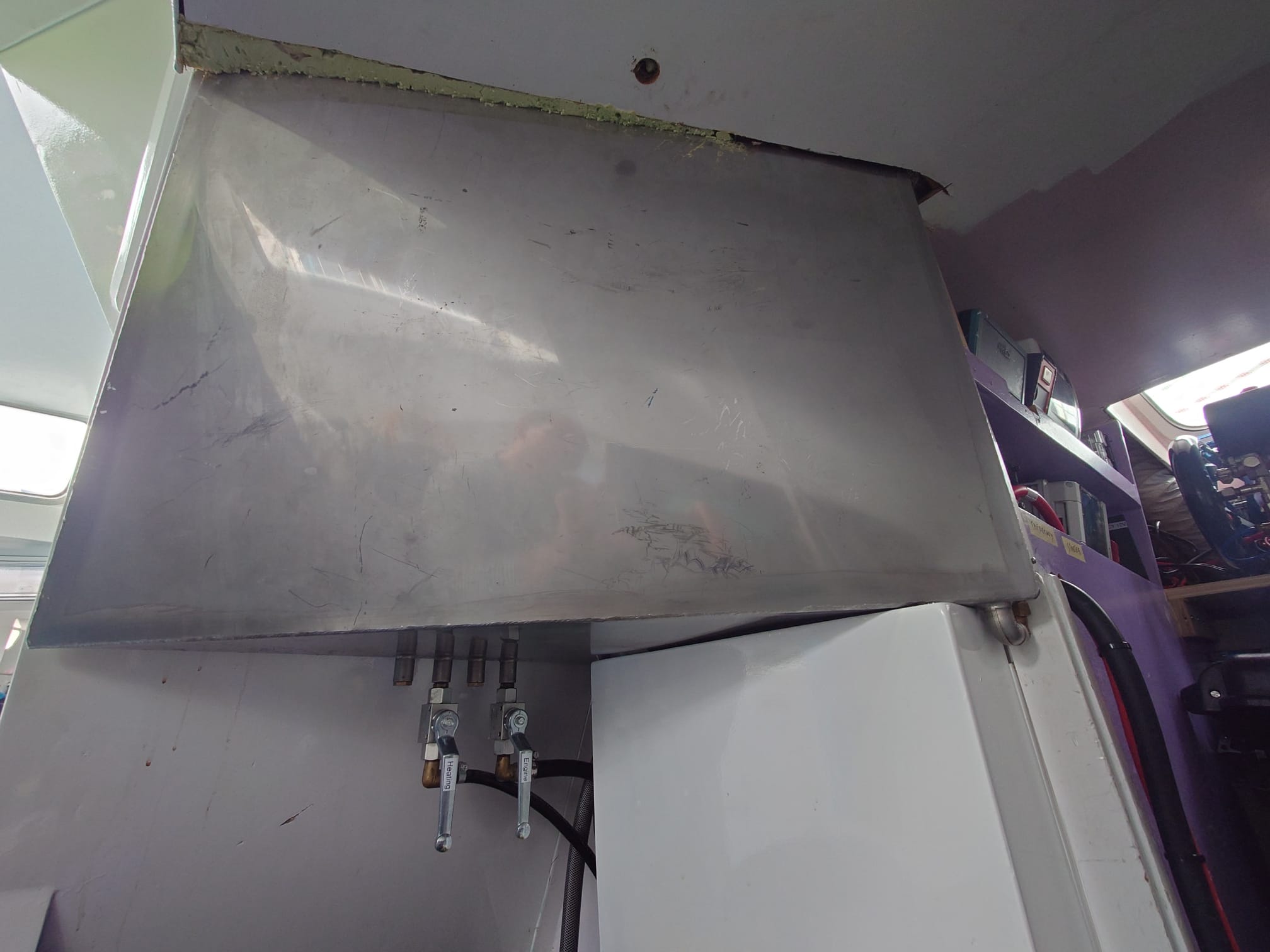
We have a triangular-shaped 60 liter day tank for diesel which hangs under the bridge-deck (below the companionway). Using a day tank has some important advantages:
- There’s 60 liters of guaranteed clean diesel. Should our main diesel tanks (two, each 500L) get contaminated with for instance, dirt, water, bad diesel, bacteria, etc. we have 60L to reach a port. 60L is about 24 hours of motoring, about 120 sea miles.
- Because the day tank is positioned above the engine and heating devices, no air bubbles can enter the fuel pumps. Even a tiny bit of air in the diesel can stop the engine high pressure fuel pump from functioning and thus stall the engine. A leaky hose or connection will never suck air in the systems, it will leak some diesel but it will not stop the engine. And, bleeding air after fuel filters change is easy: just open the bleeding screw and wait till diesel flows out.
- The tank has a simple old-fashioned gauge glass to see the diesel level. No electronic level sensor. It has to be extremely rugged and reliable.
- We fill the tank from the main tanks via an electric fuel pump with a redundancy system (second pump as spare, fully functional installed). The diesel from the main tanks is filtered (one coarse filter and one 5 micron filter) before it goes into the day tank. This is called fuel polishing. Because the filters have glass jars for water separation, we can check the color of the diesel, possible dirt or water. Because the light under there is a bit bit dim, we use a torch to see it. Now, this is where a little improvement could be made: LED’s behind the glass jars and behind the gauge glass.
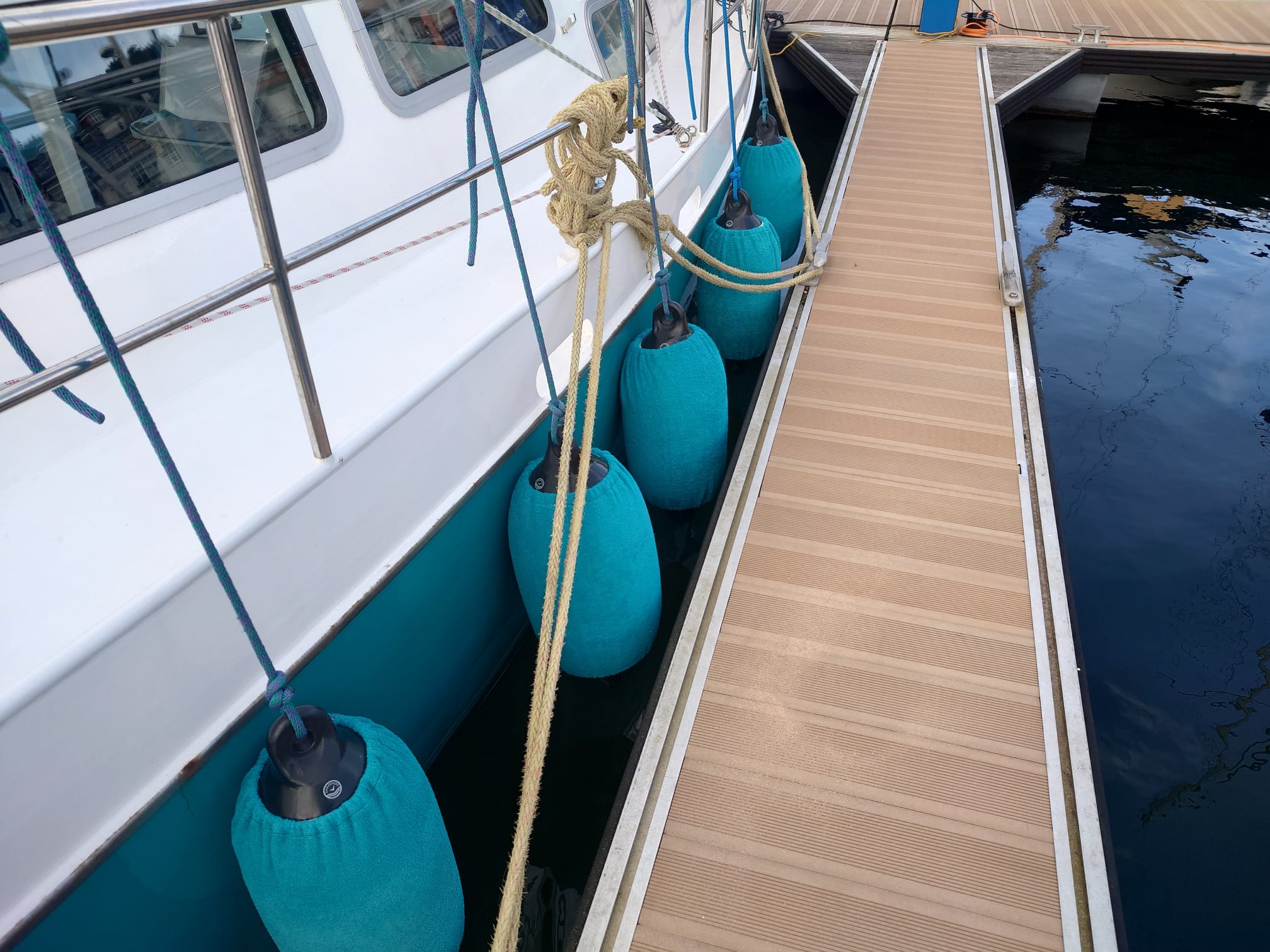
They look beautiful!
Our Austrian neighbor (Ingo) said: your boat fenders will be very happy, wearing such nice pajama’s, hahaha! 🙂
February 15.
A lovely sunny day for a scooter ride. We decide to go to the viewpoint near de lighthouse on the cape “Punta de Faro”.
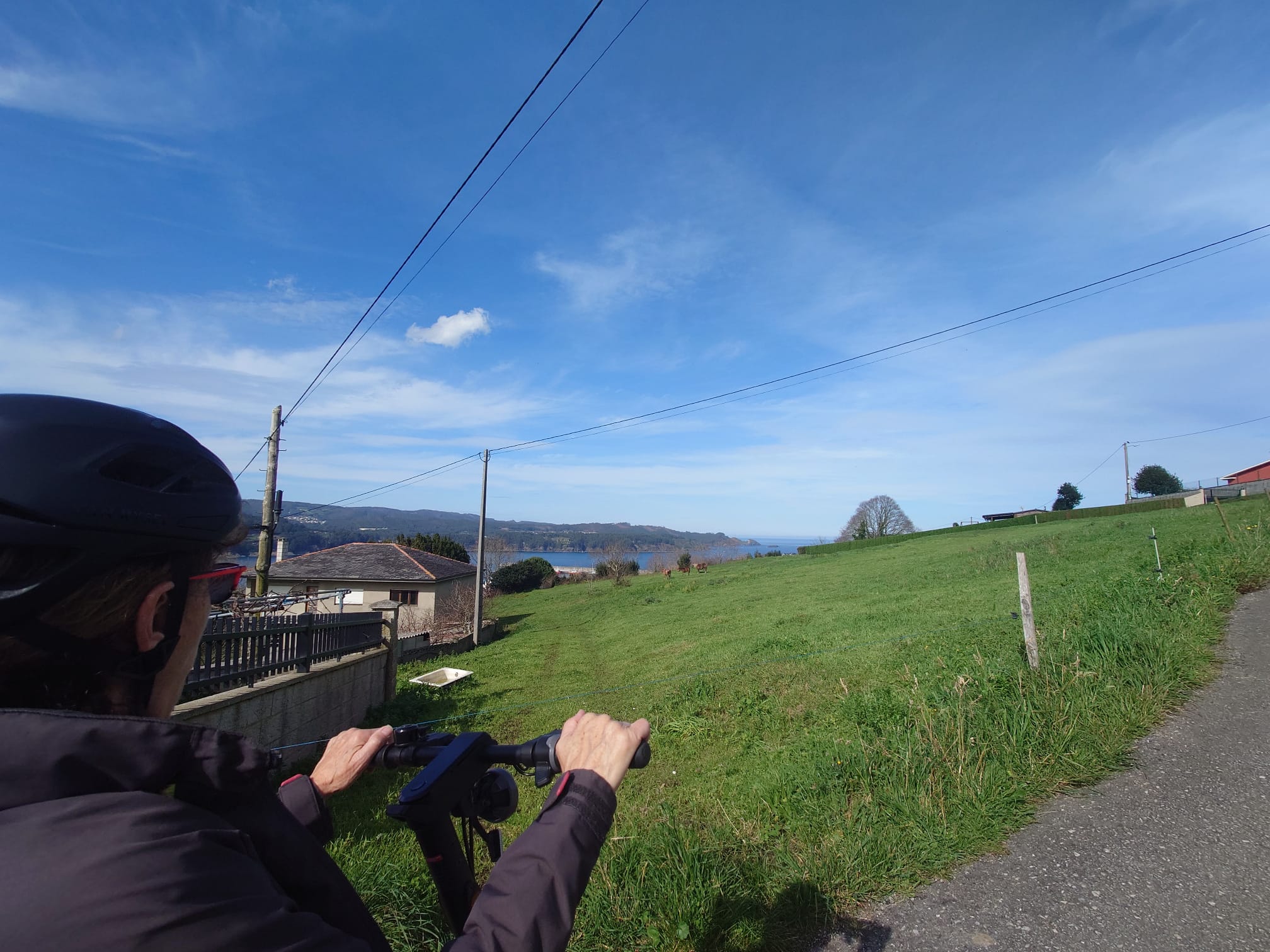
We take the small roads over the hills and through Eucalyptus forests.
The route to “Miradoiro do Monte Faro” is about 10km’s. It has a lot of steep hills and we already know that takes a lot of energy from the scooter’s batteries. So, to save energy we walk up hill and let the scooters cruise control at 5km/hr so that we don’t have to push the scooters.
We pass the beautiful beach at the bay “Insua de Area”. This will be a lovely anchorage! At the moment, the weather is a bit too changeable to go anchoring but as soon as the weather gets nice, we will go anchor here!



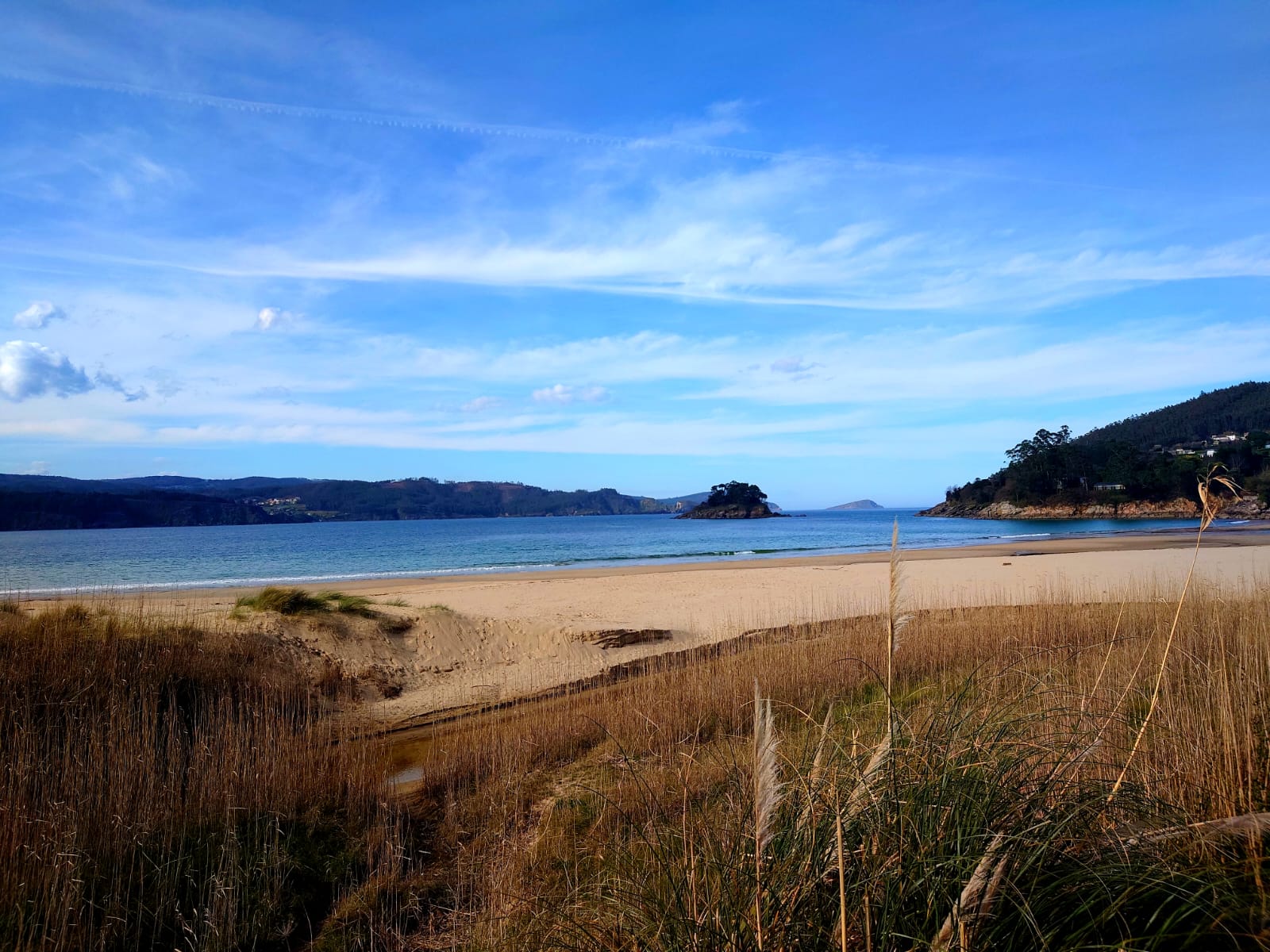
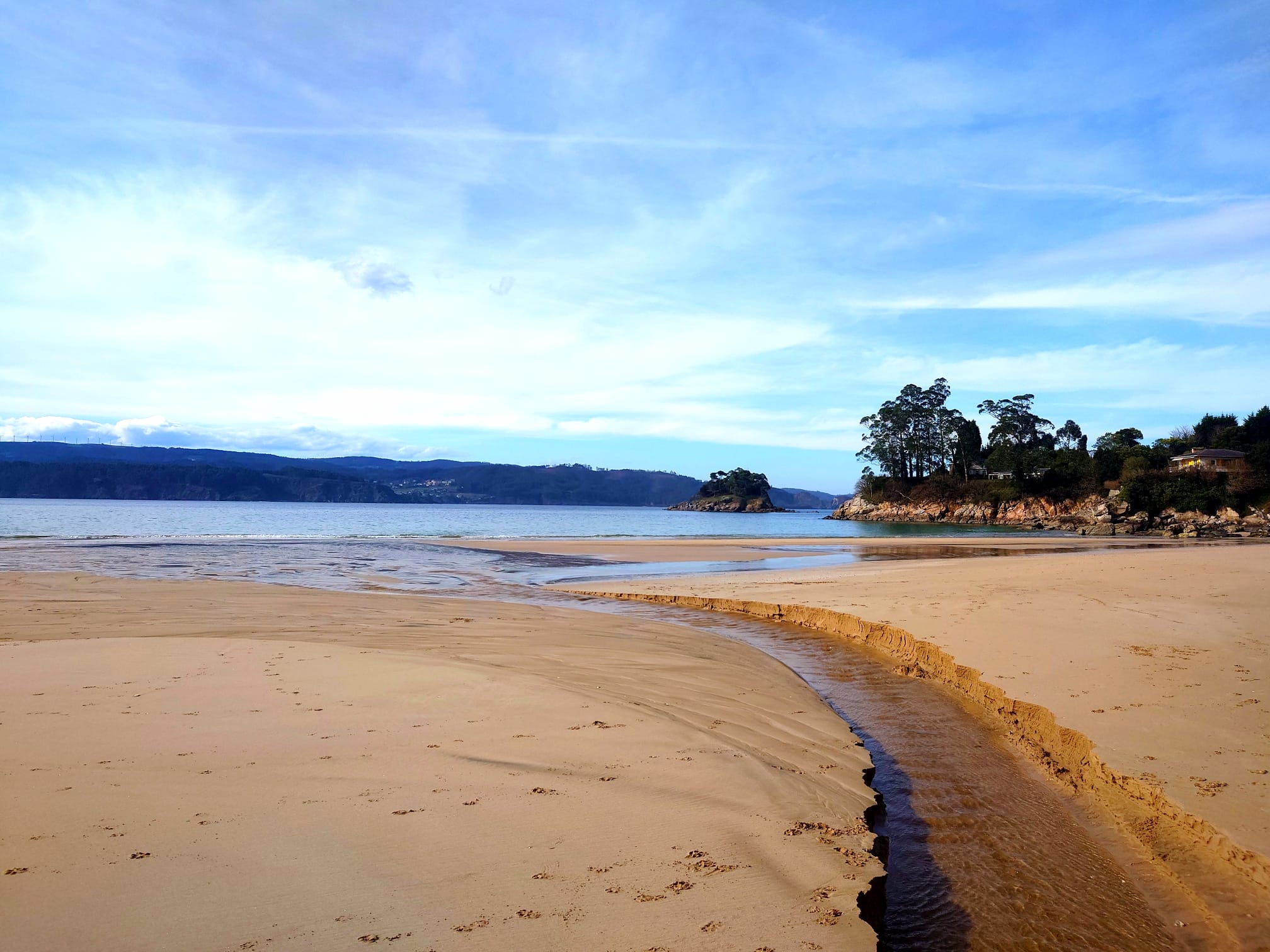
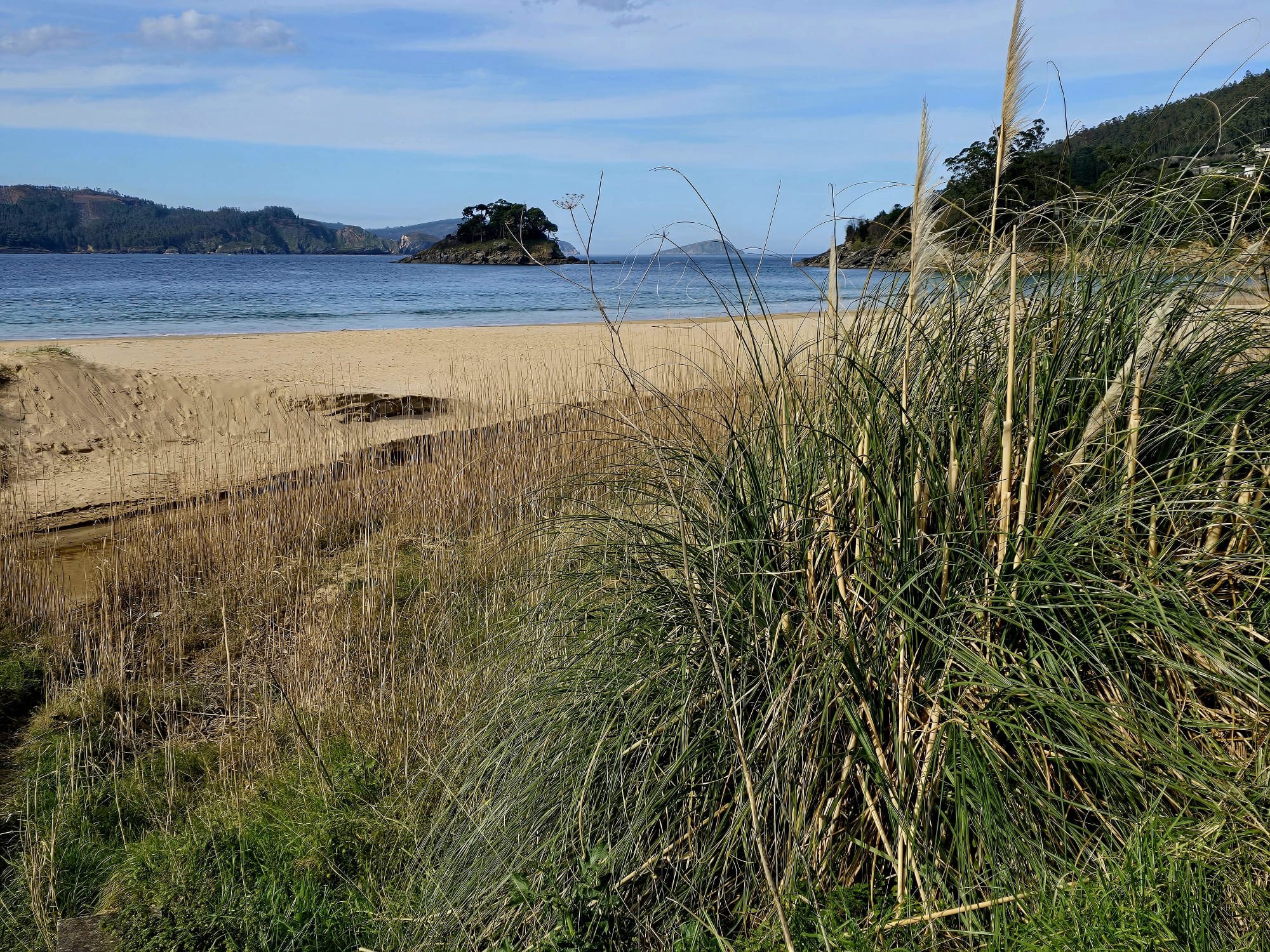
After the “Playa de Area”, we climb up to the viewpoint. With some sweat on our backs we enjoy the lovely views.



Then it goes downhill to the village of Celeiro, a nice fishing vessels port.
On the last few percent’s of battery power we arrive at the marina. Only 50 meters before the gate to our pontoon Wim’s scooter is slowing down and right before the gate the battery is empty! What a timing! Sher has 10% left in her scooter. Hmmm. Wim starts thinking of adding some more battery capacity… Many times, especially in the hills, it has been a challenge to get back home without empty batteries. This needs some research…
When we put the scooters back on board to charge the batteries Wim notices that the tires are a bit soft. He decides to check the air pressure and takes the pressure gauge out. Oops! There’s hardly any pressure! We start the air compressor and inflate all tires to the advised pressure of 3 bar.

That evening, we have a delicious dinner with Iranian herbs beignets from an Ottolenghi recipe. And with the rest of our Mujadara. Those two Arabic dishes go very well together! 🙂
We enjoy our meals so much. Almost never we go out to eat in a restaurant ashore. Restaurant Dione IV is the best!
And after dinner, at 9 o’clock or so, we watch an episode (of 50) of the Spanish series “La Casa de Papel” (Money Heist). Interesting plot and good for our Spanish language.
What a good life we have!!
February 16.

In the morning, Sher sews new pajamas for our big ball fenders!
Wim is doing some research on how to make external additional batteries for the scooters, to extend our range. He orders some stuff at Amazon. Amazon is really great here in Spain, they have a lot of technical stuff and the delivery to the marina office is smooth and quick.

In the afternoon, we have a lunch in a local restaurant with the other cruisers on the pontoon. Very nice conversations and good food!
After that, we take a long walk together, along the river.
February 17.
A lovely sunny day. Another scooter ride into the hills on the west side of the Ria. We notice the scooters use less energy, at least Wim’s does. Now that the tires are a lot harder than before they seem to roll much more economic! We walk uphill with the scooters at 5km/h cruise control to save battery power and we make quit a long ride (about 20km) but when we arrive in the marina we have 50% charge left!
The landscape is magnificent. Galicia is so beautiful. We take small roads and there’s almost no traffic. Perfect for scootering.












February 18.
A scooter ride in the hills west of the Ria. We take another road than yesterday. Wim thought there was a castle at the top of the hill but it appeared to be a general landmark in Google Maps. Nothing special to see, just a farm… But it was a really nice walk (uphill) 🙂 This is a 25km ride and when we arrive at the top of the hill we have 60% battery power left. After the long down hill track we’re back at 67%. Braking by means of energy regeneration is great!
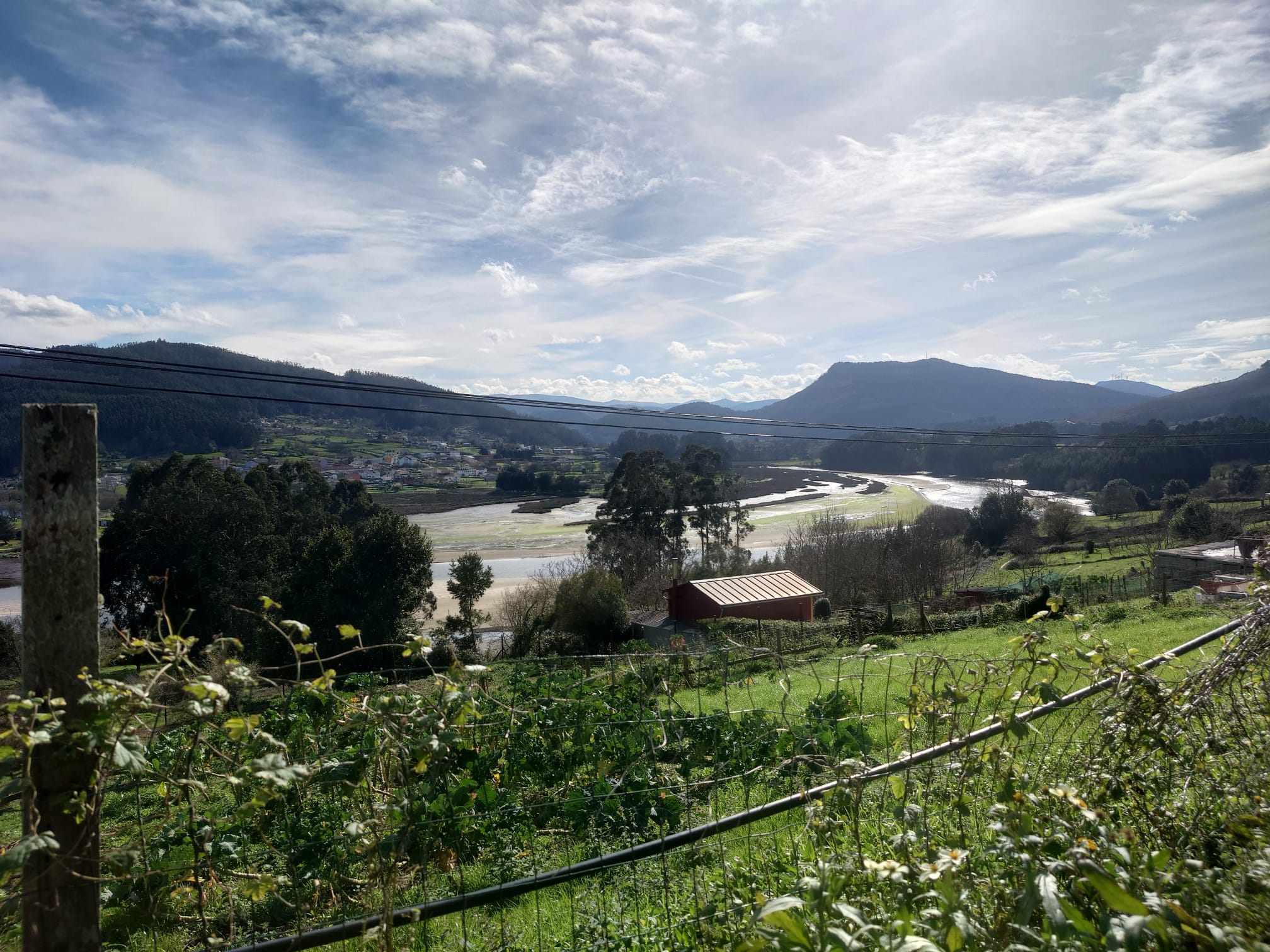
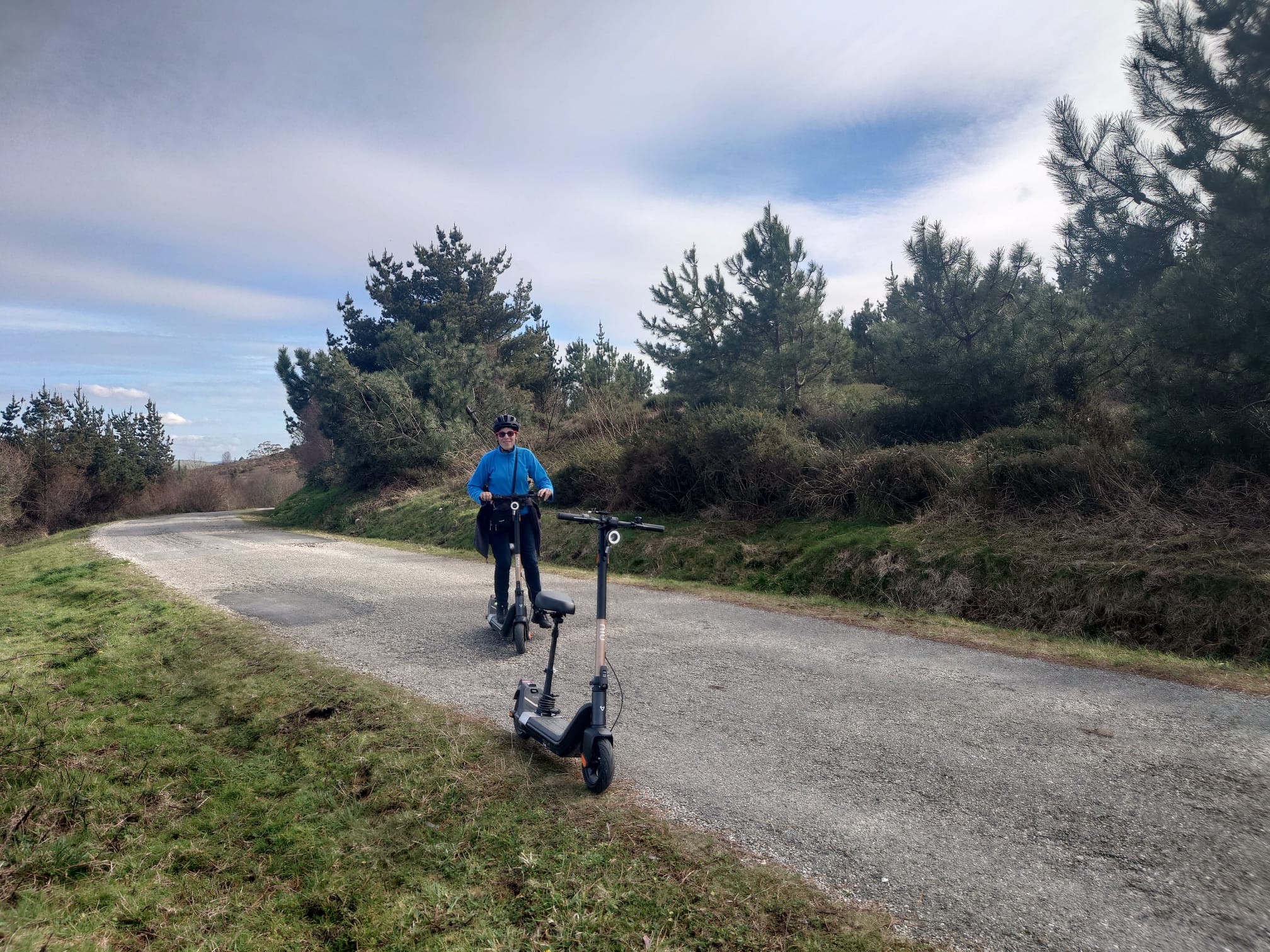
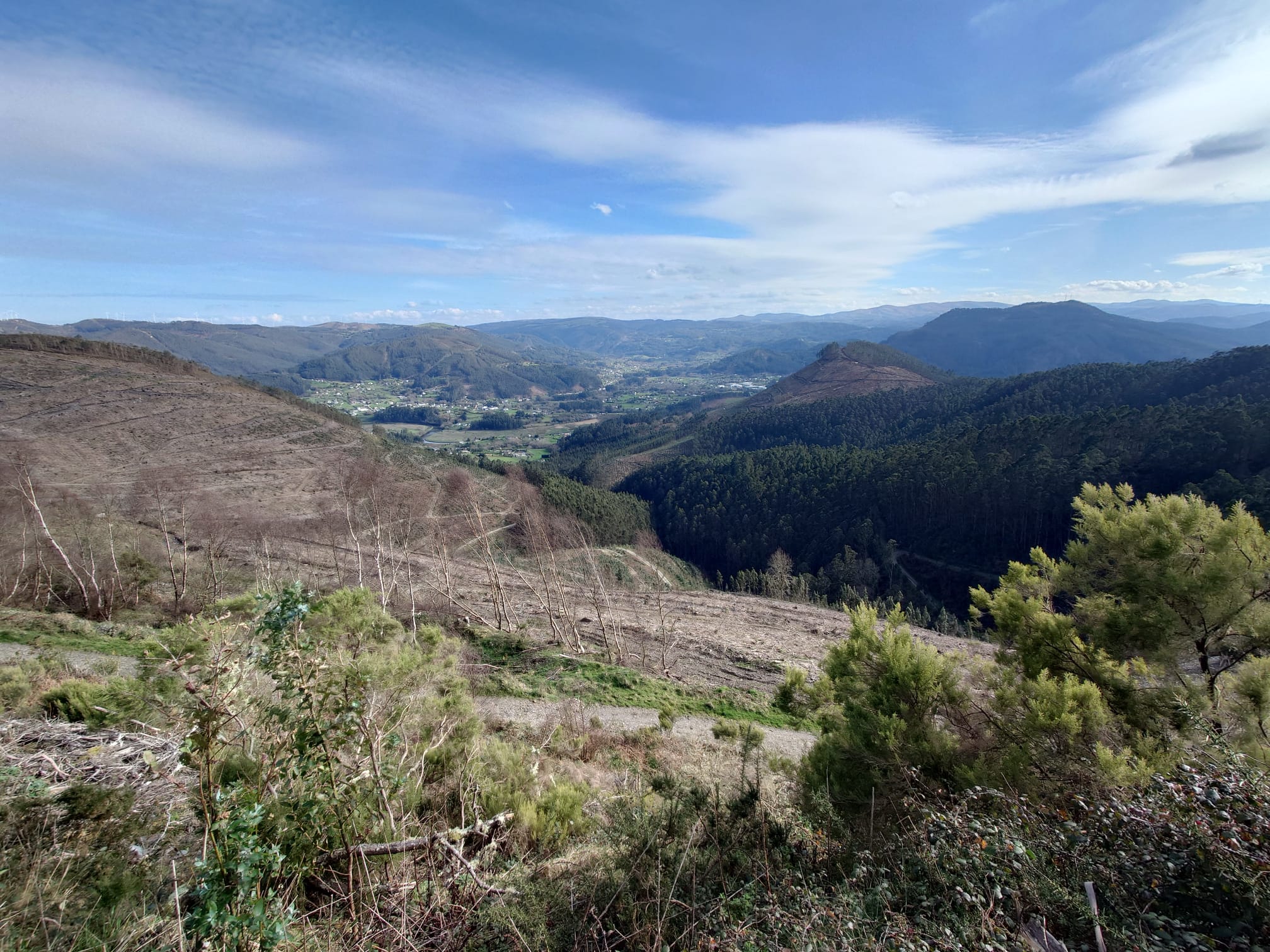
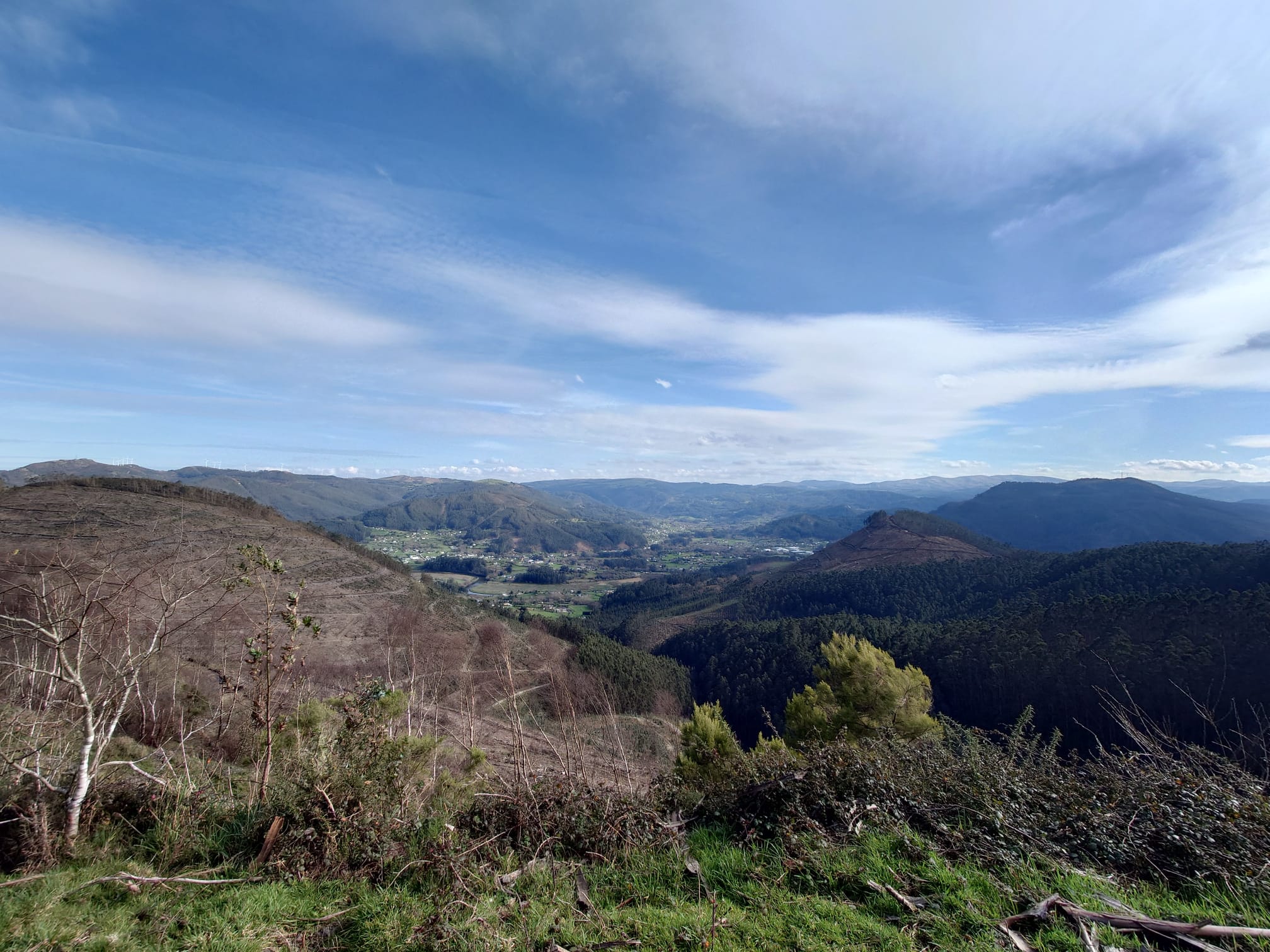

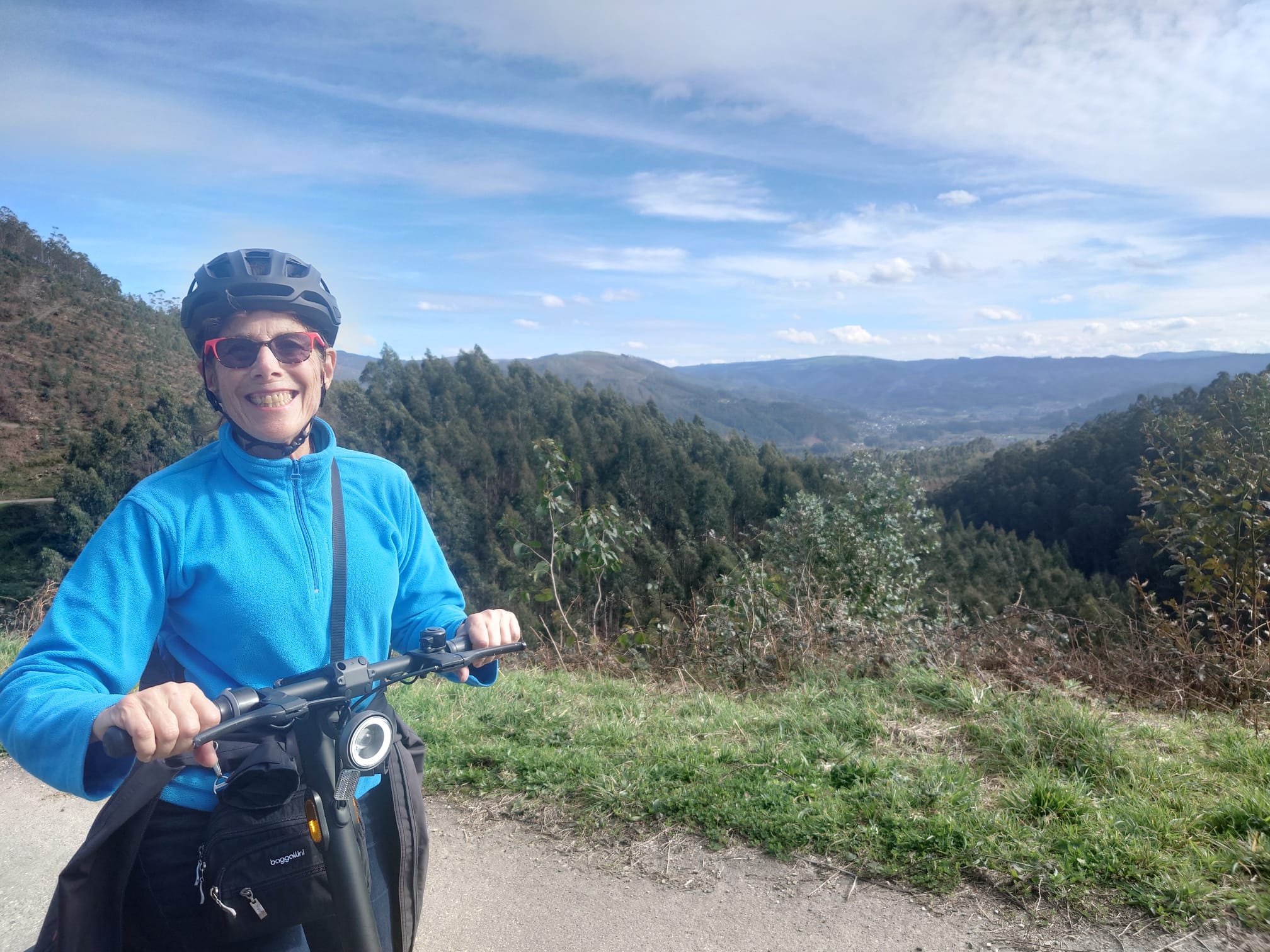
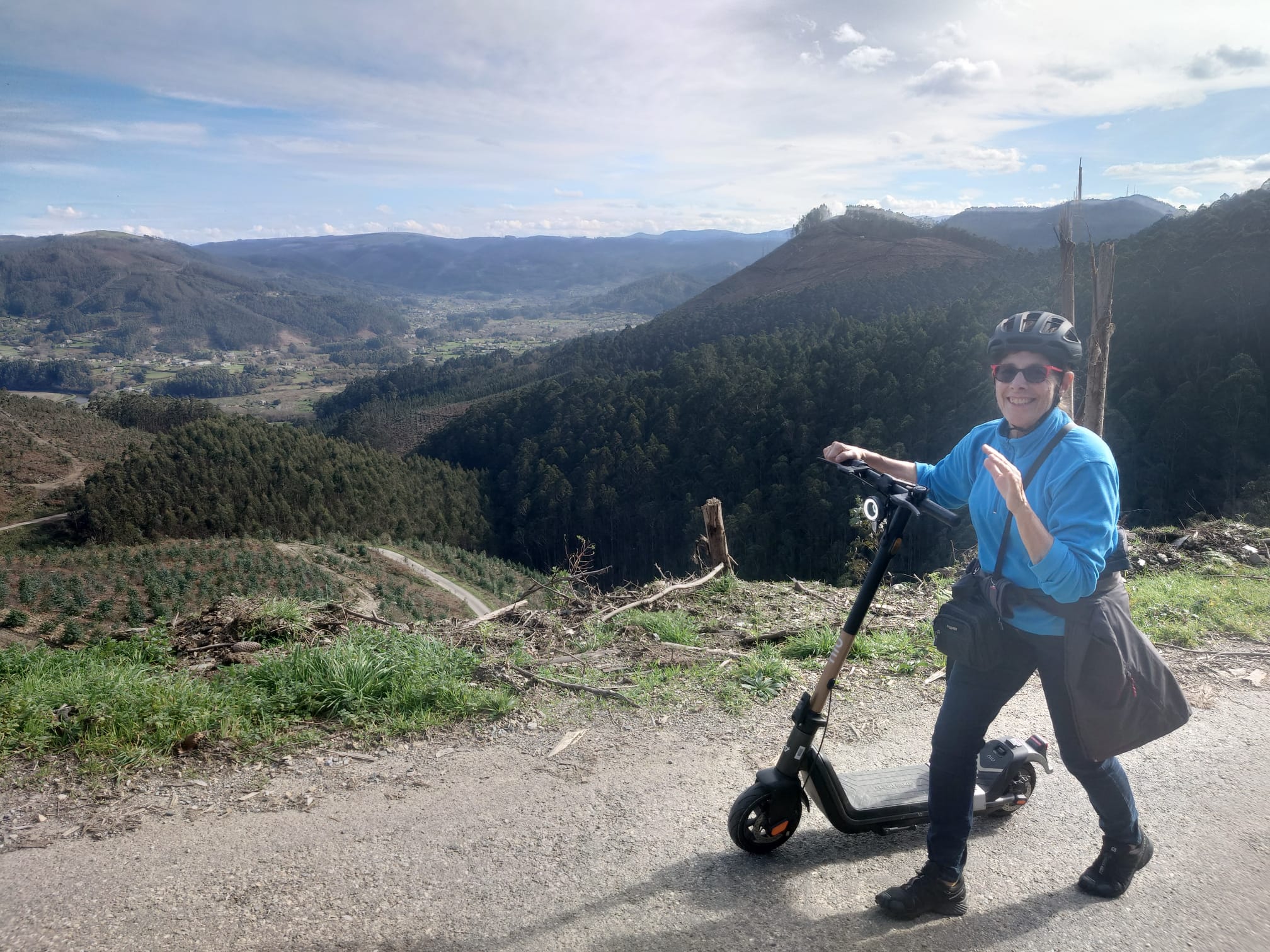
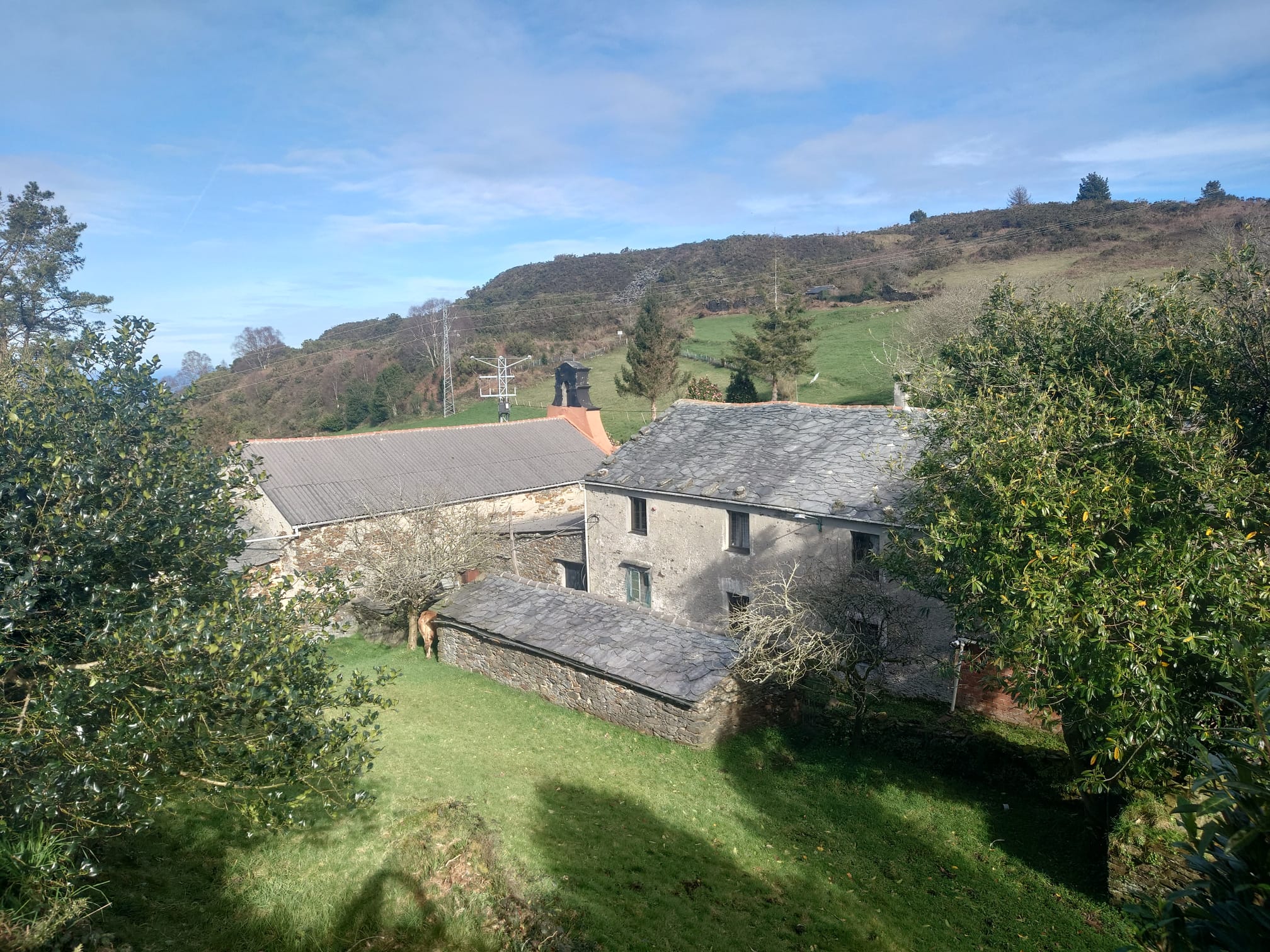
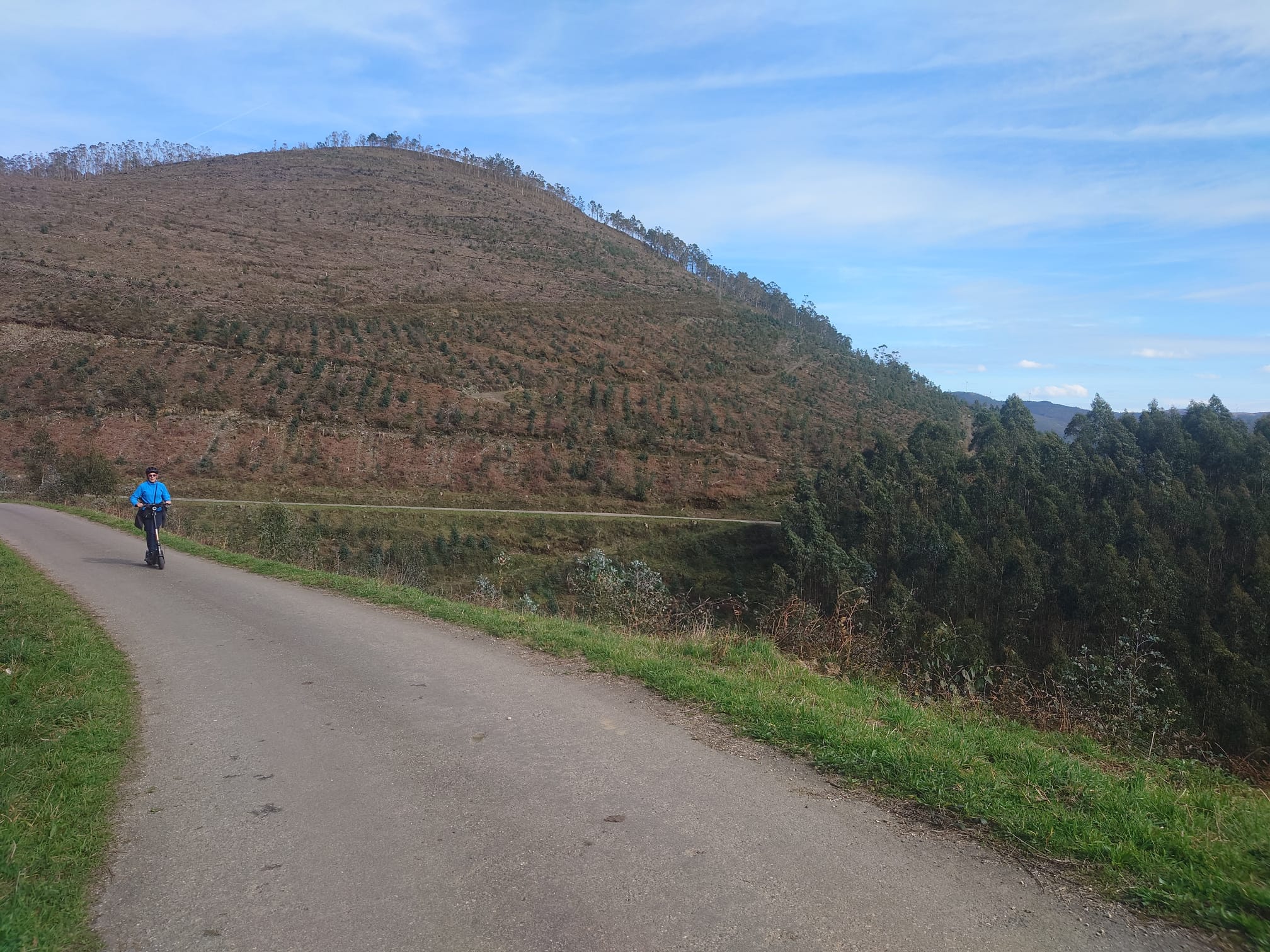
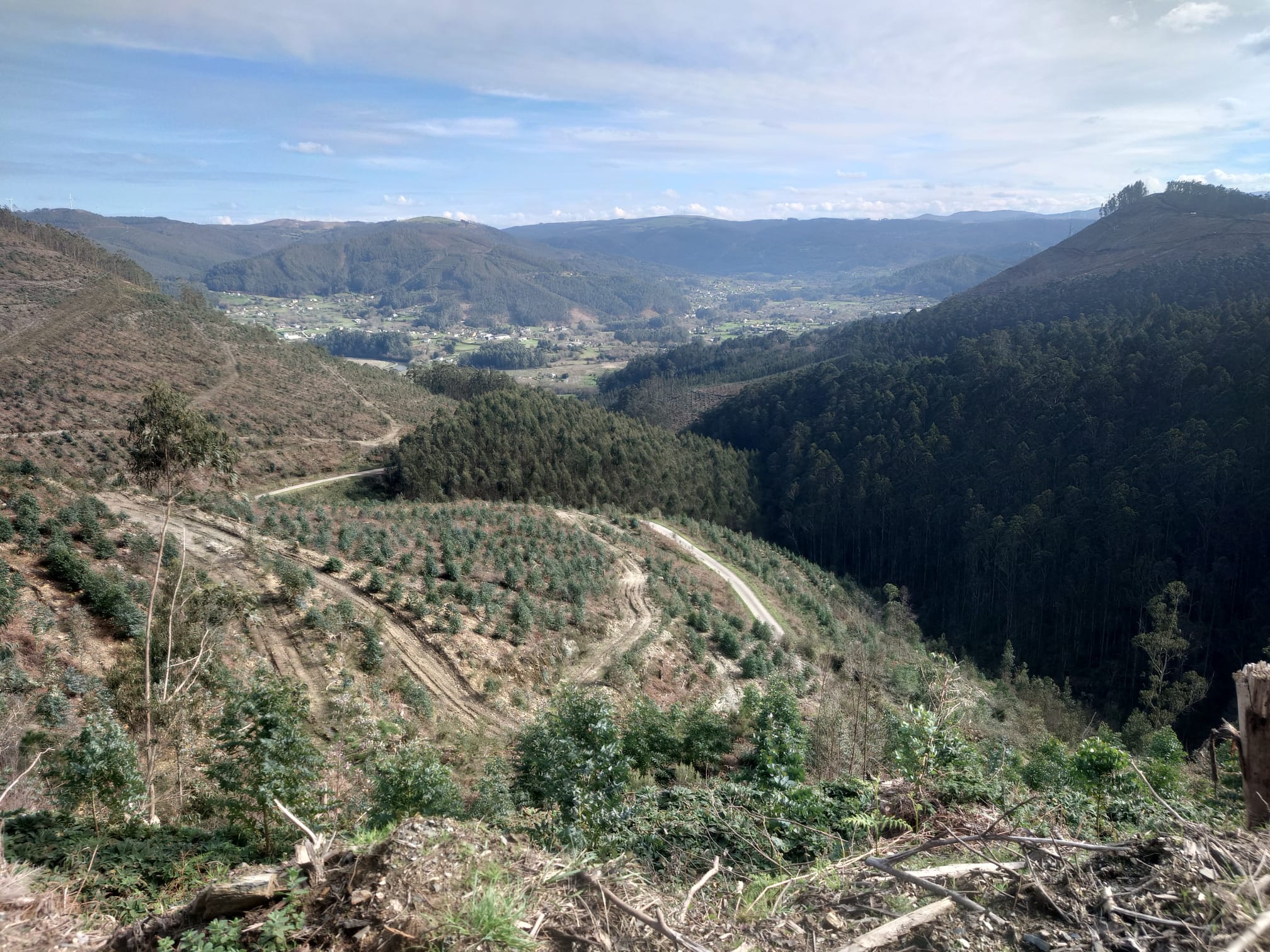
A long downhill track to Viveiro:
When we get to the marina, some packages from Amazon have arrived… some electronics for Wim’s experiment with external batteries for the scooters. And so begins project “Super Scooters”, hopefully taking us further than our scooters have ever gone before! Stay tuned for the upcoming post, with details!
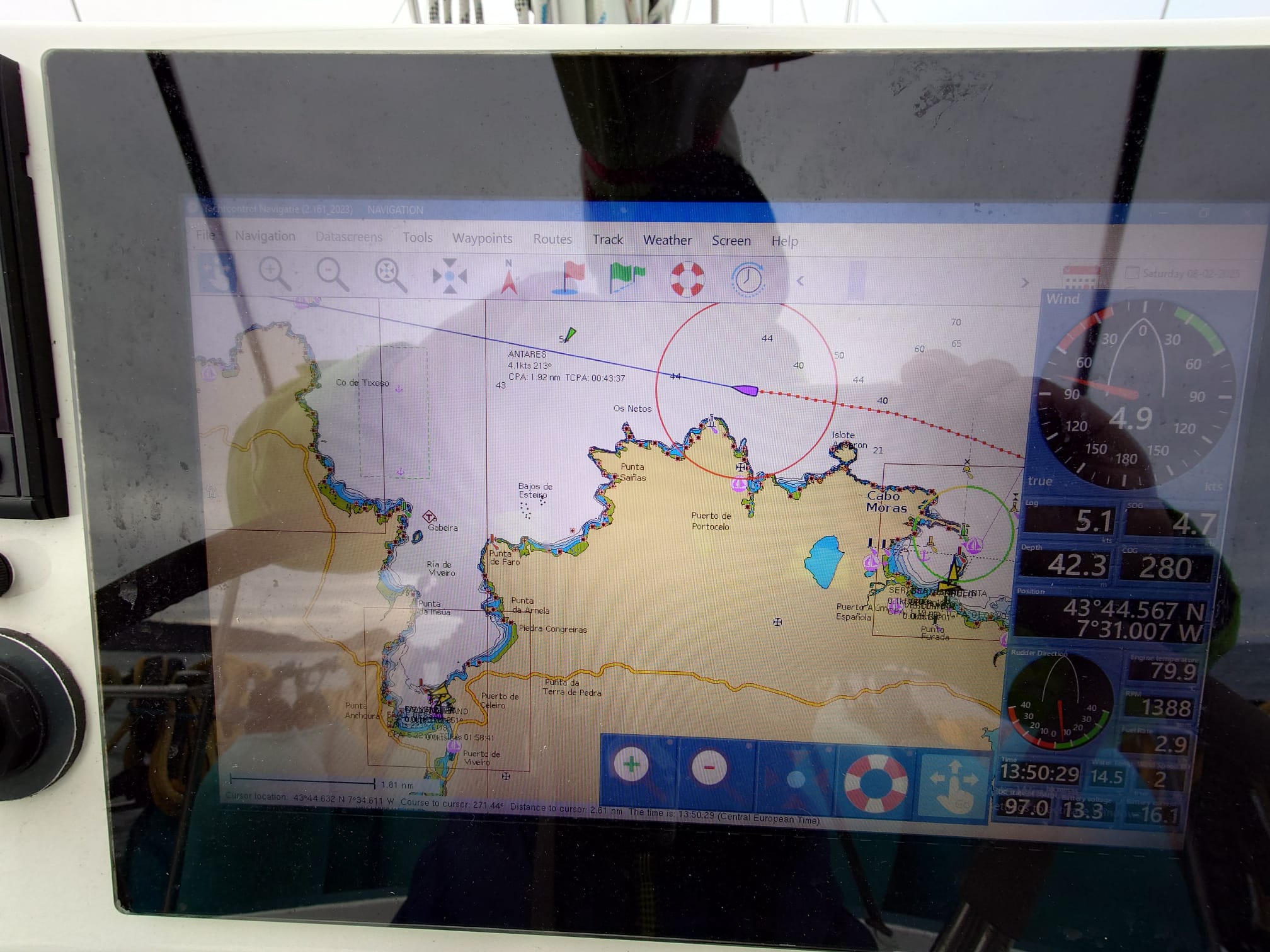

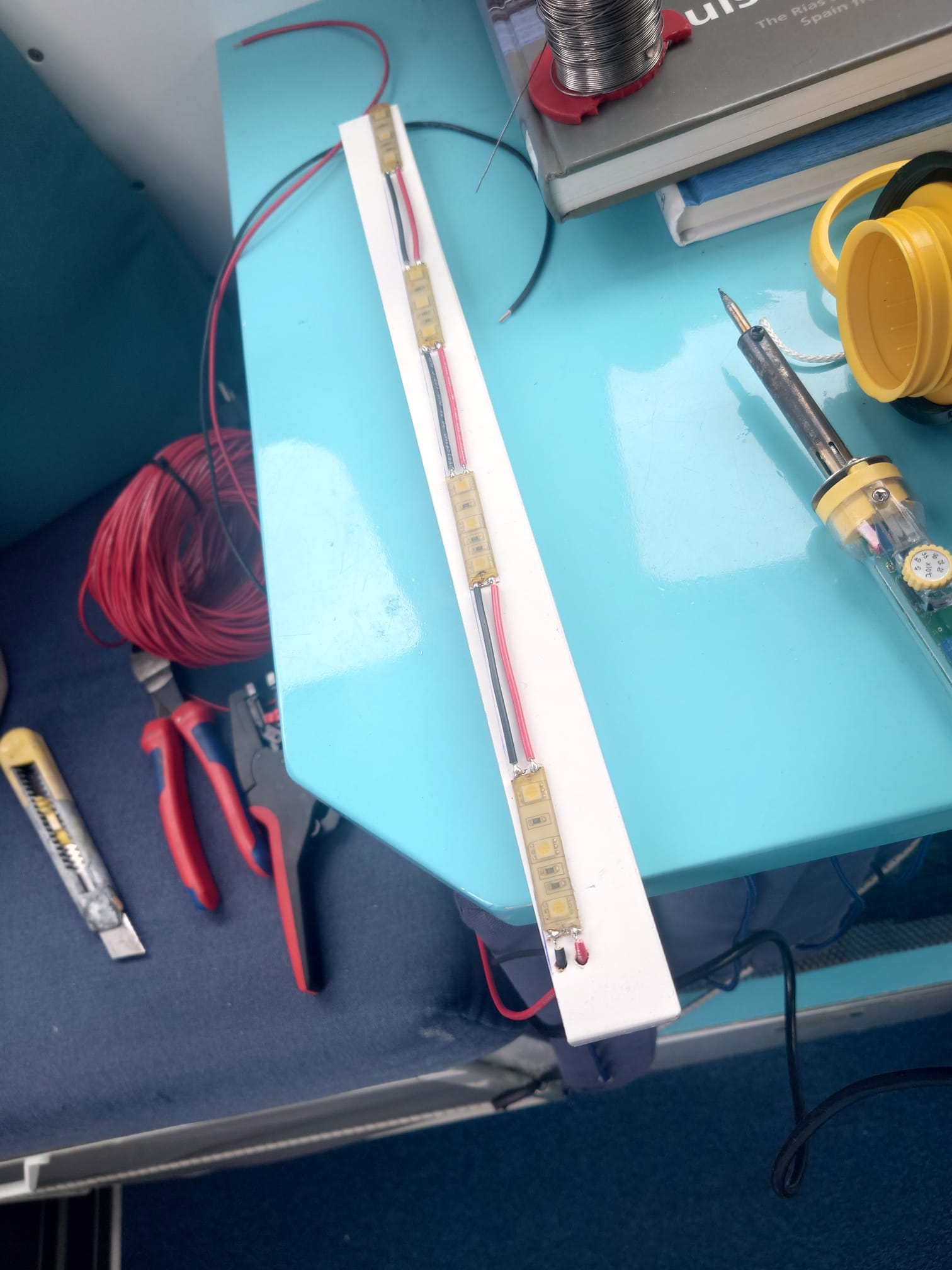

Leave a Reply